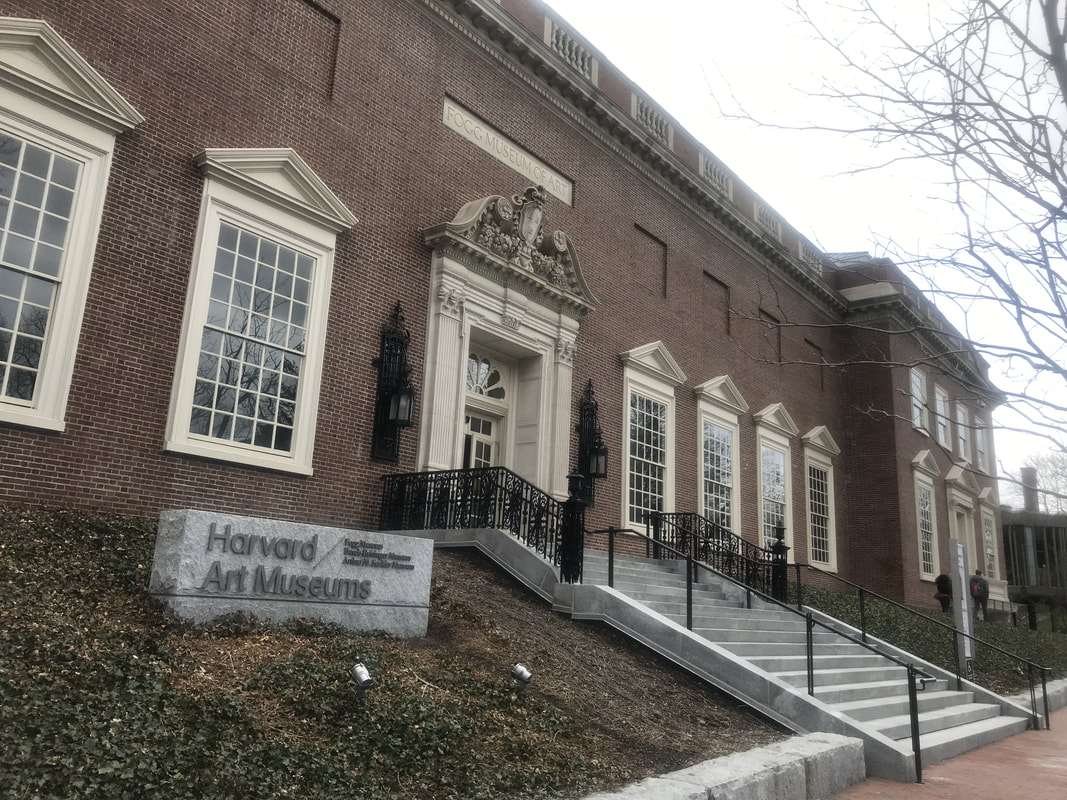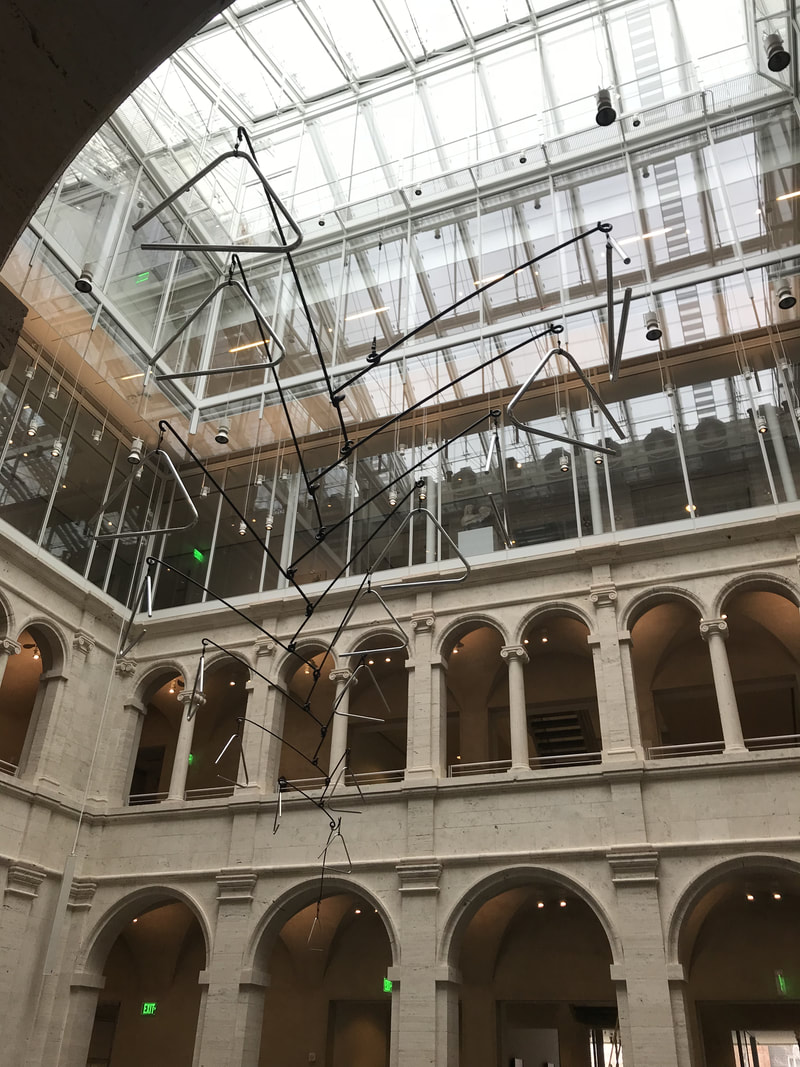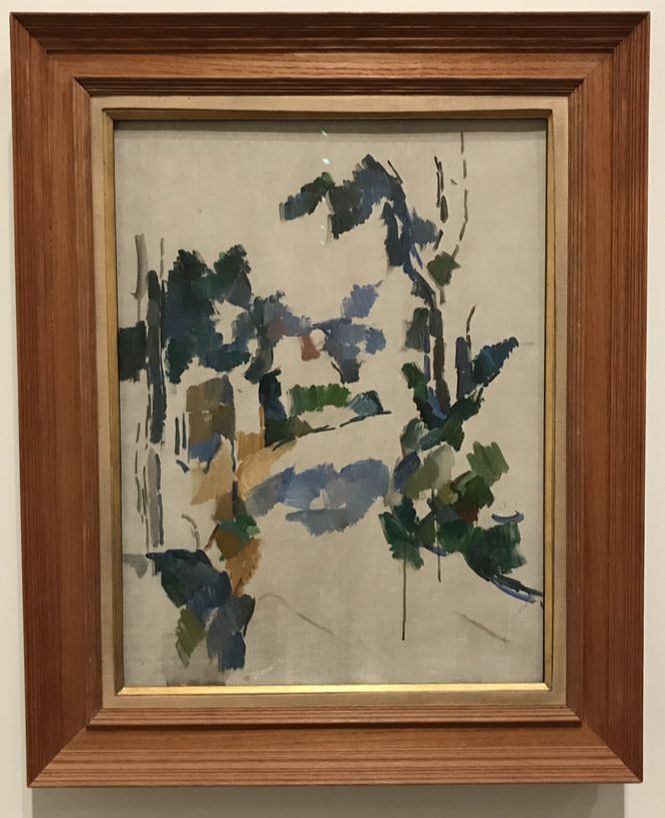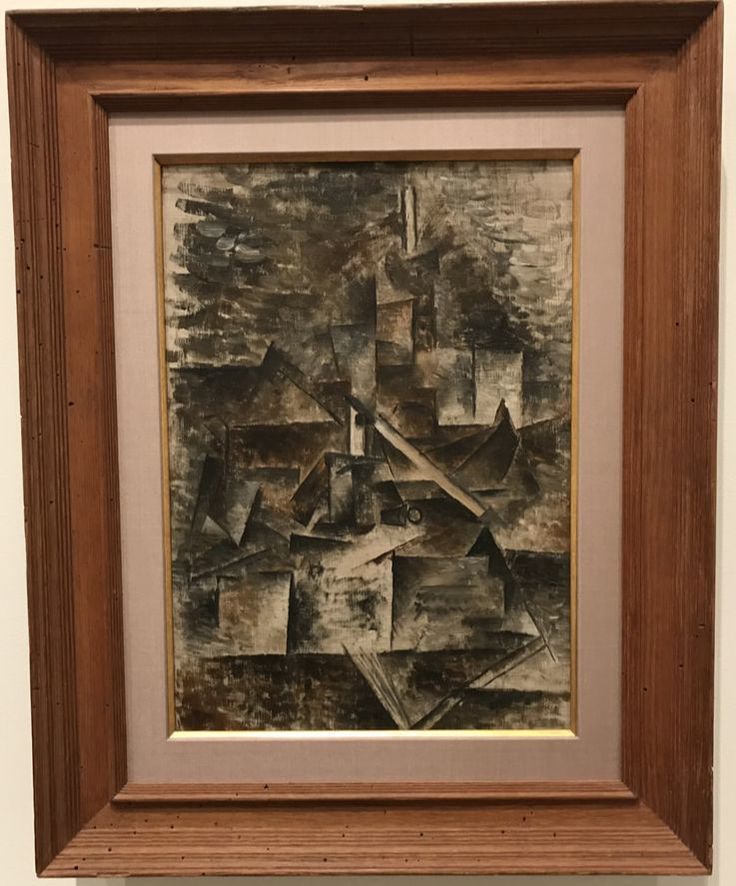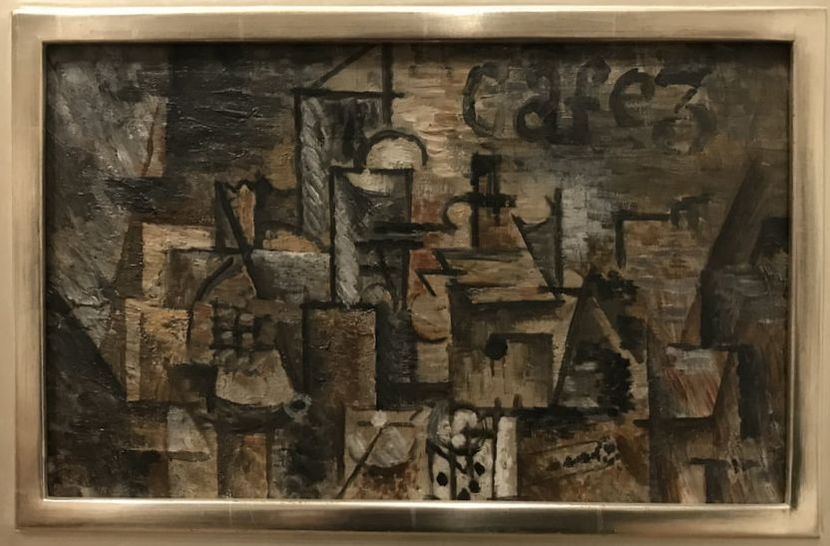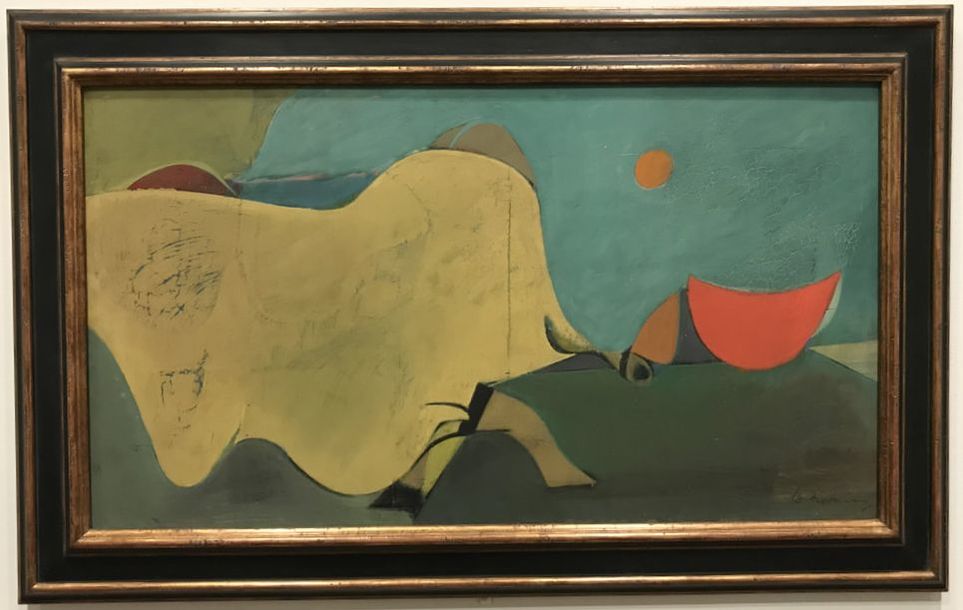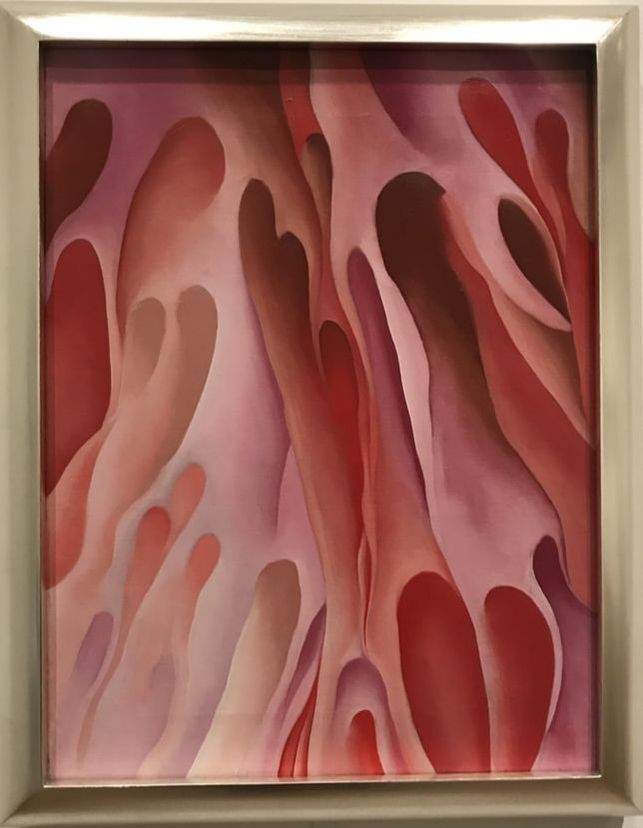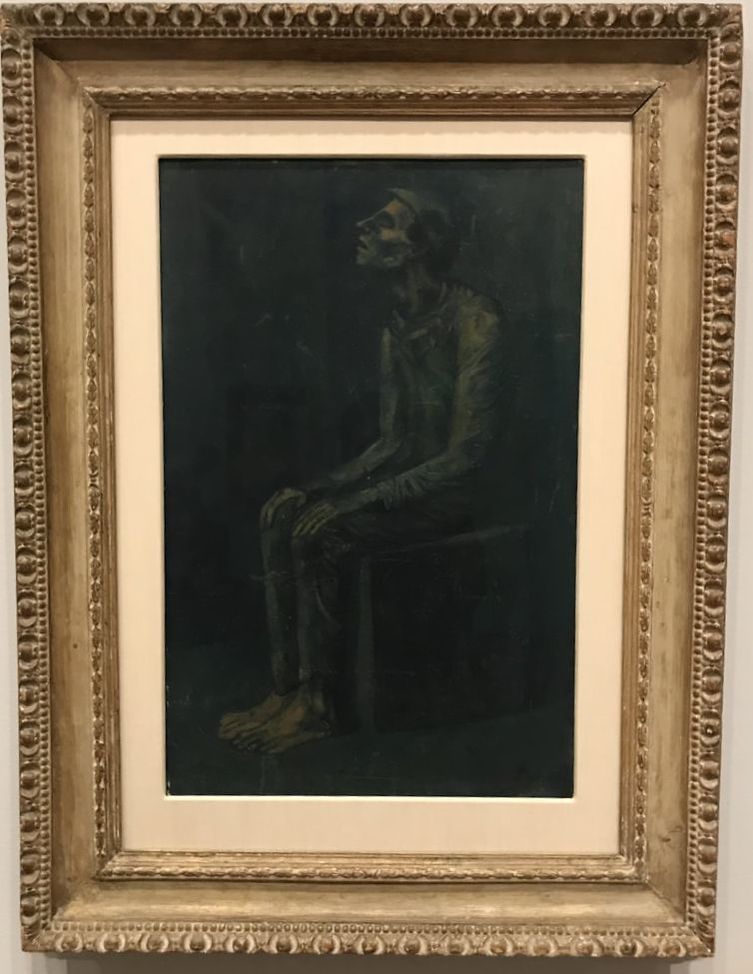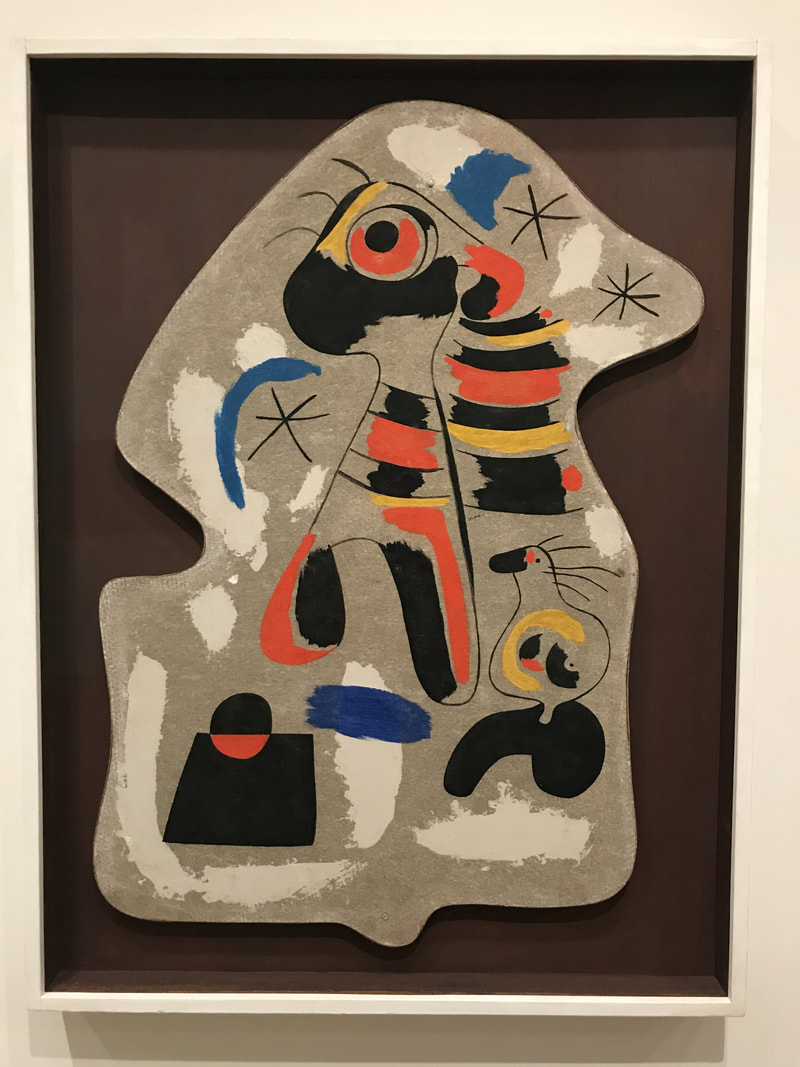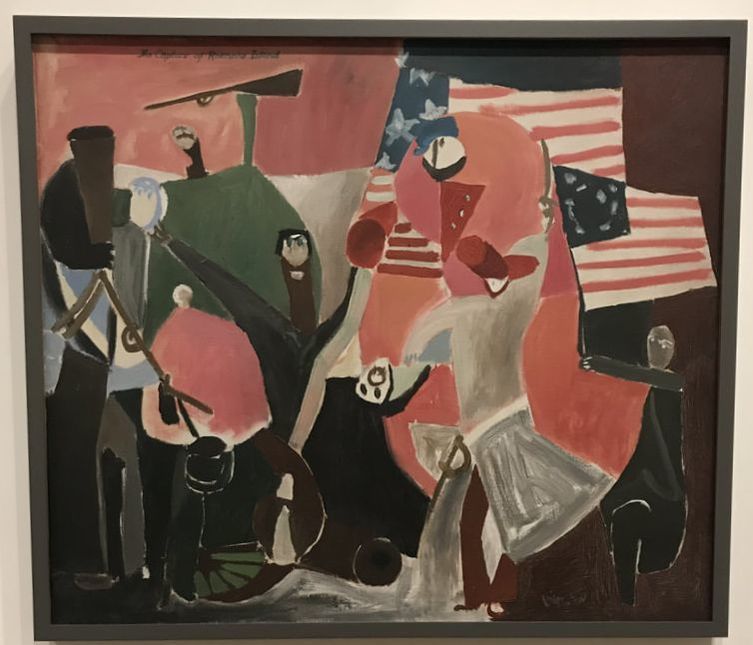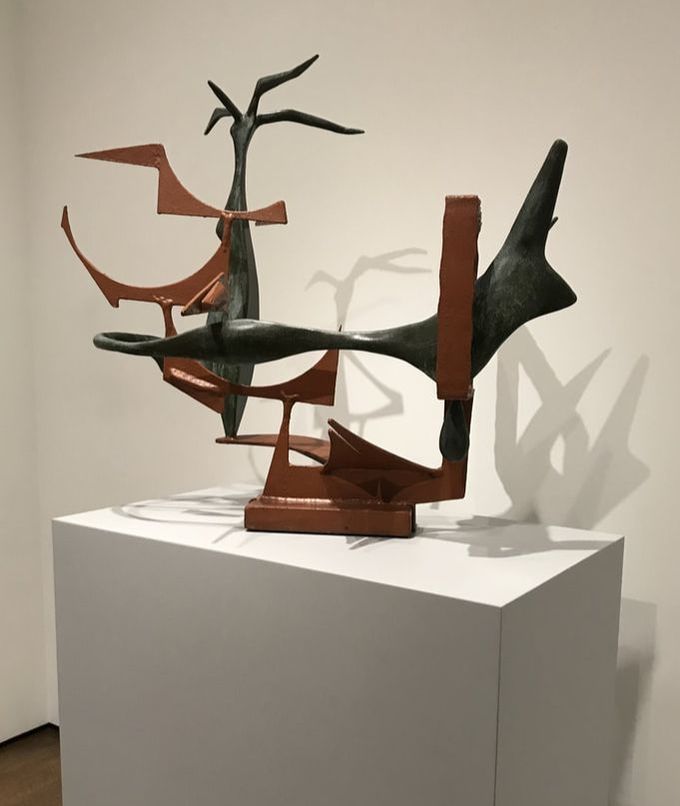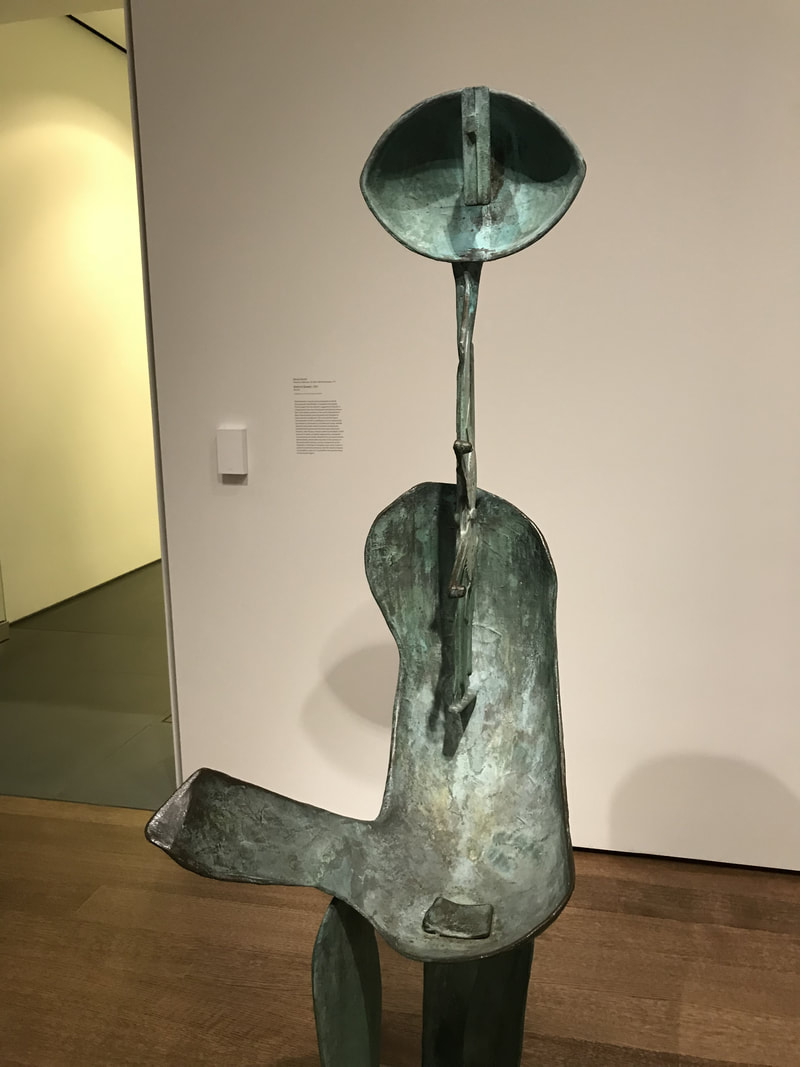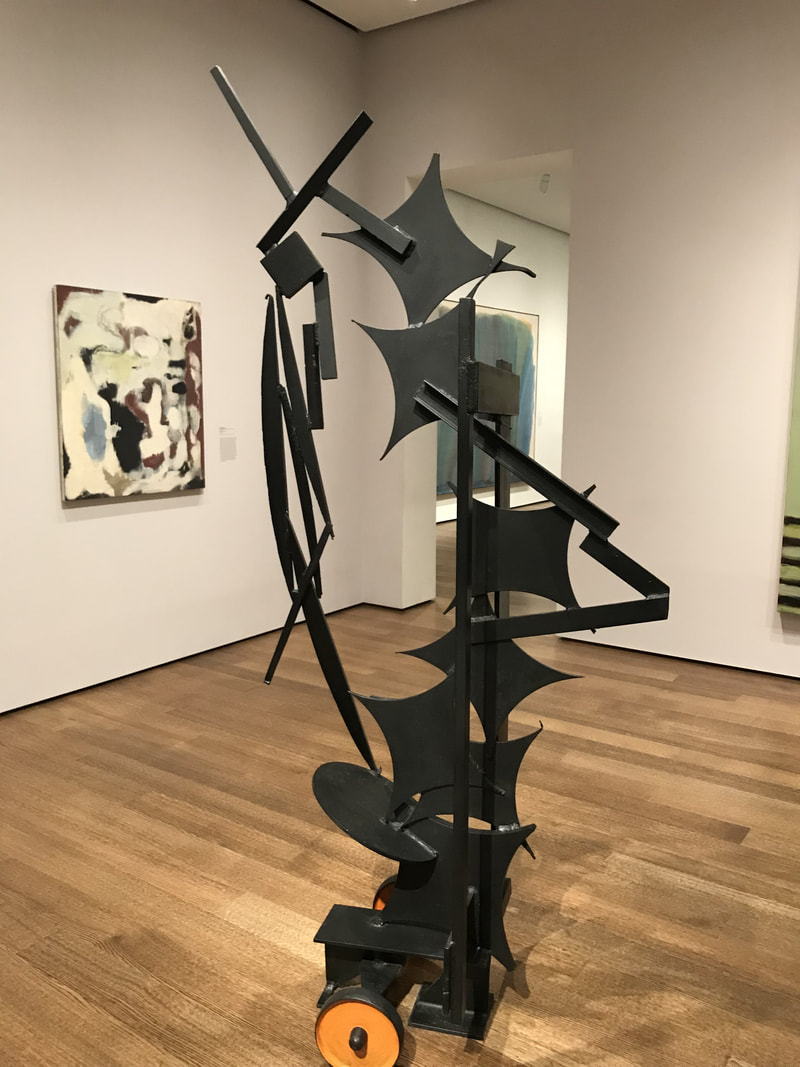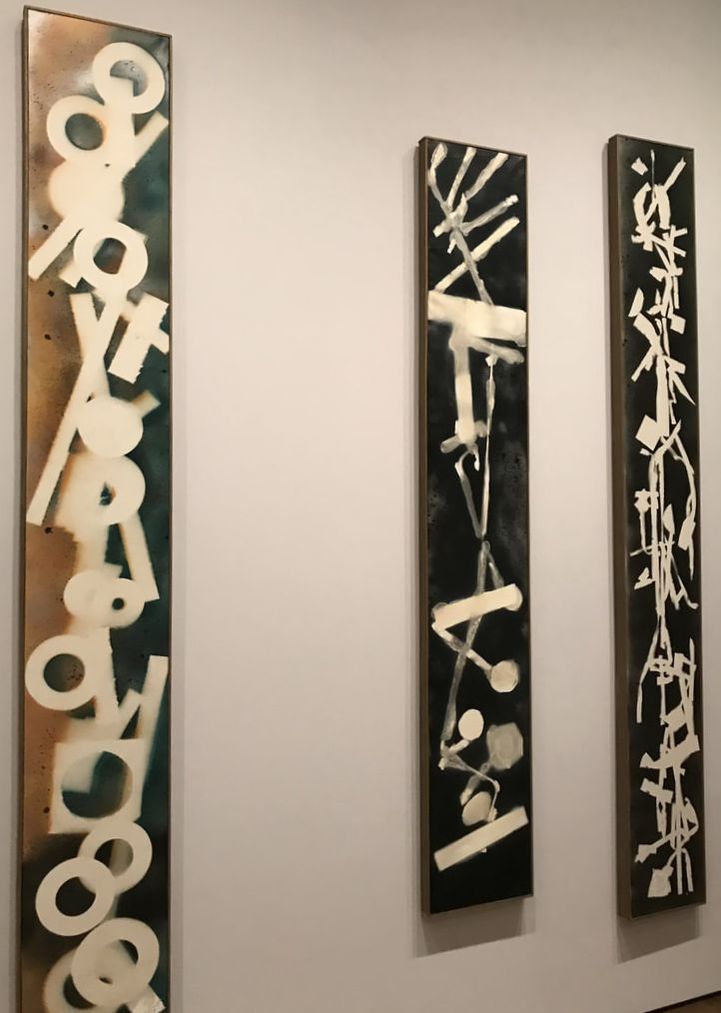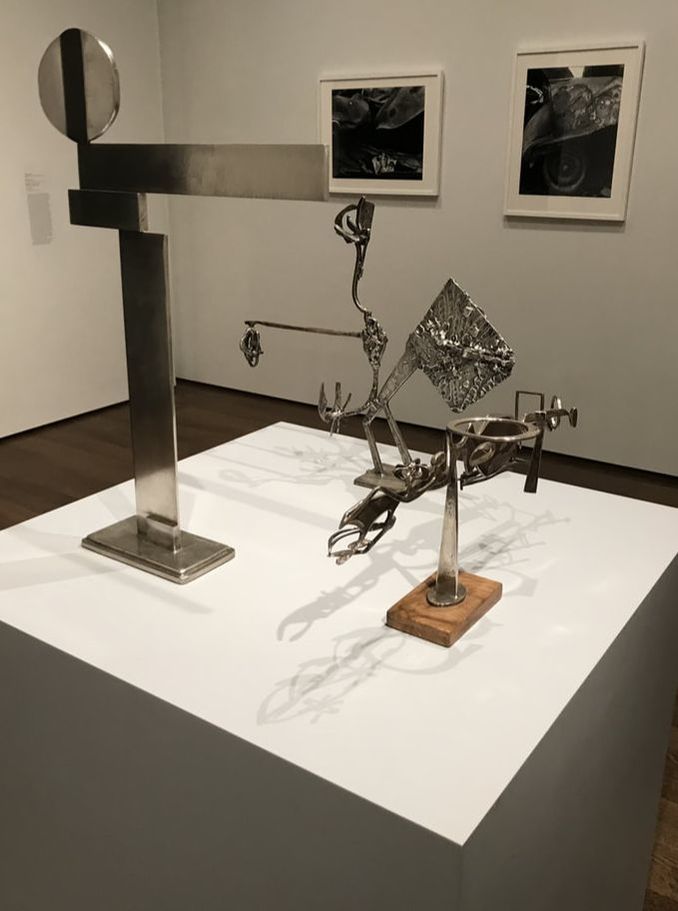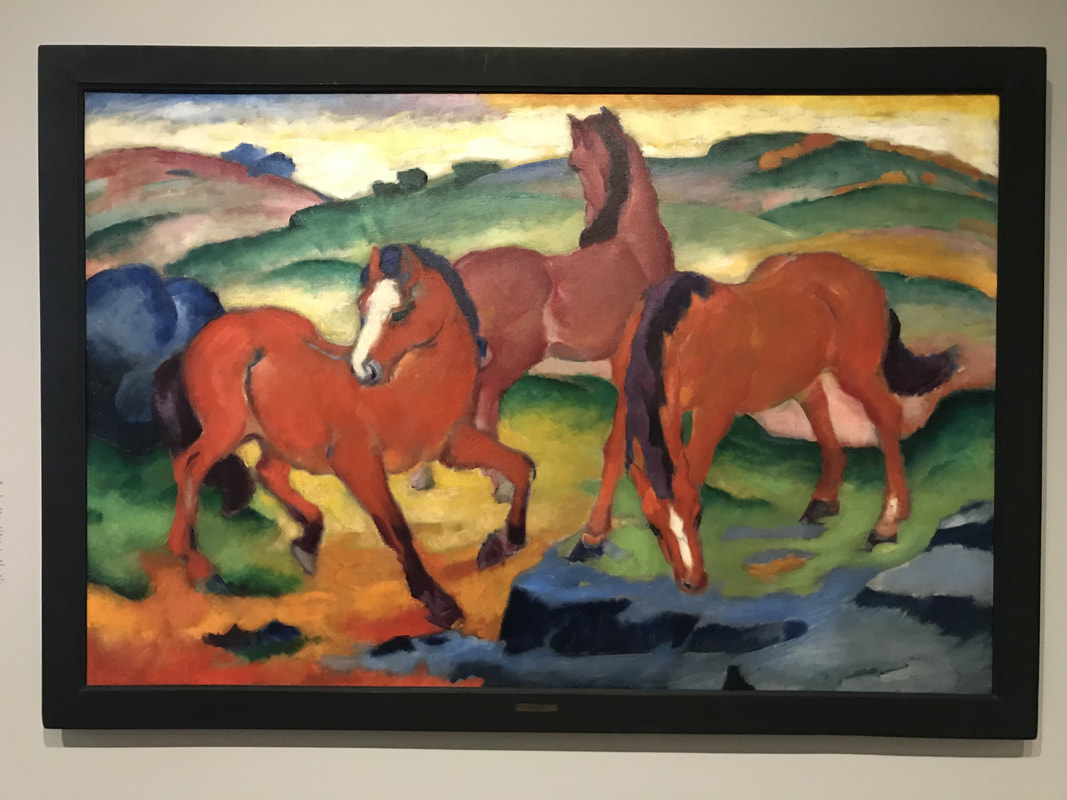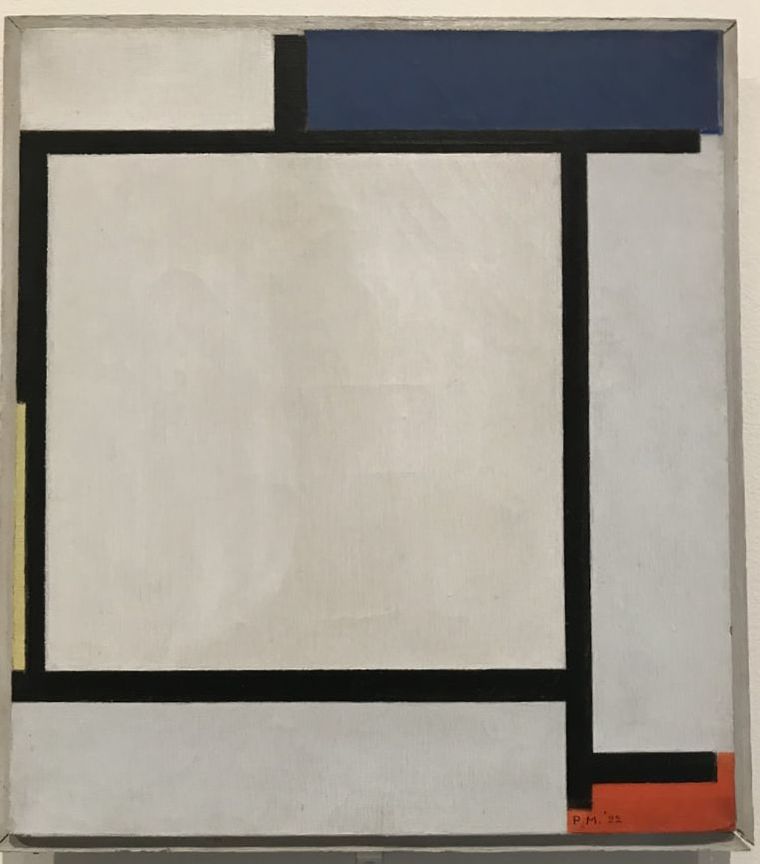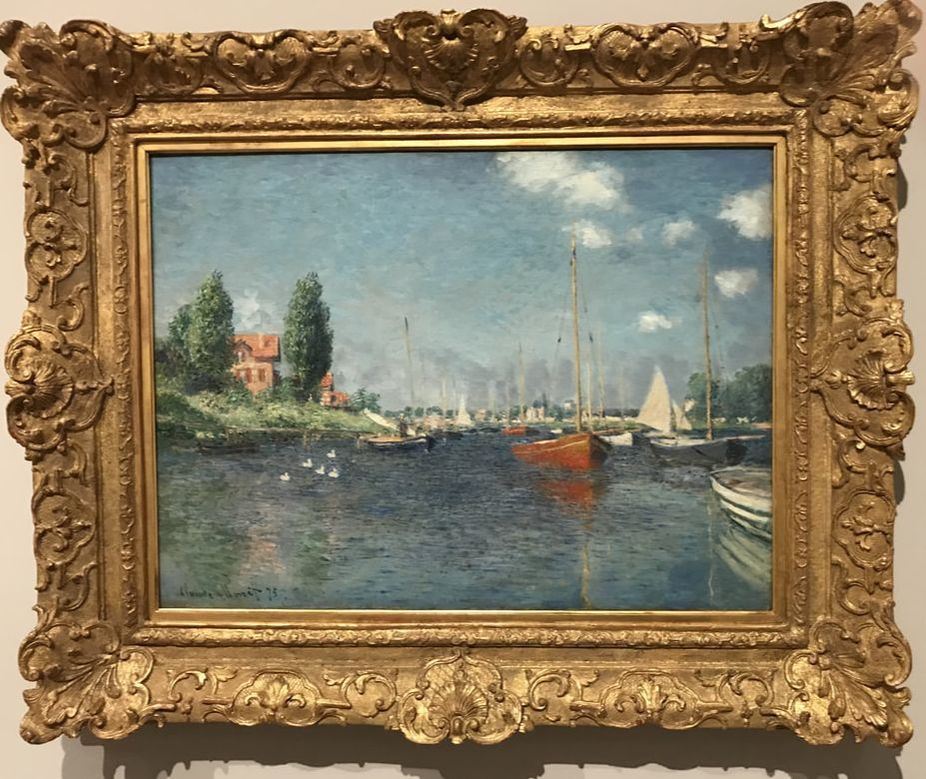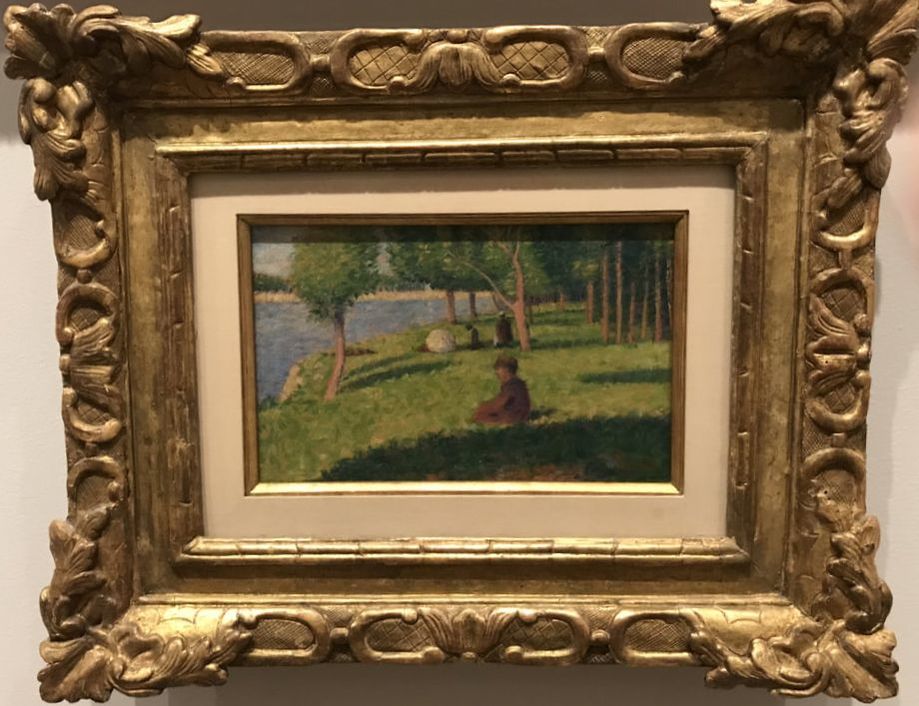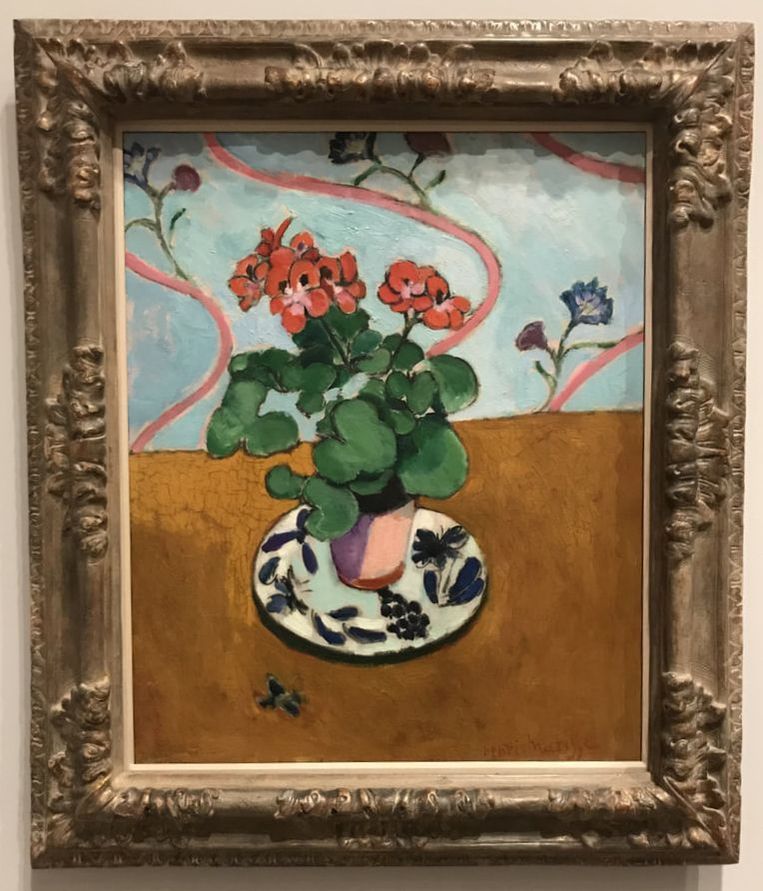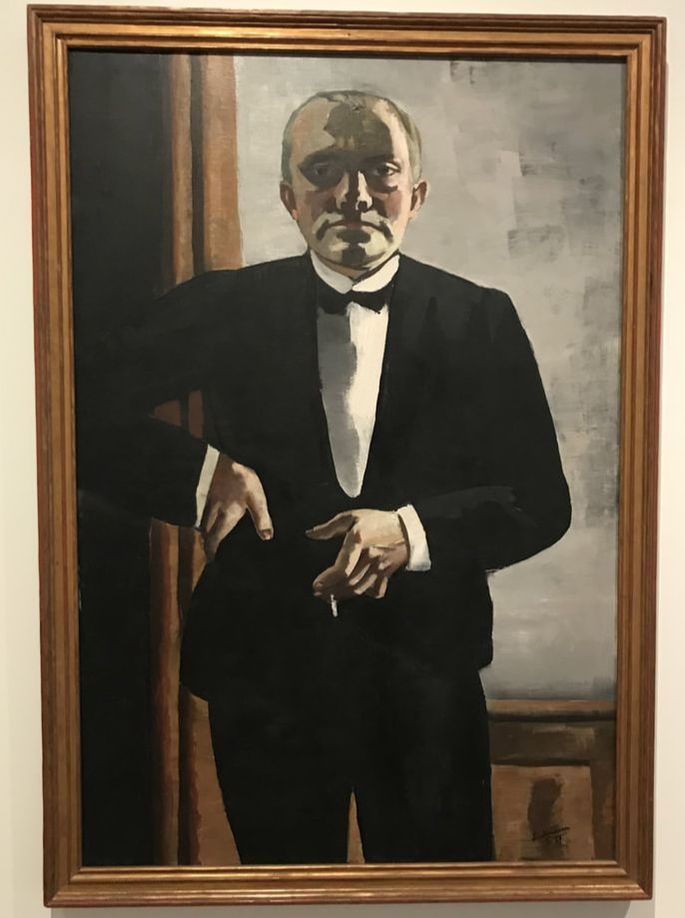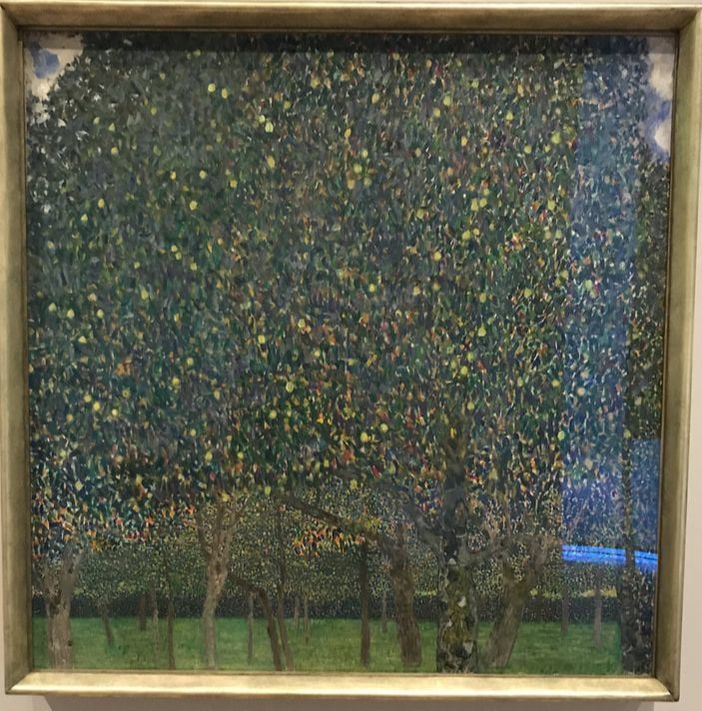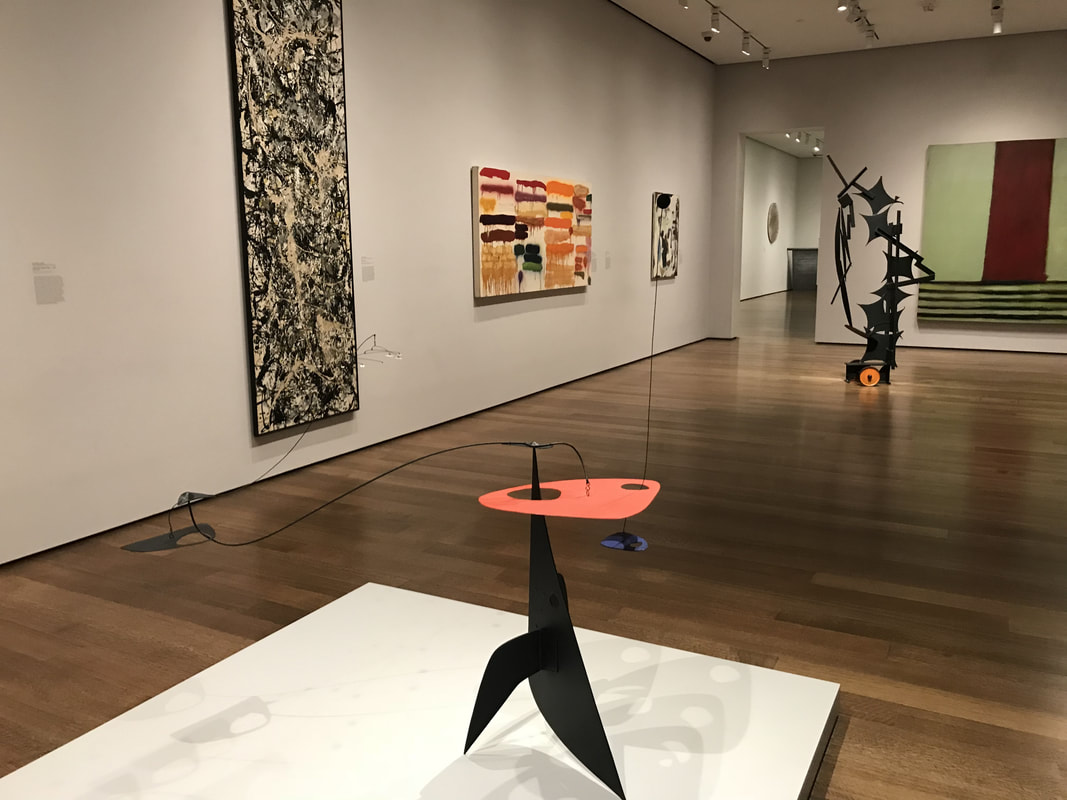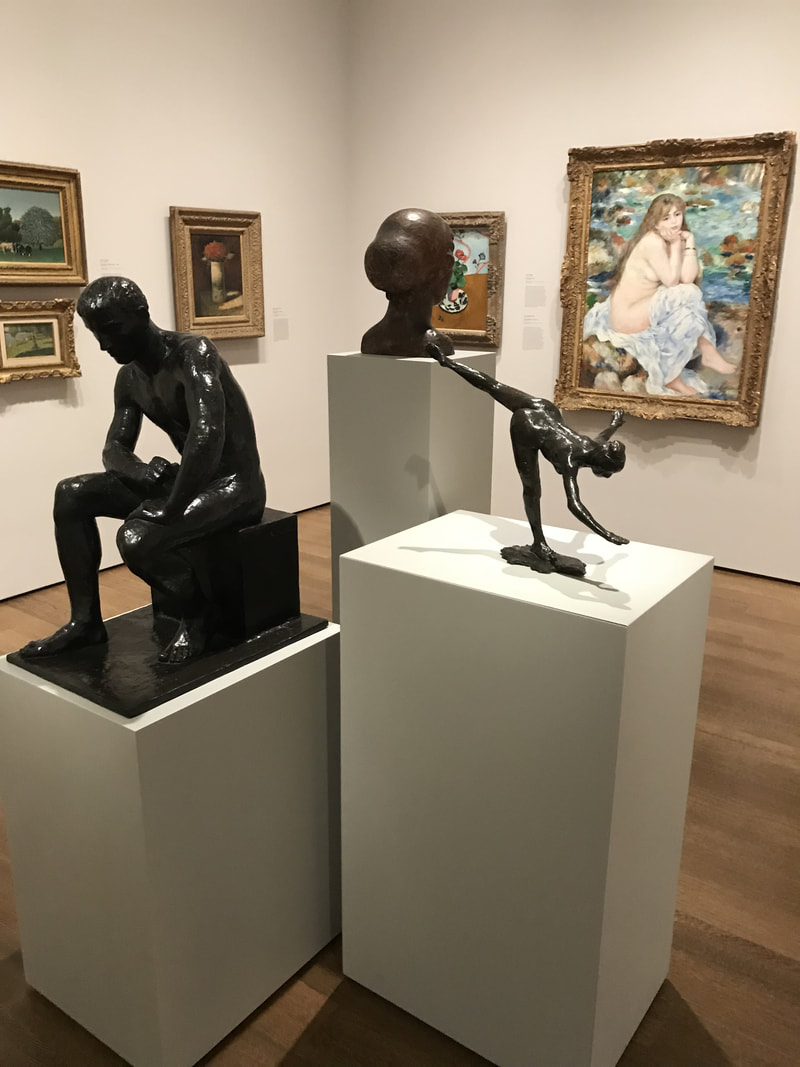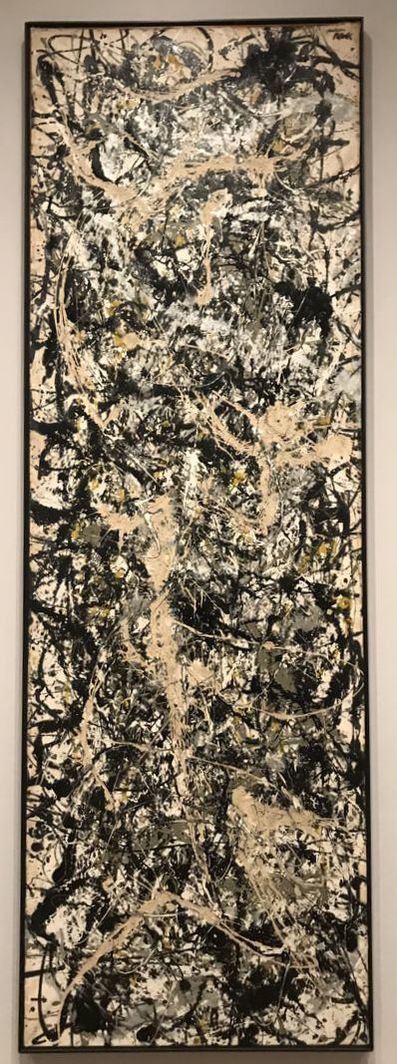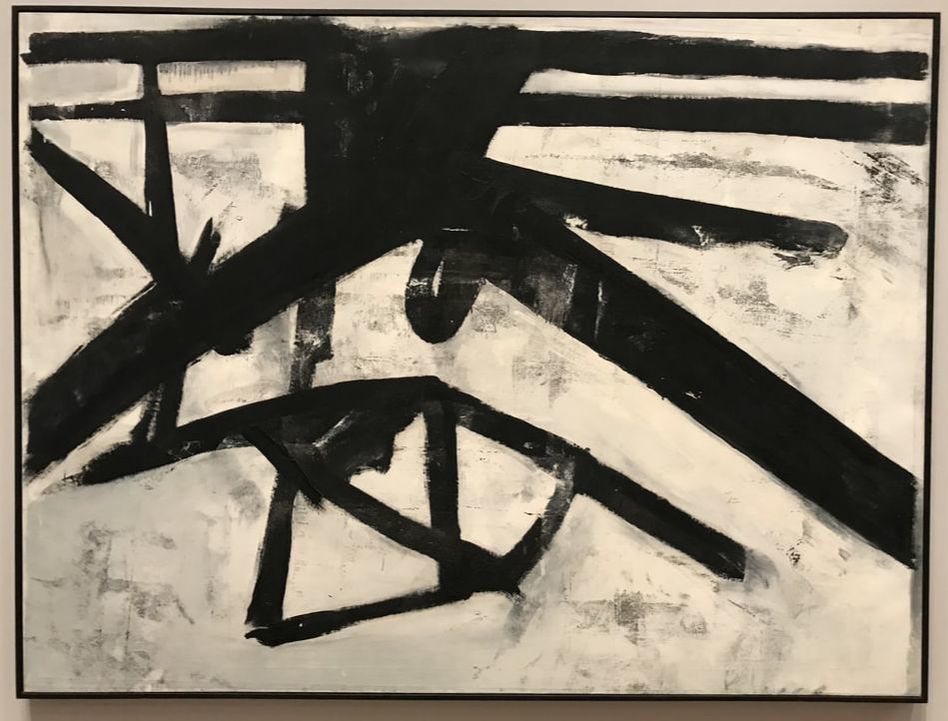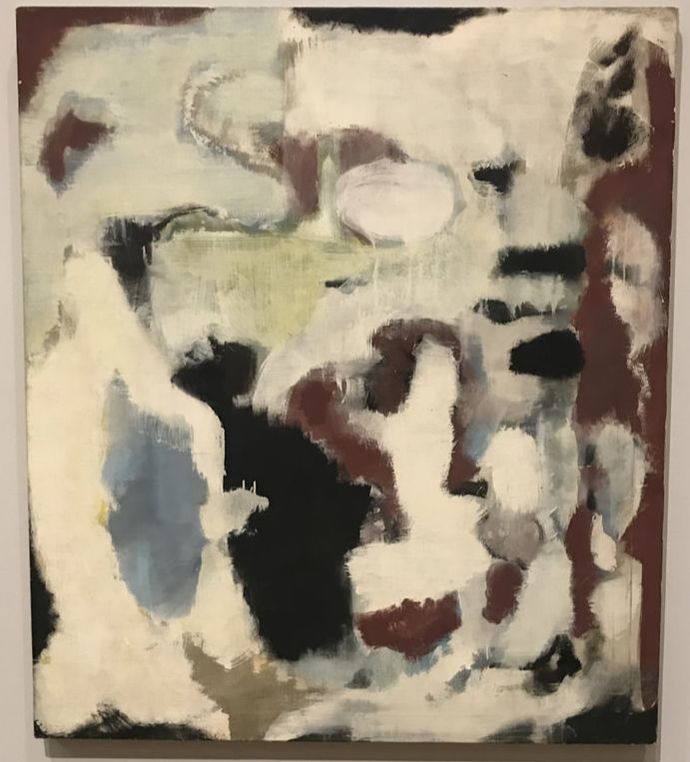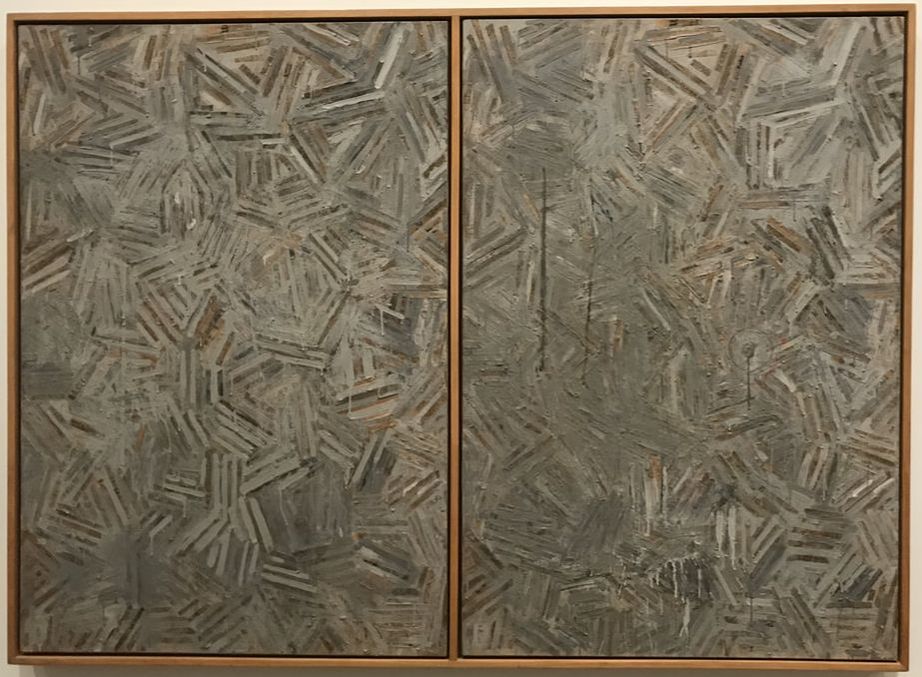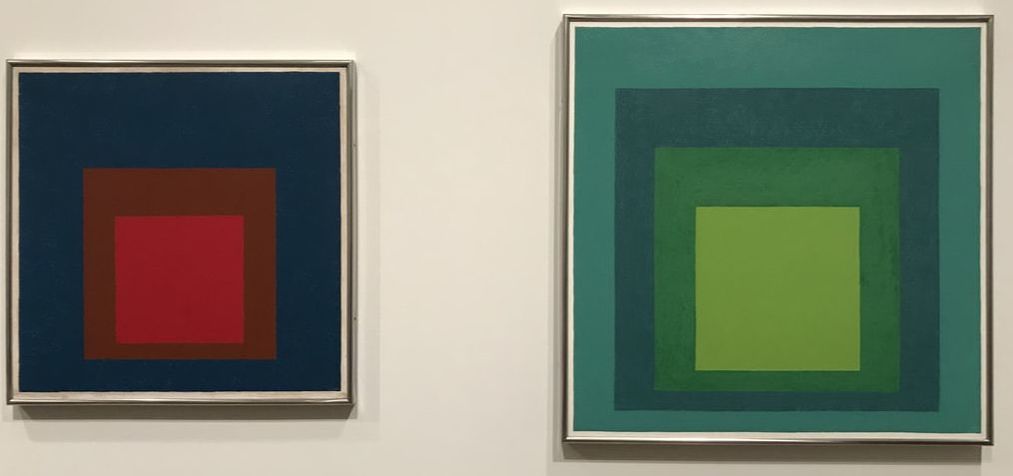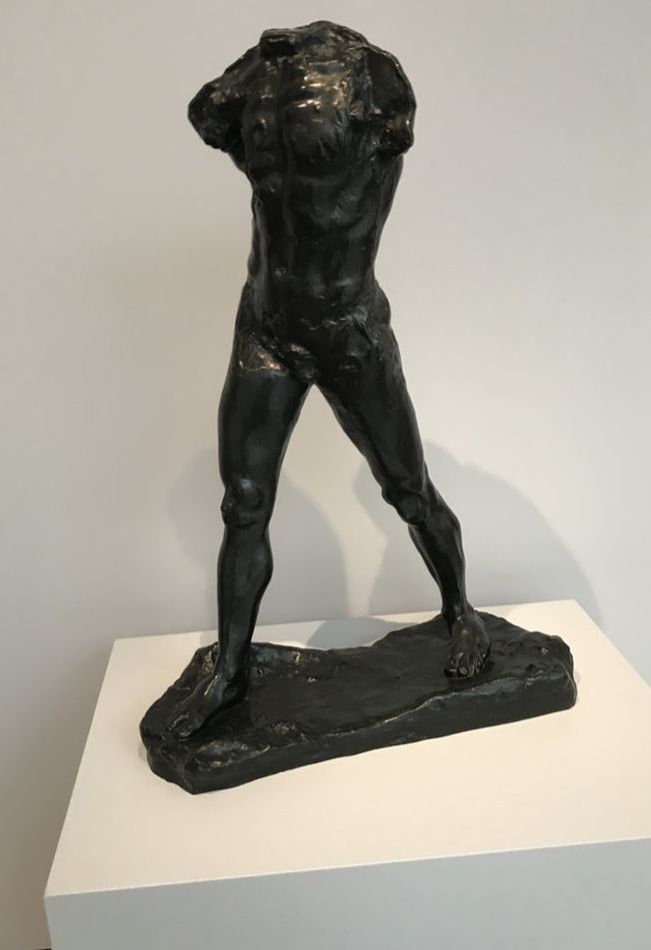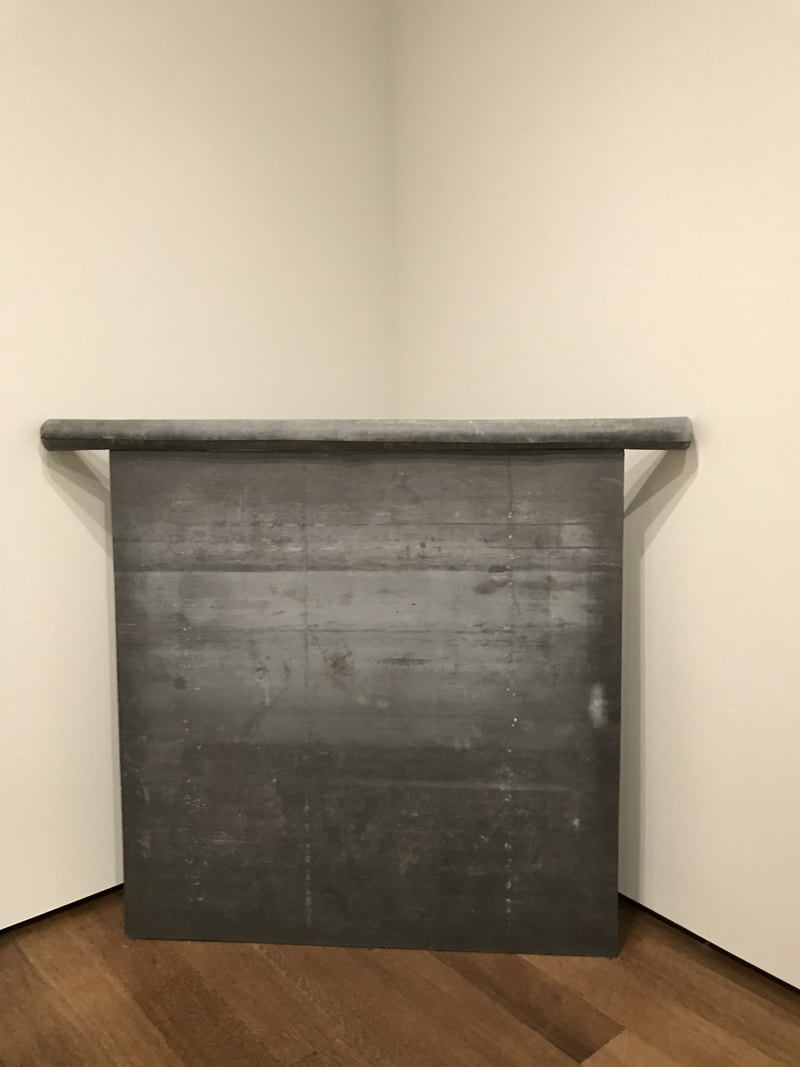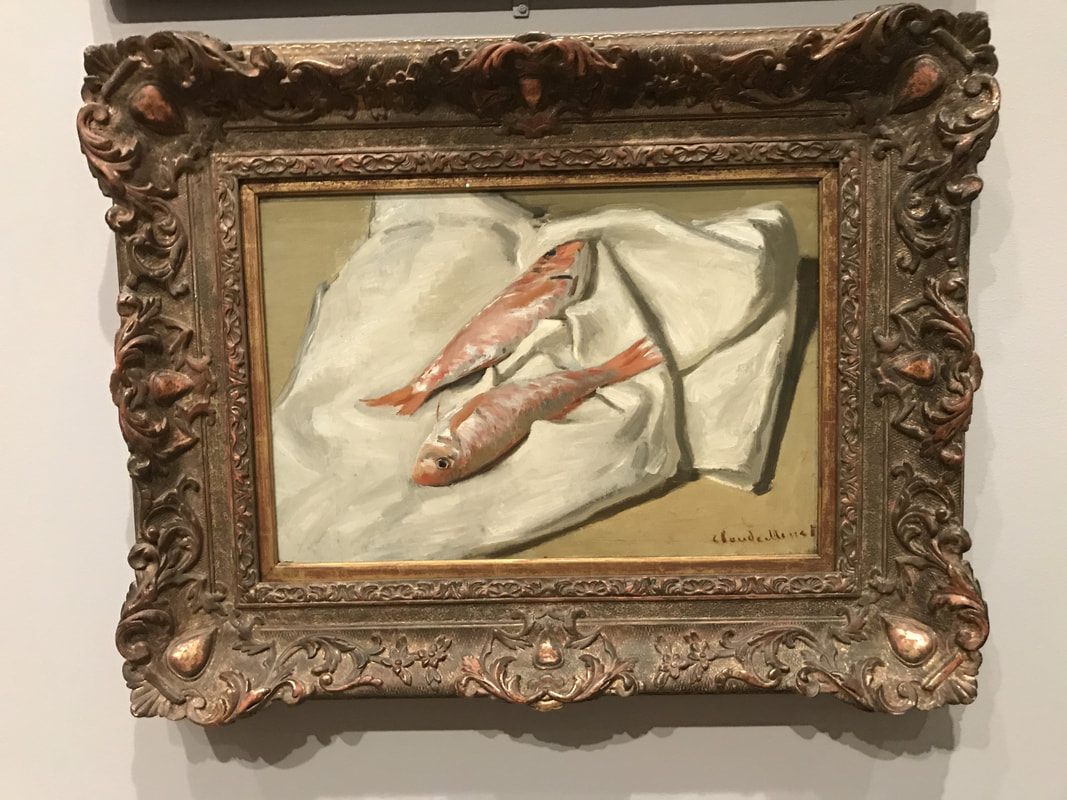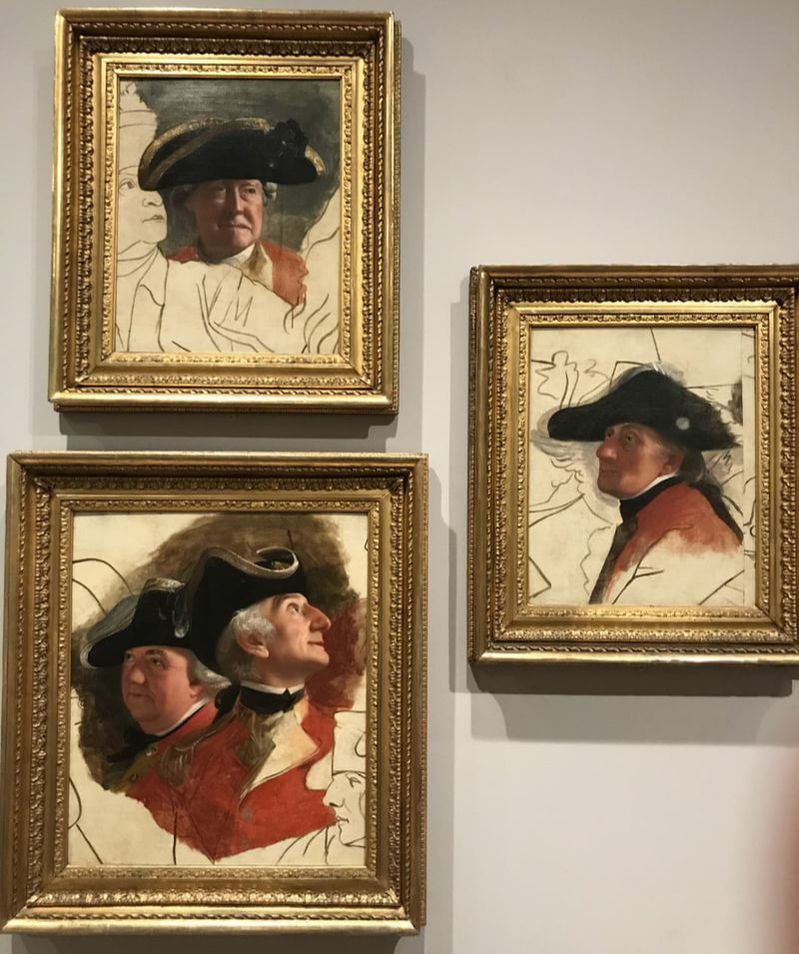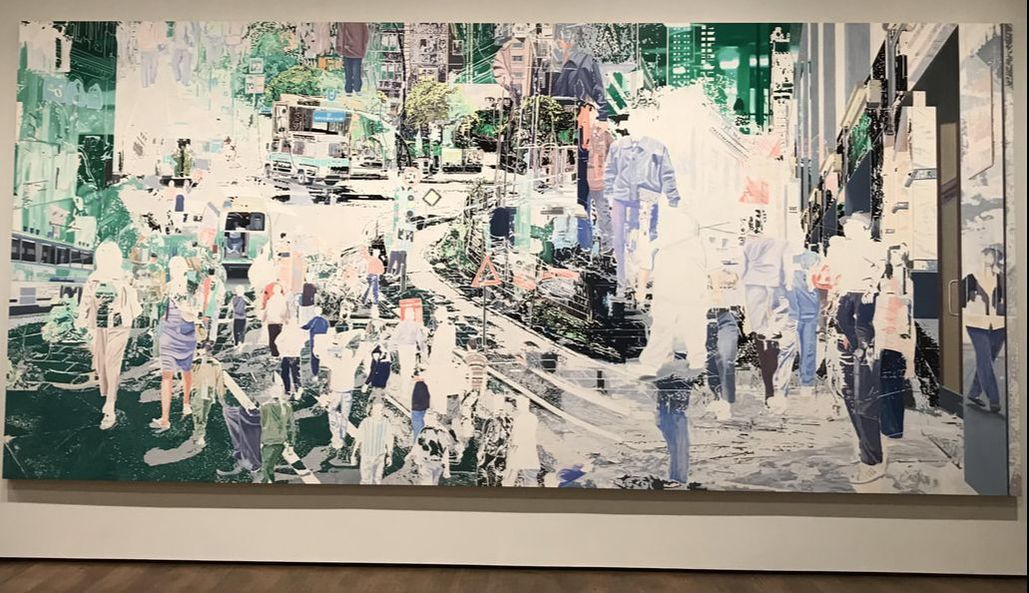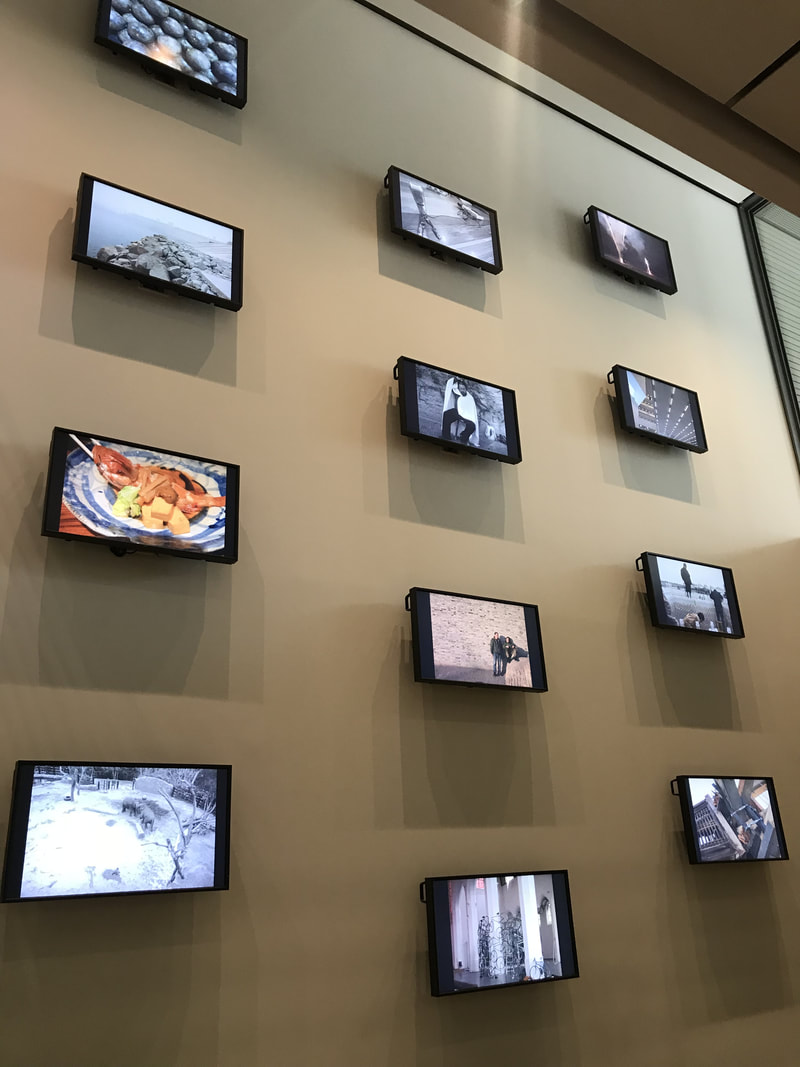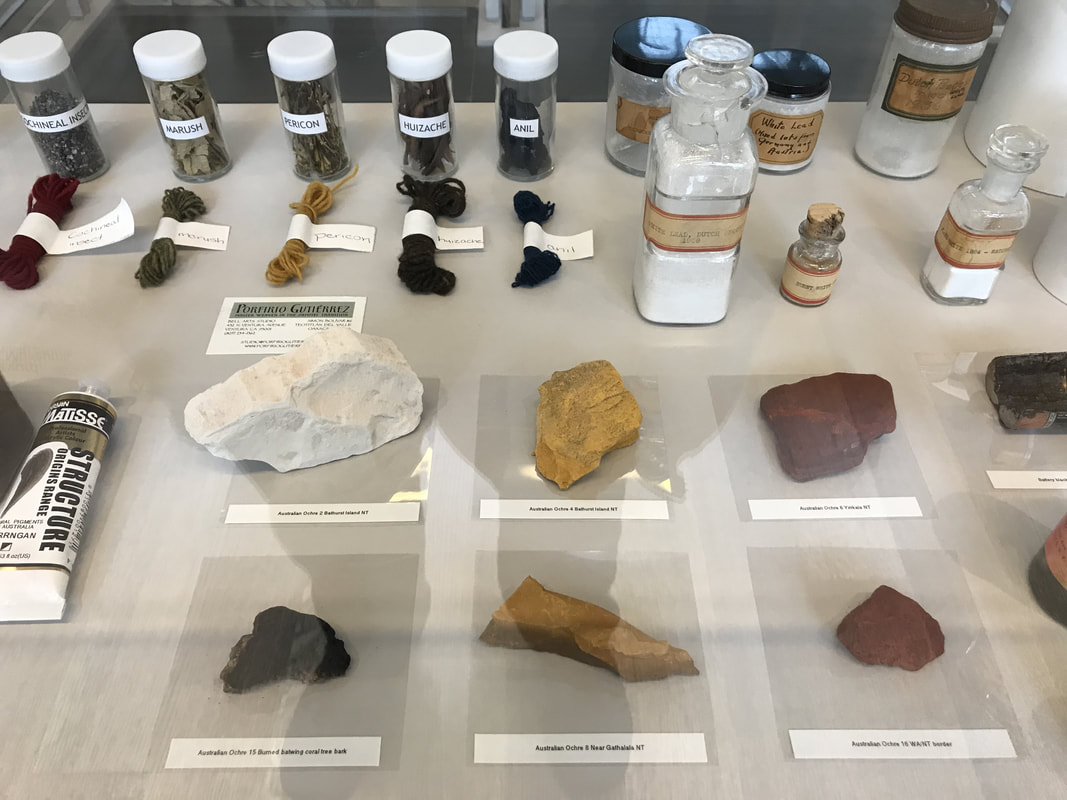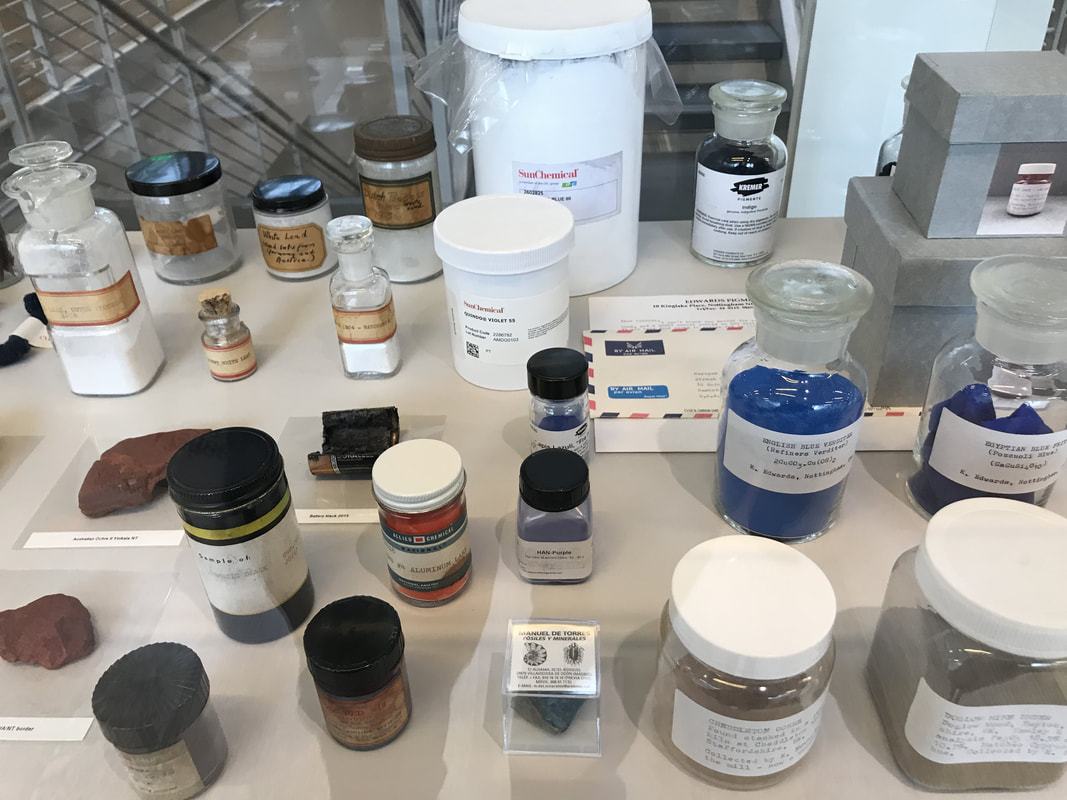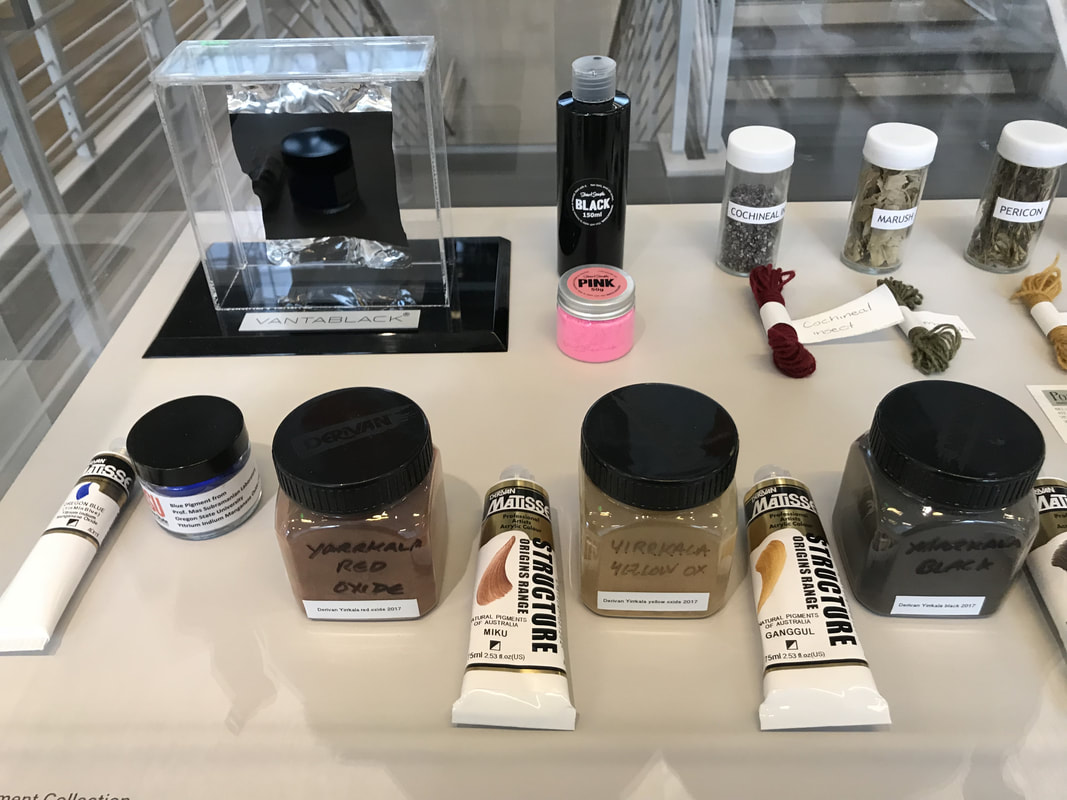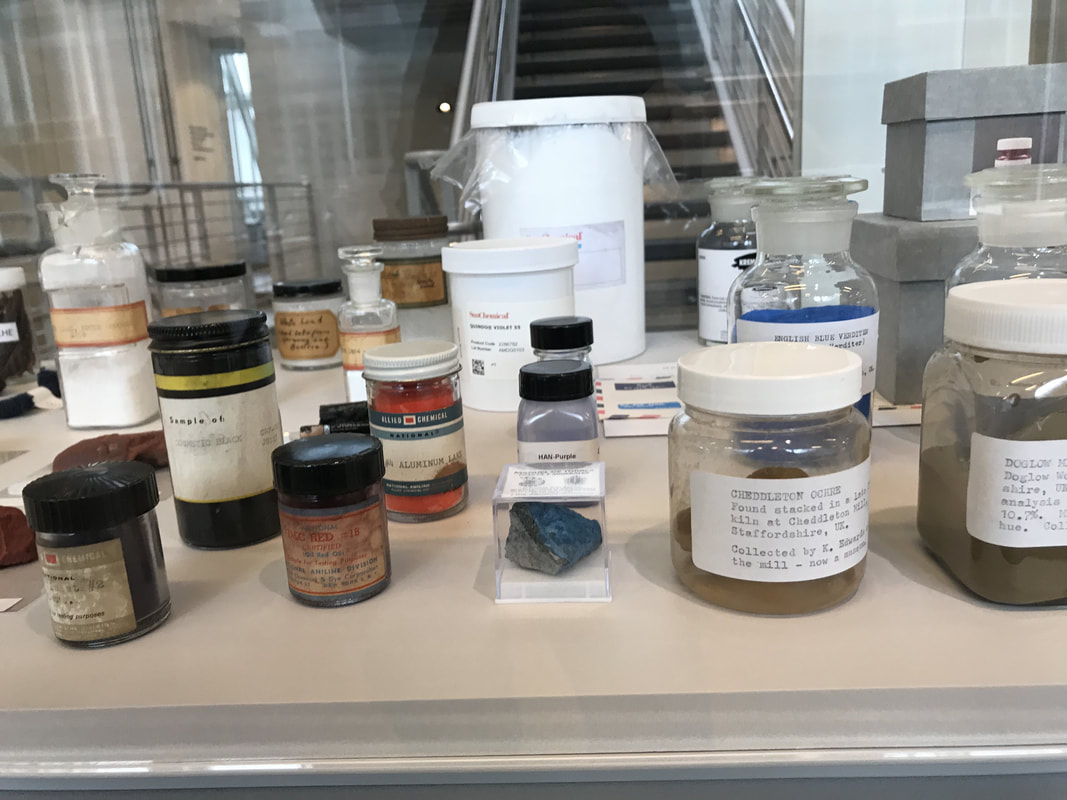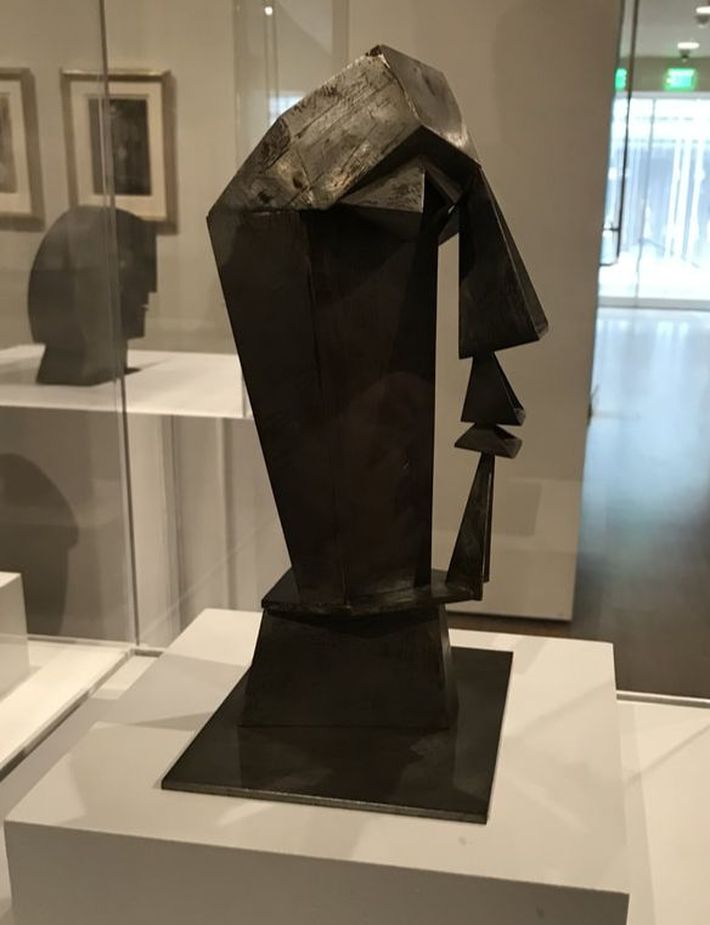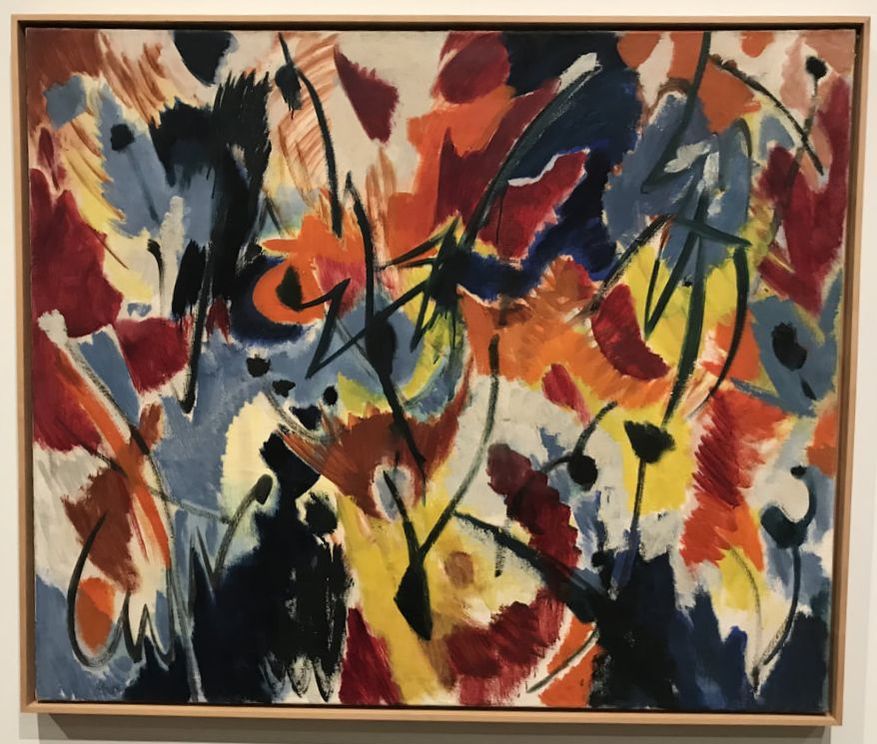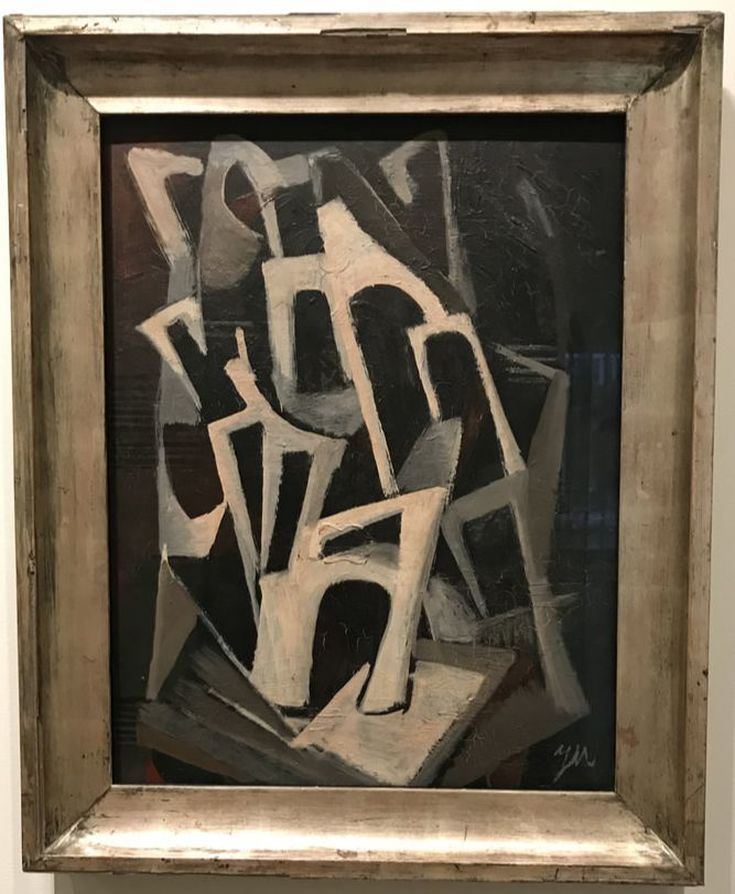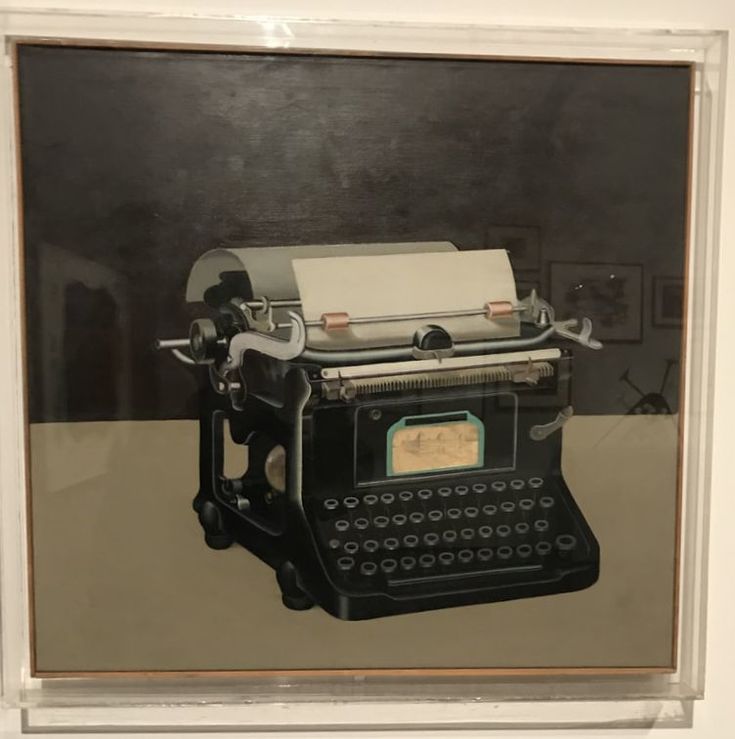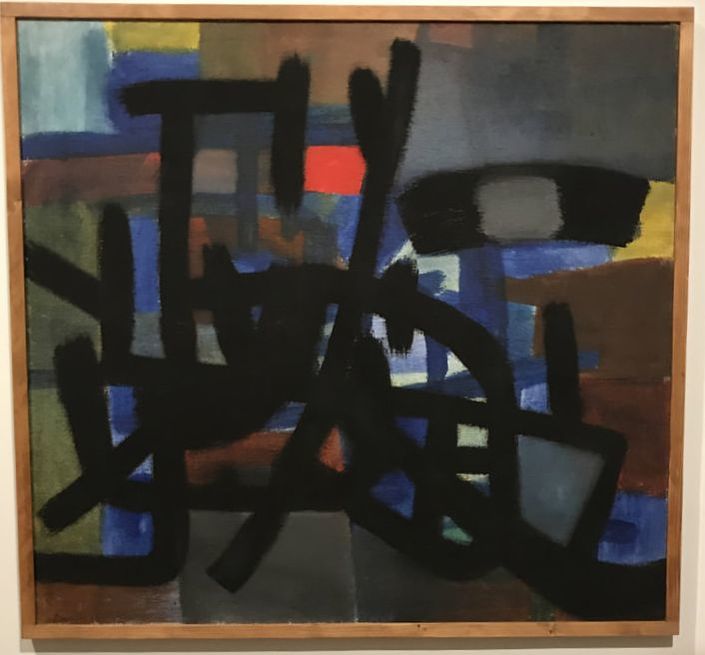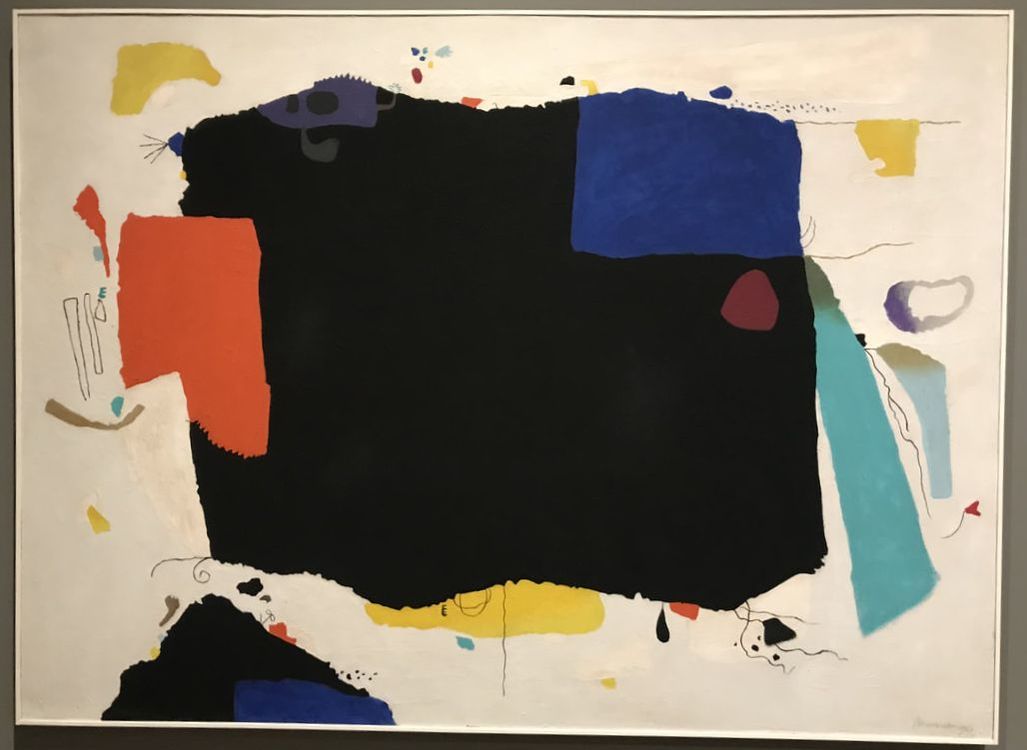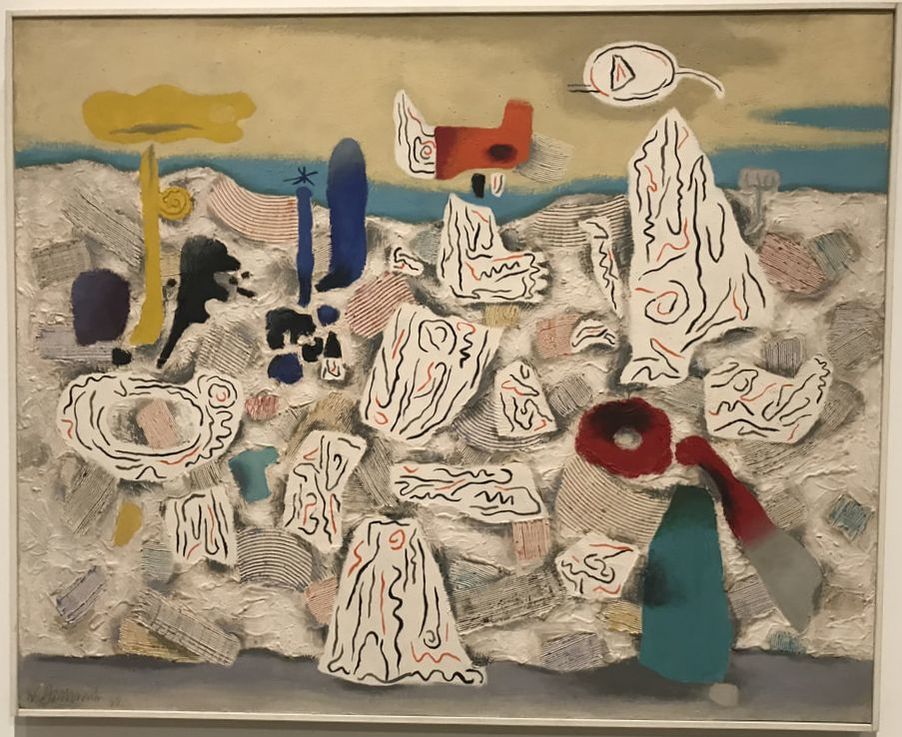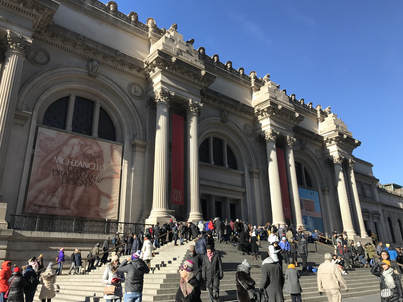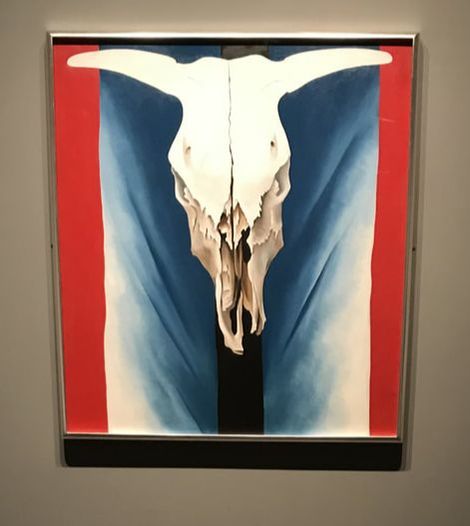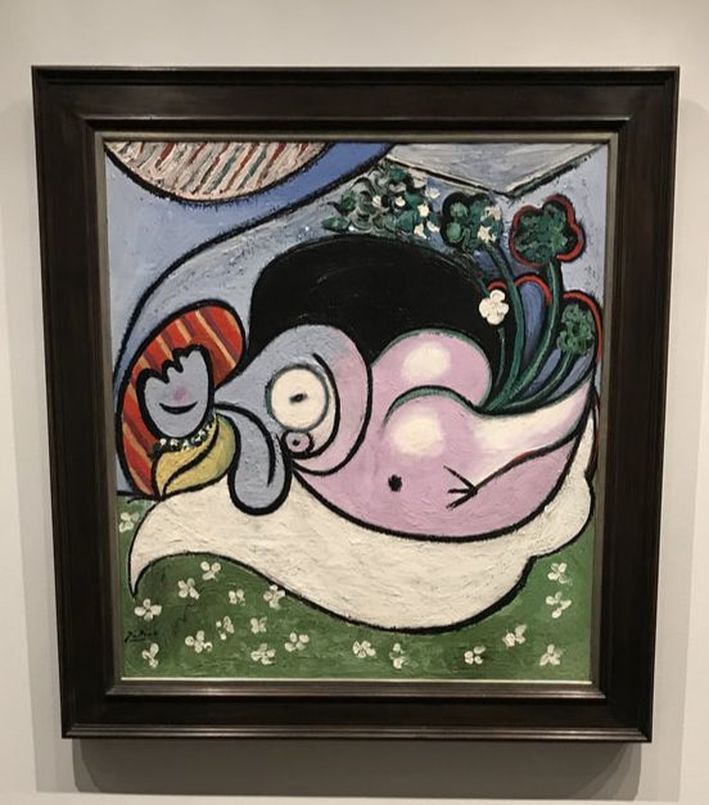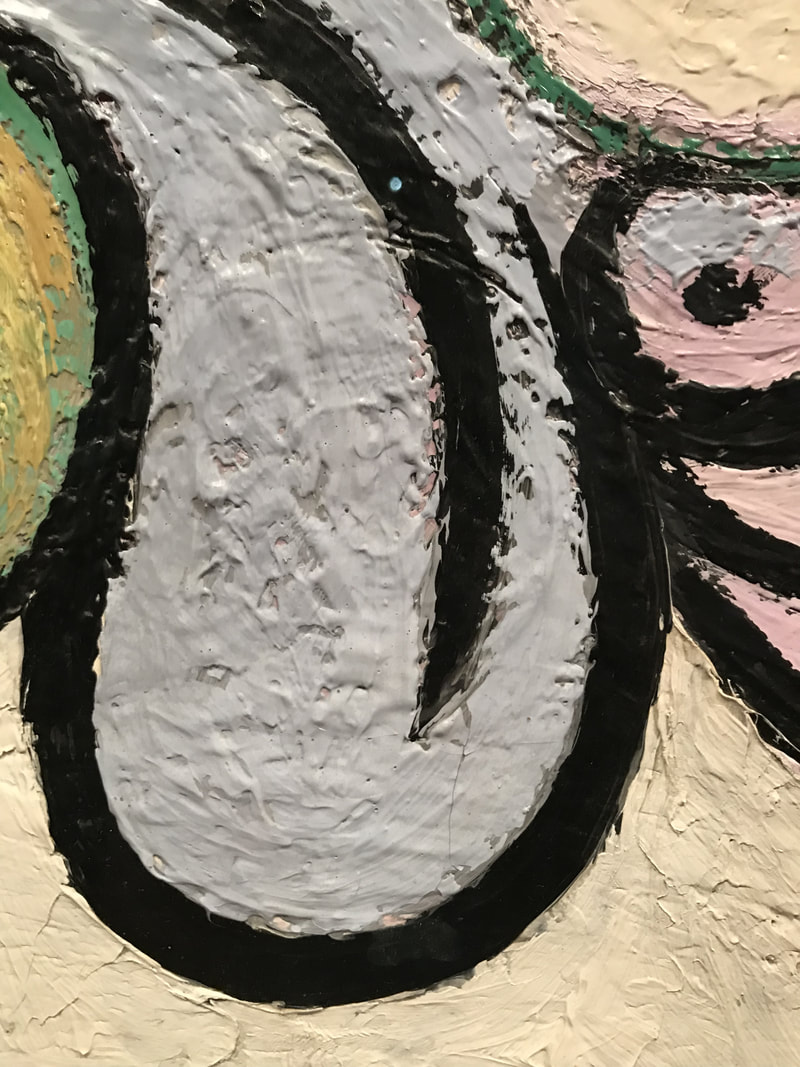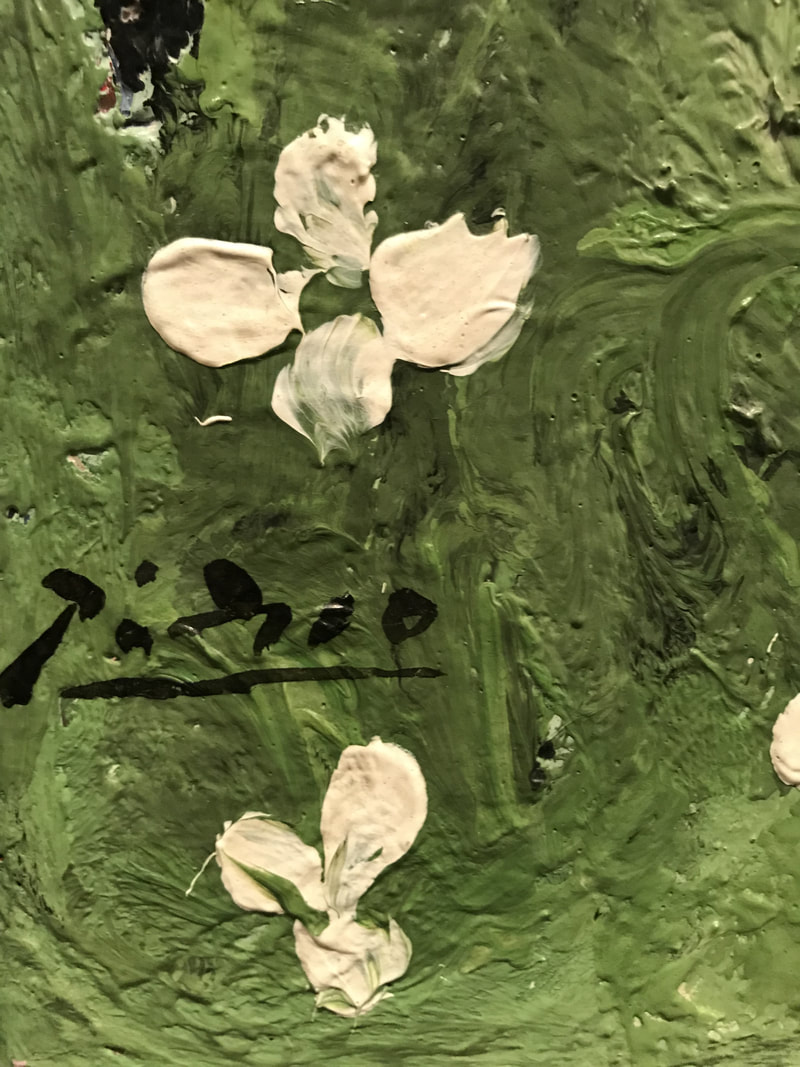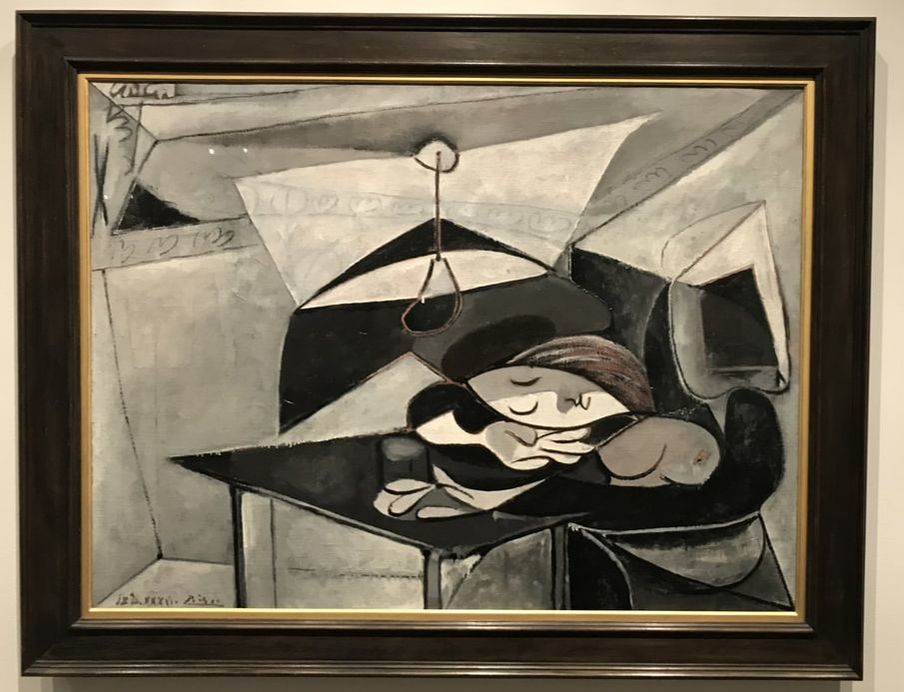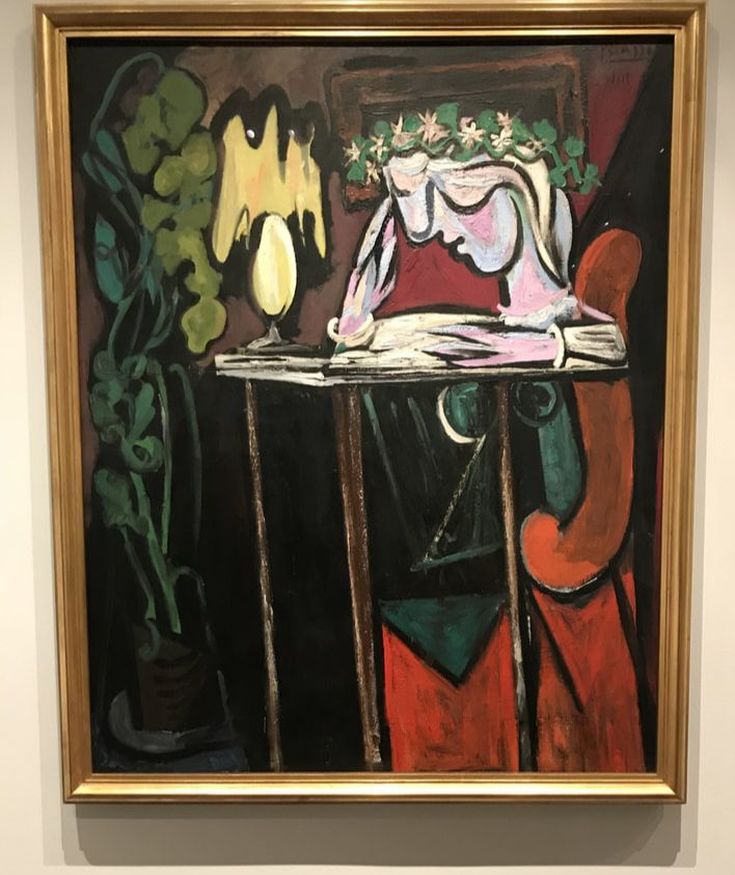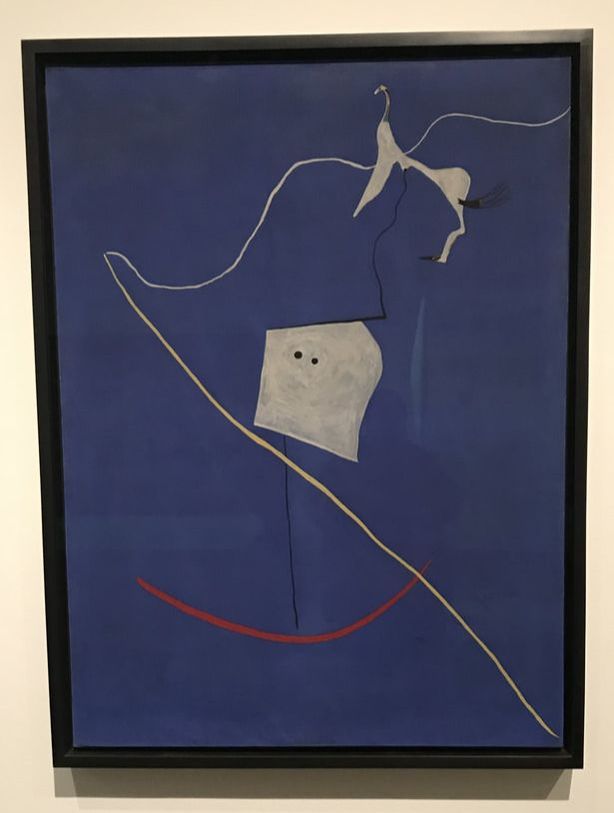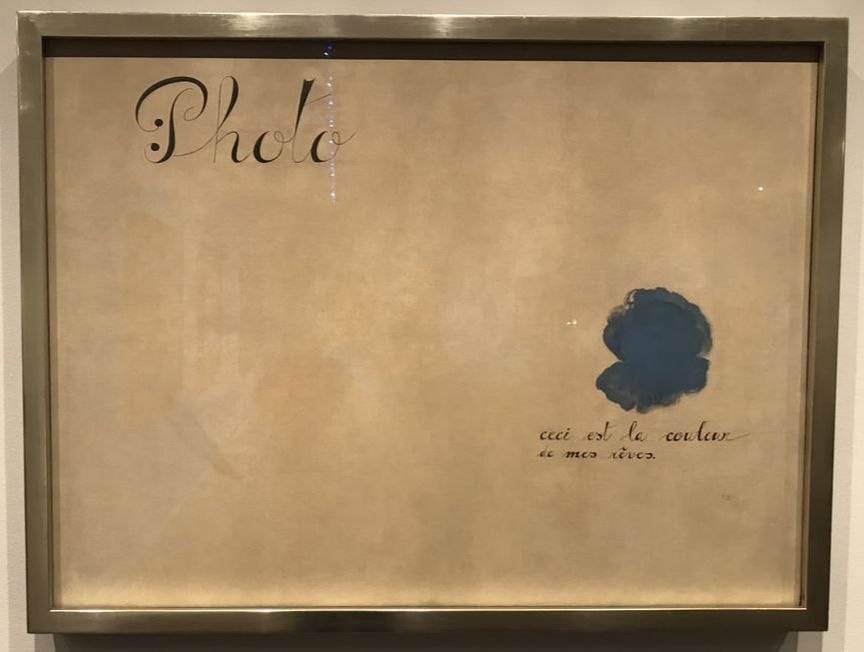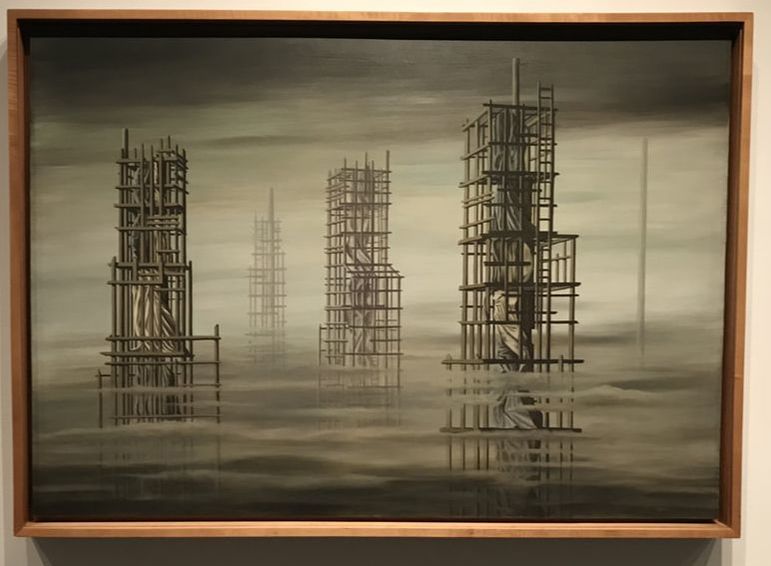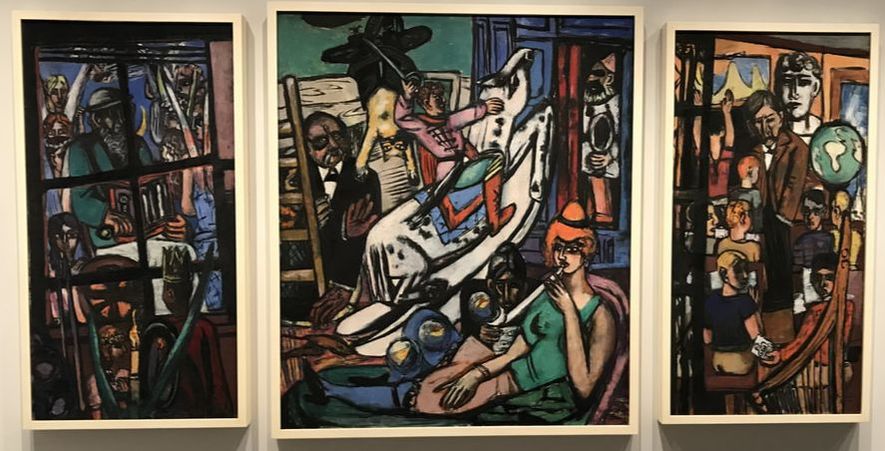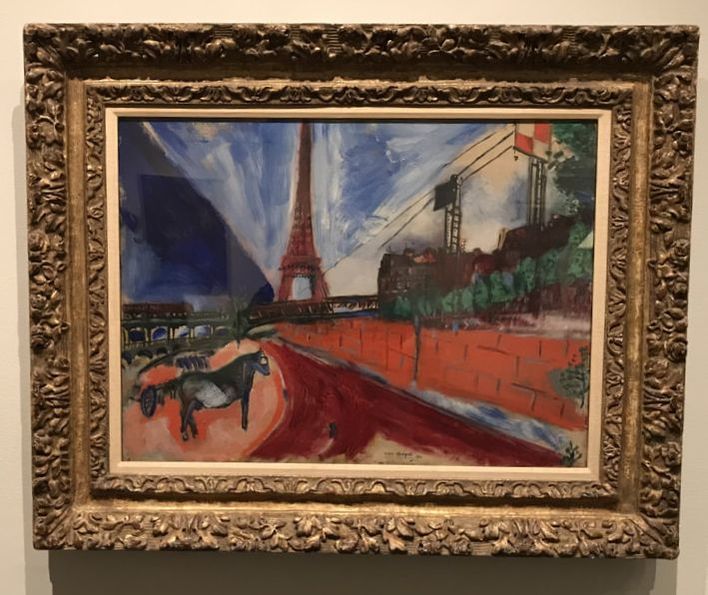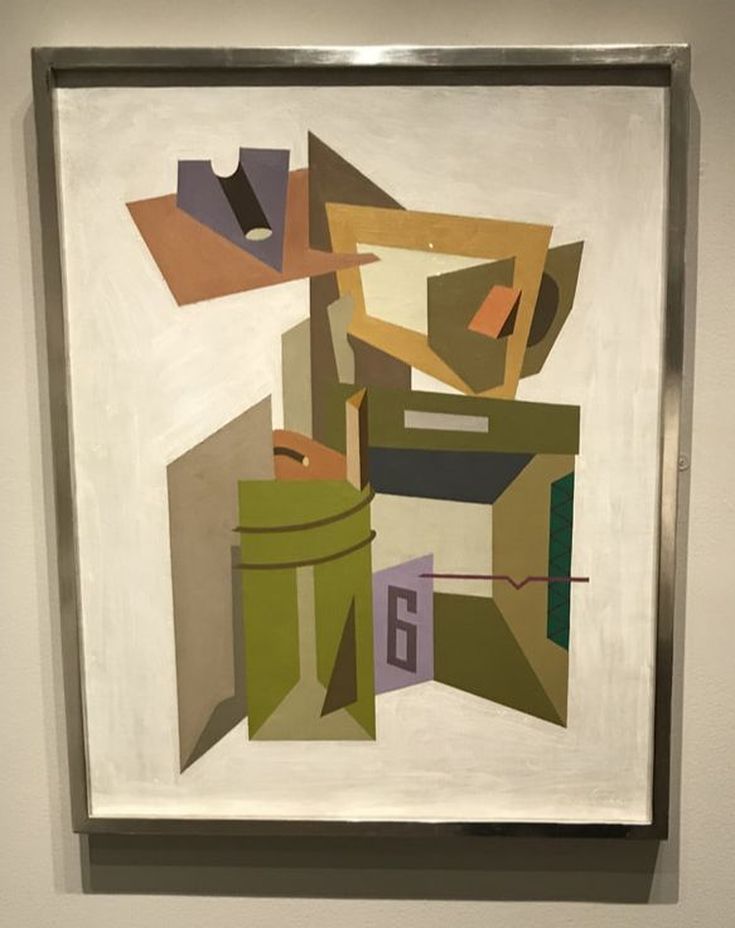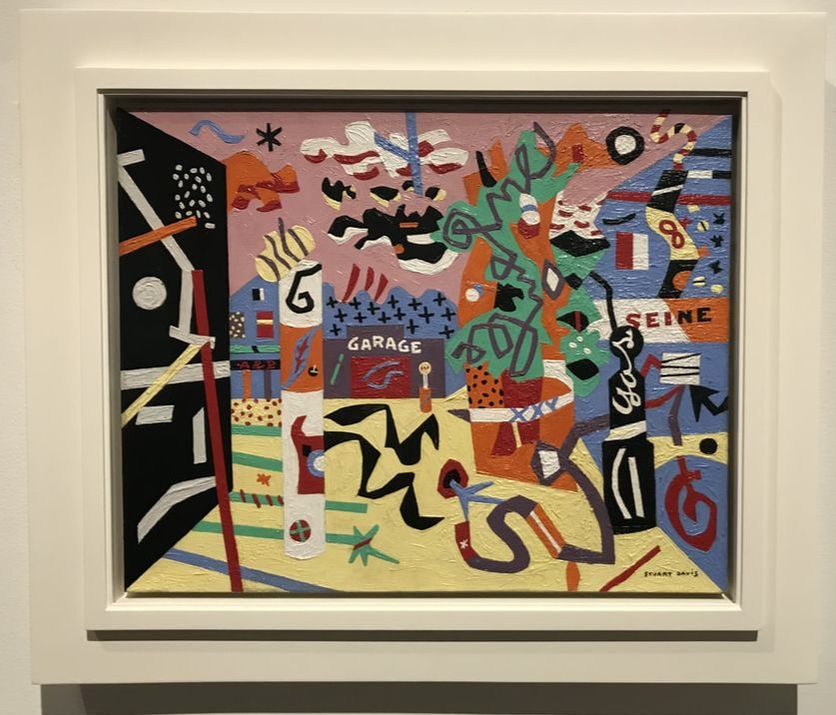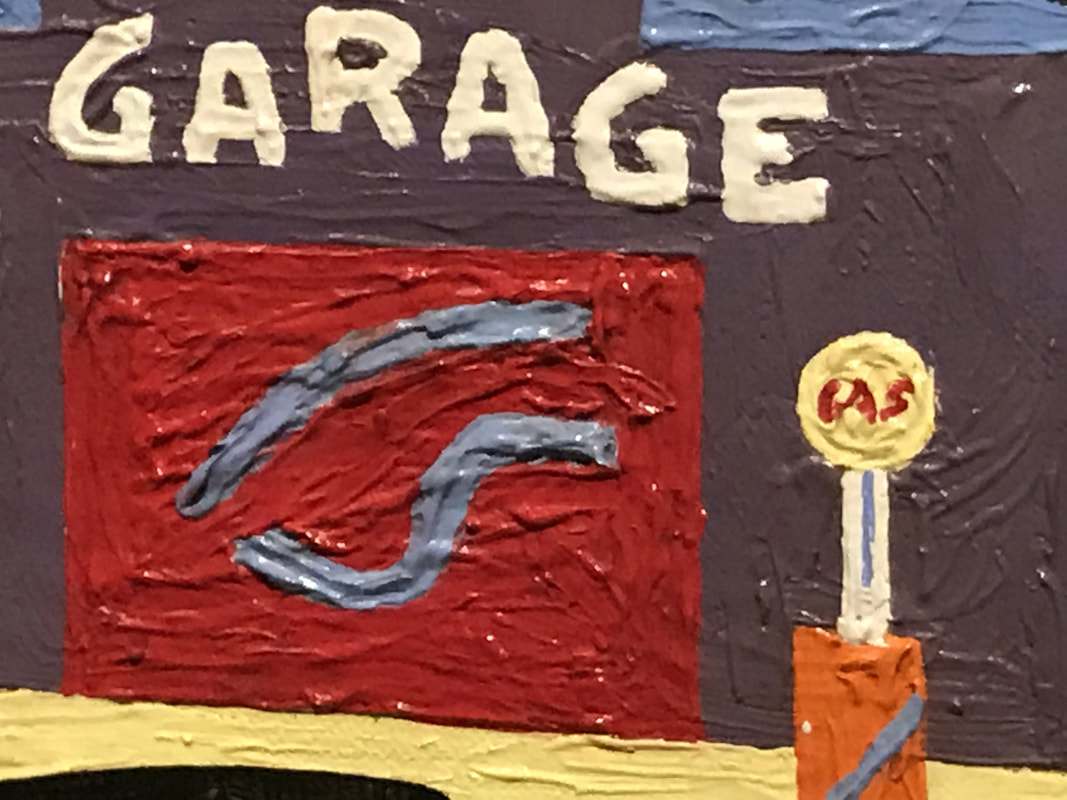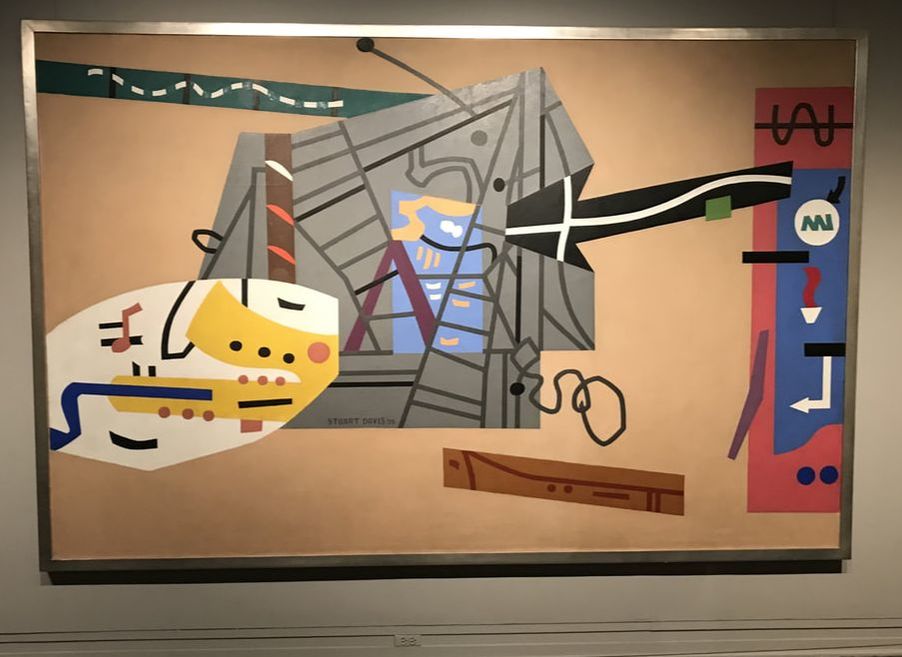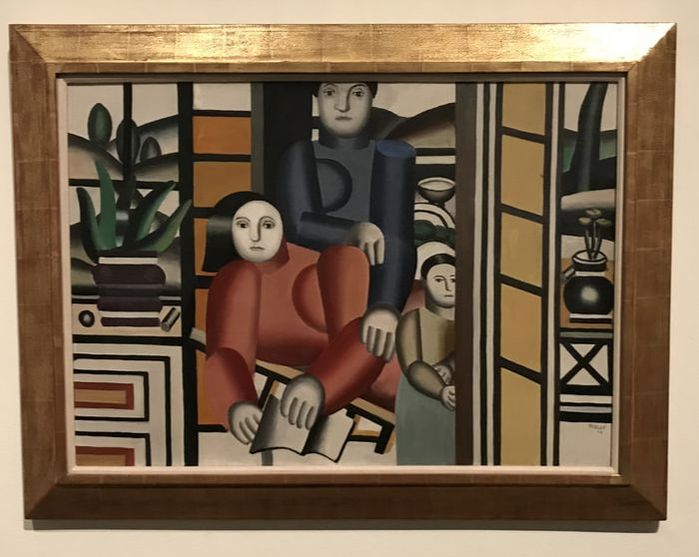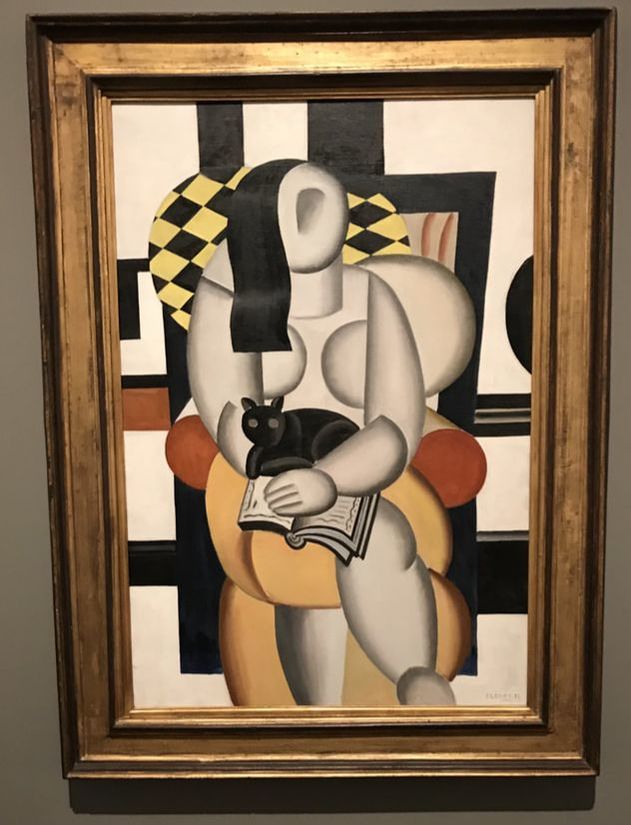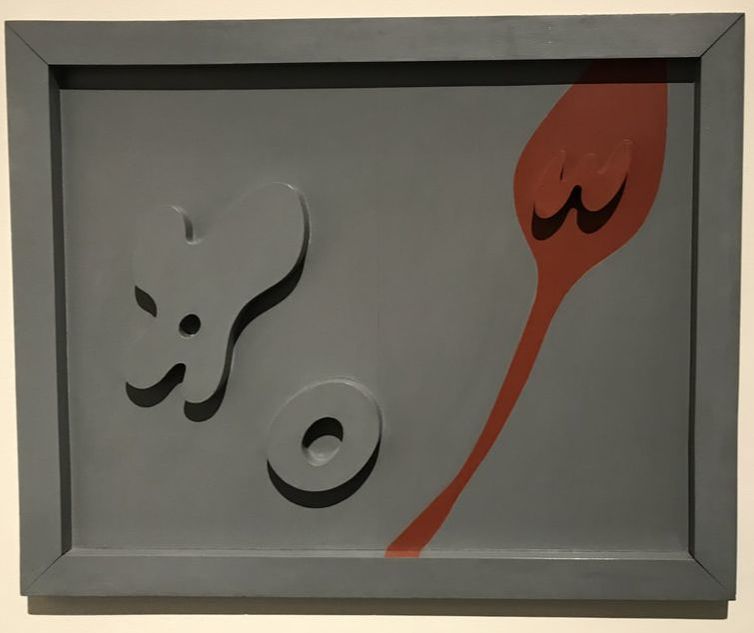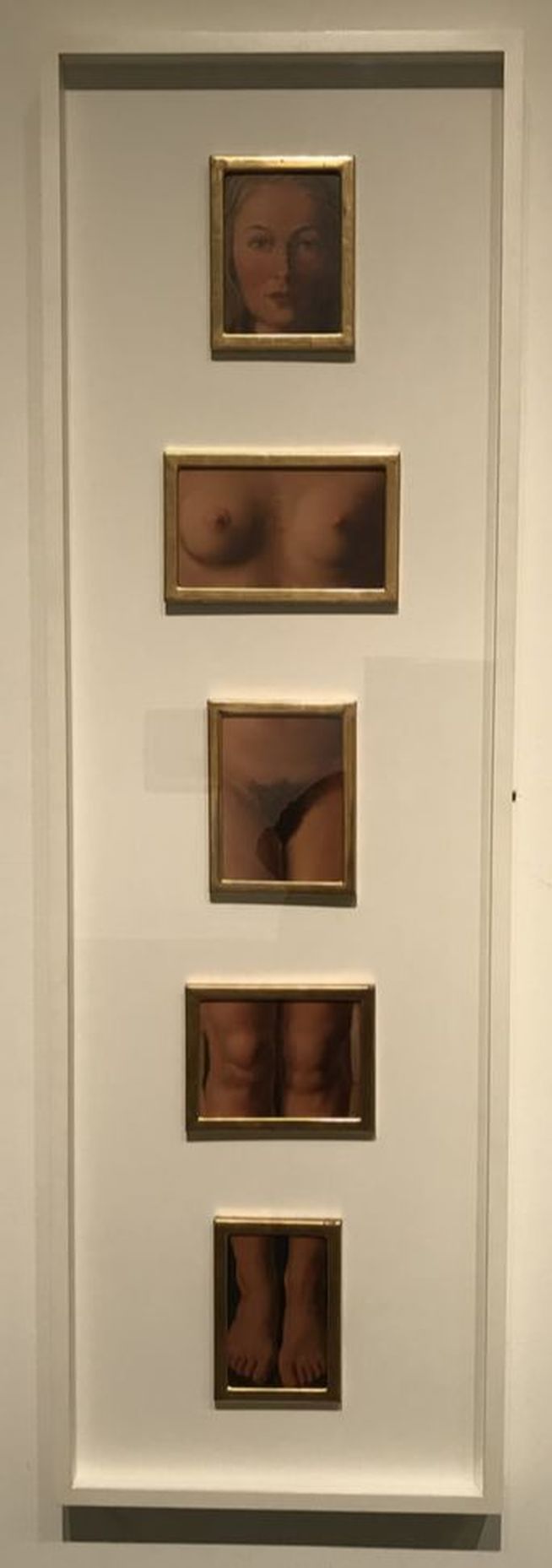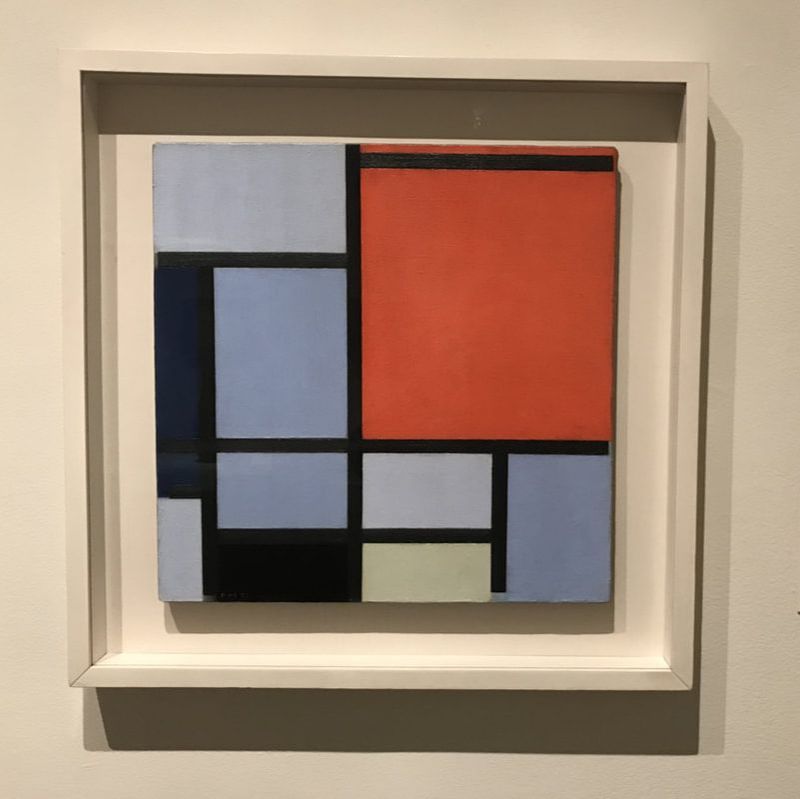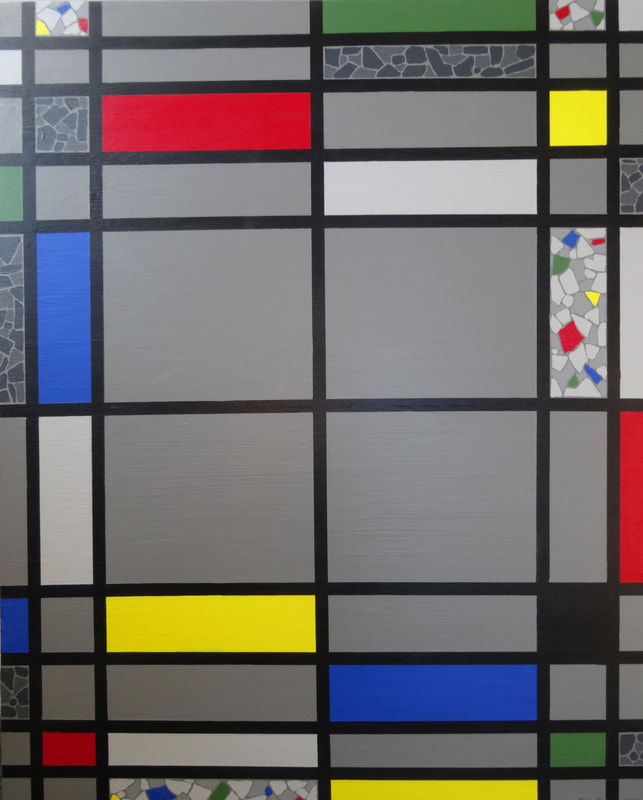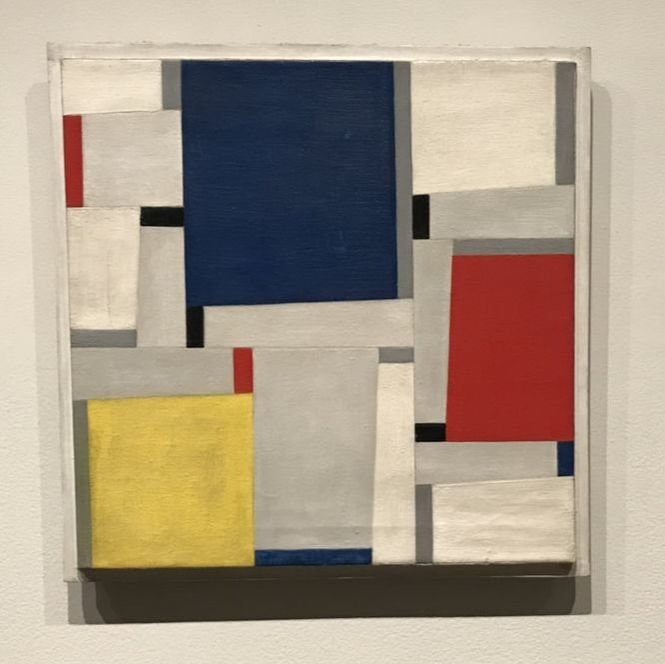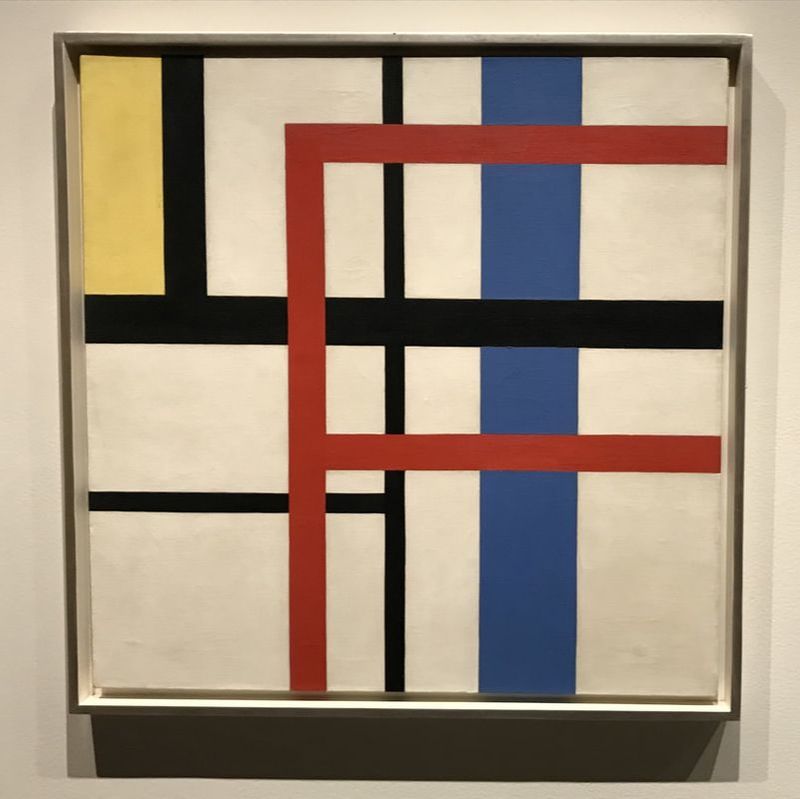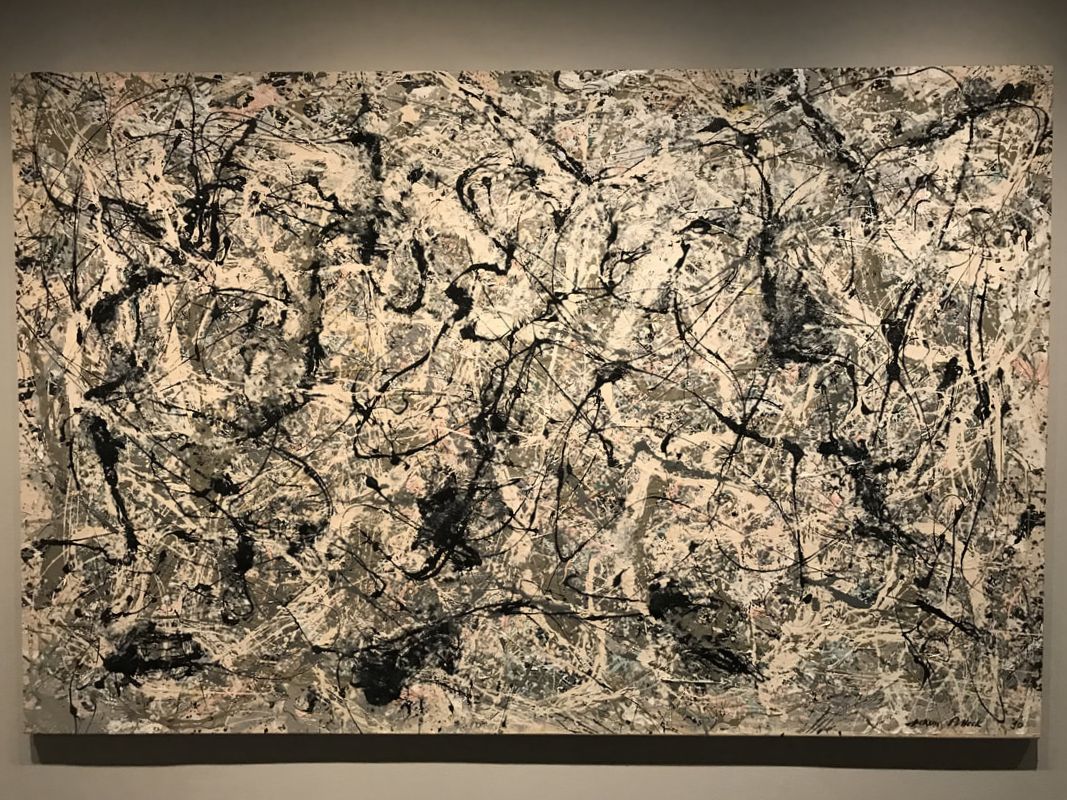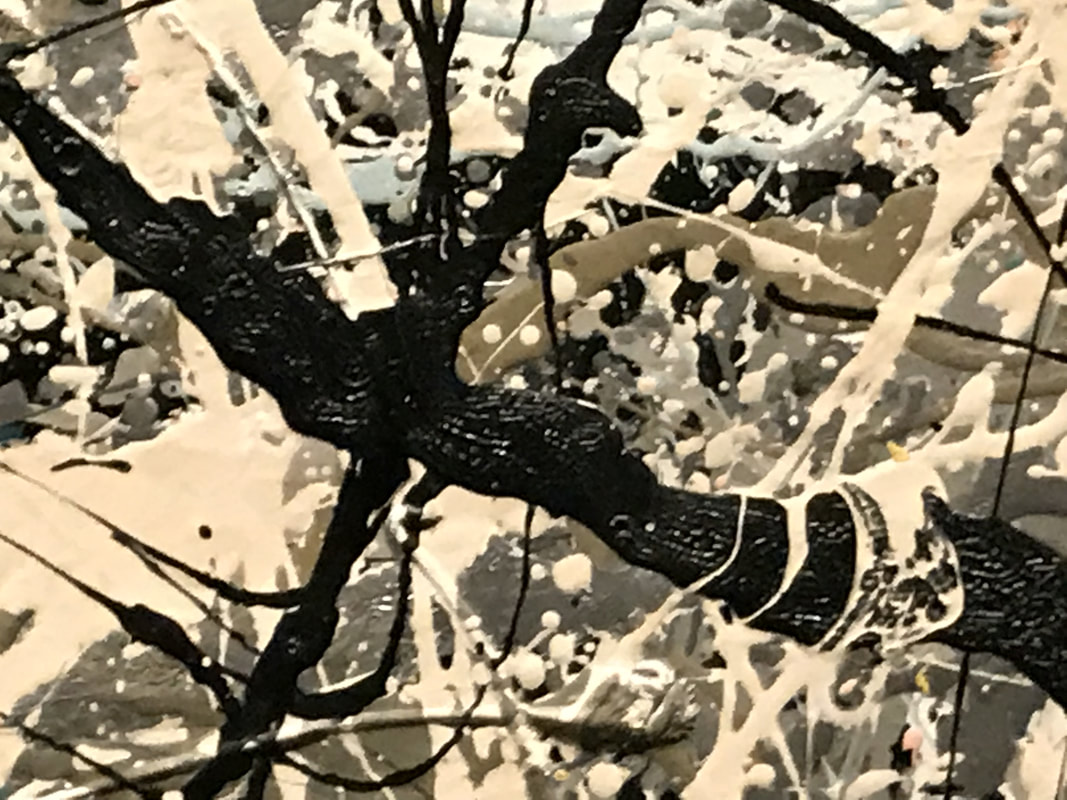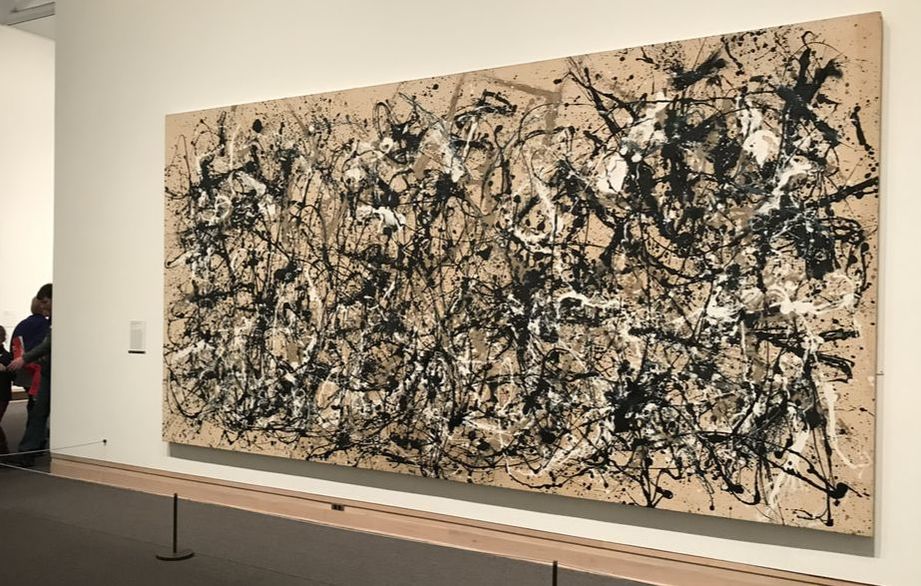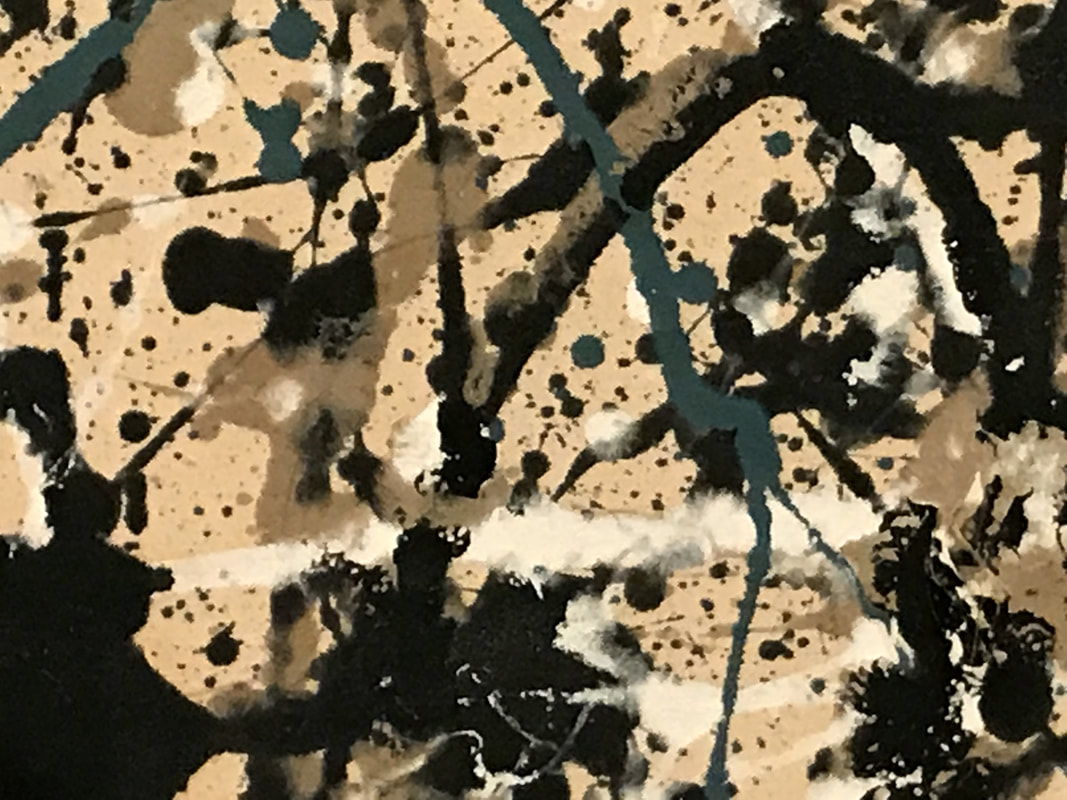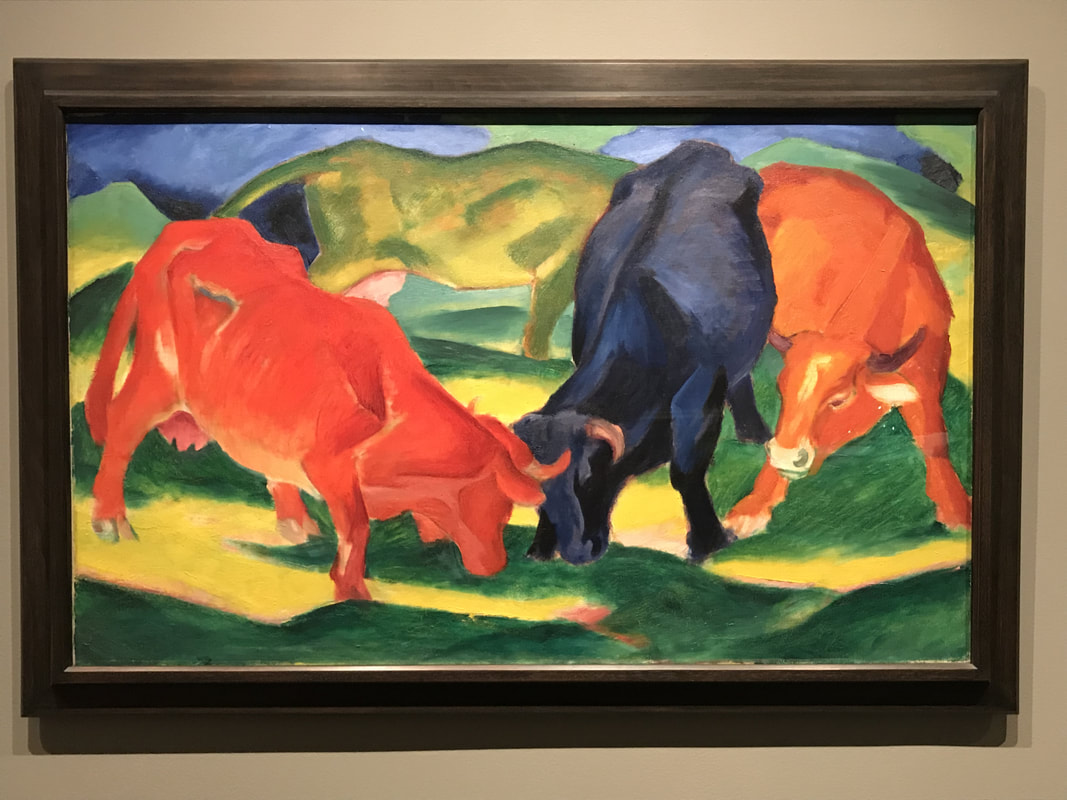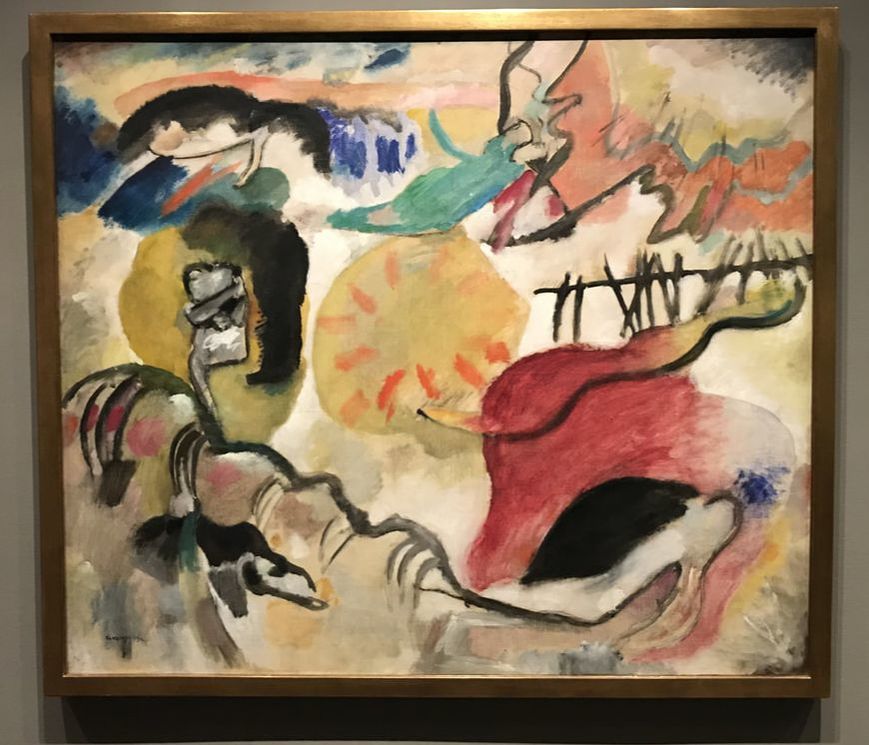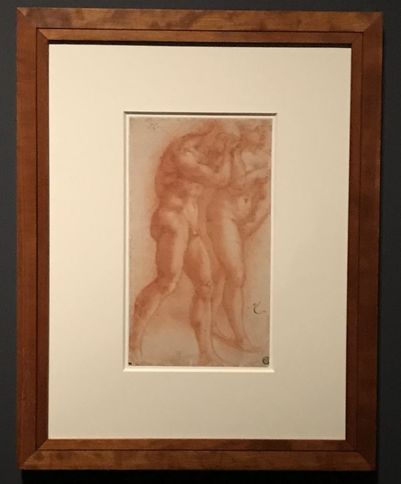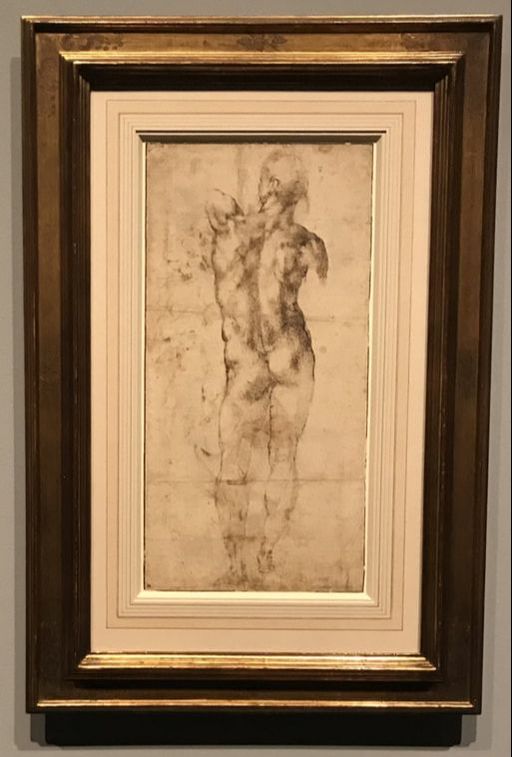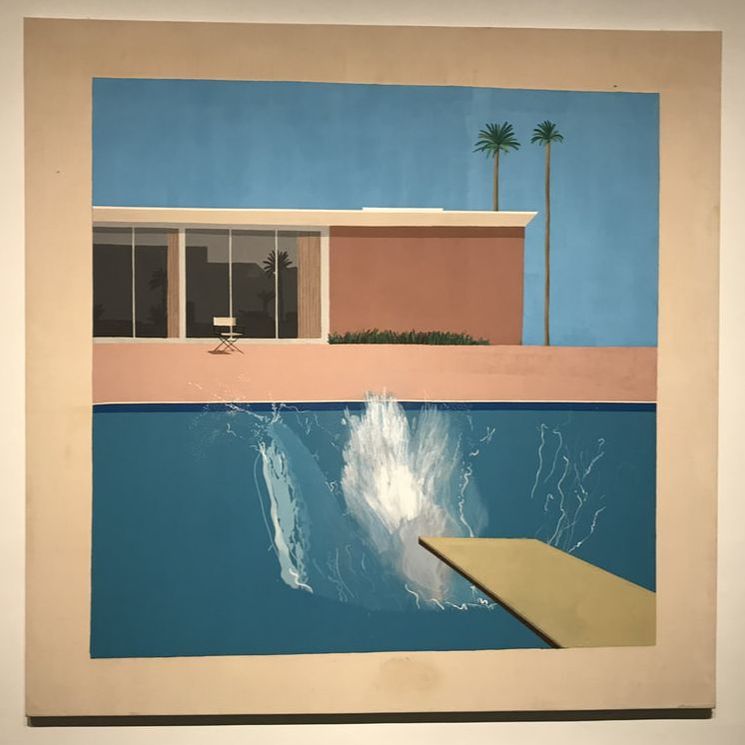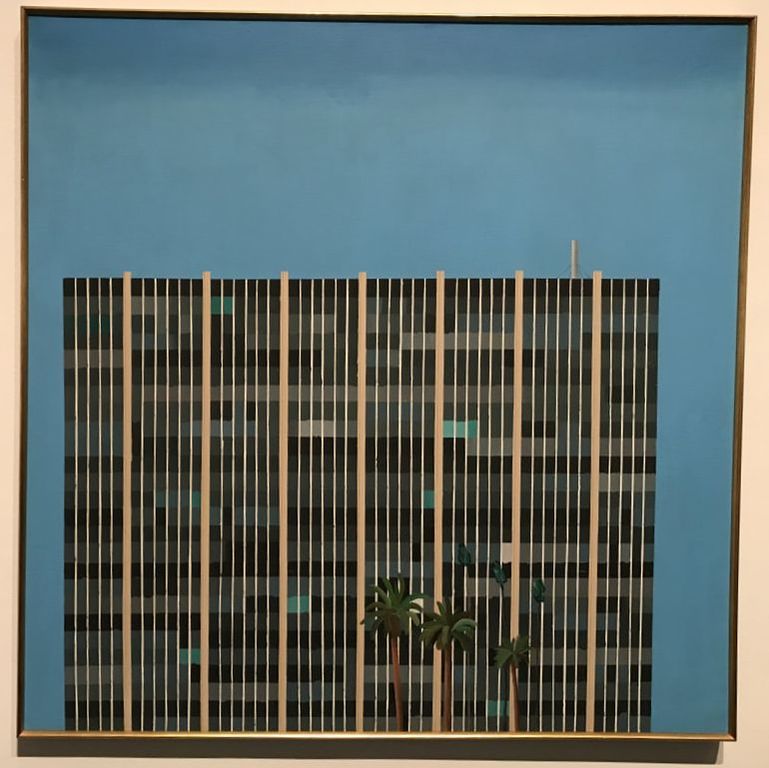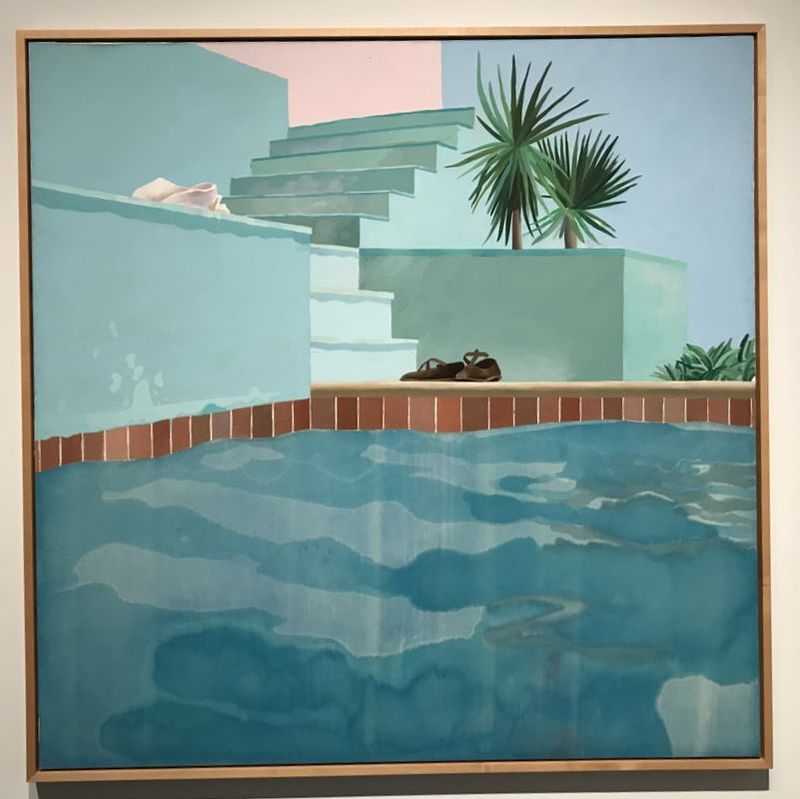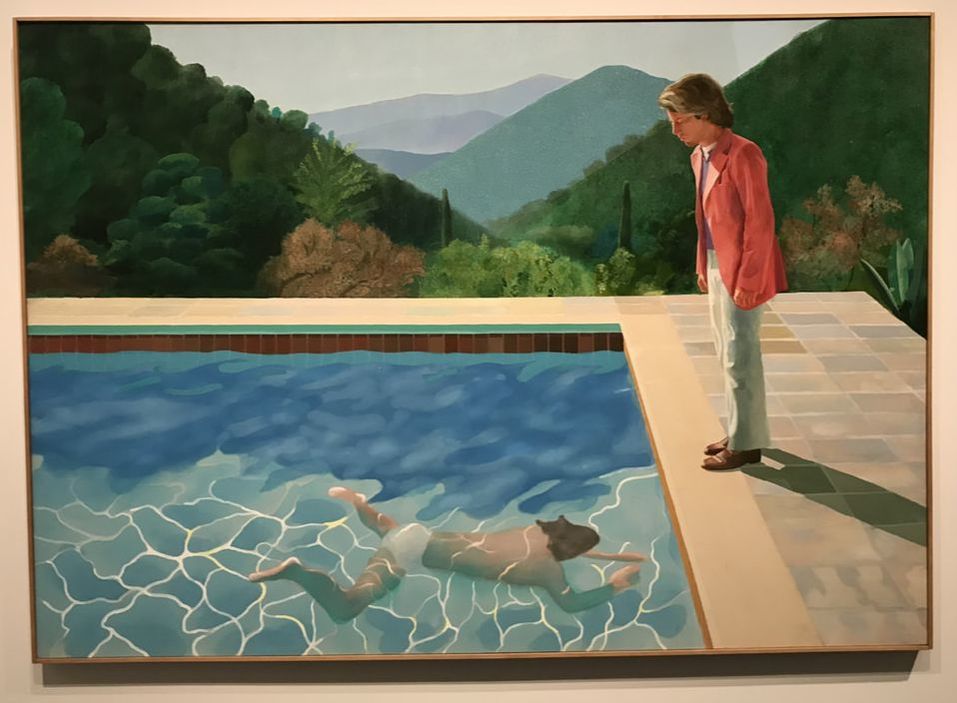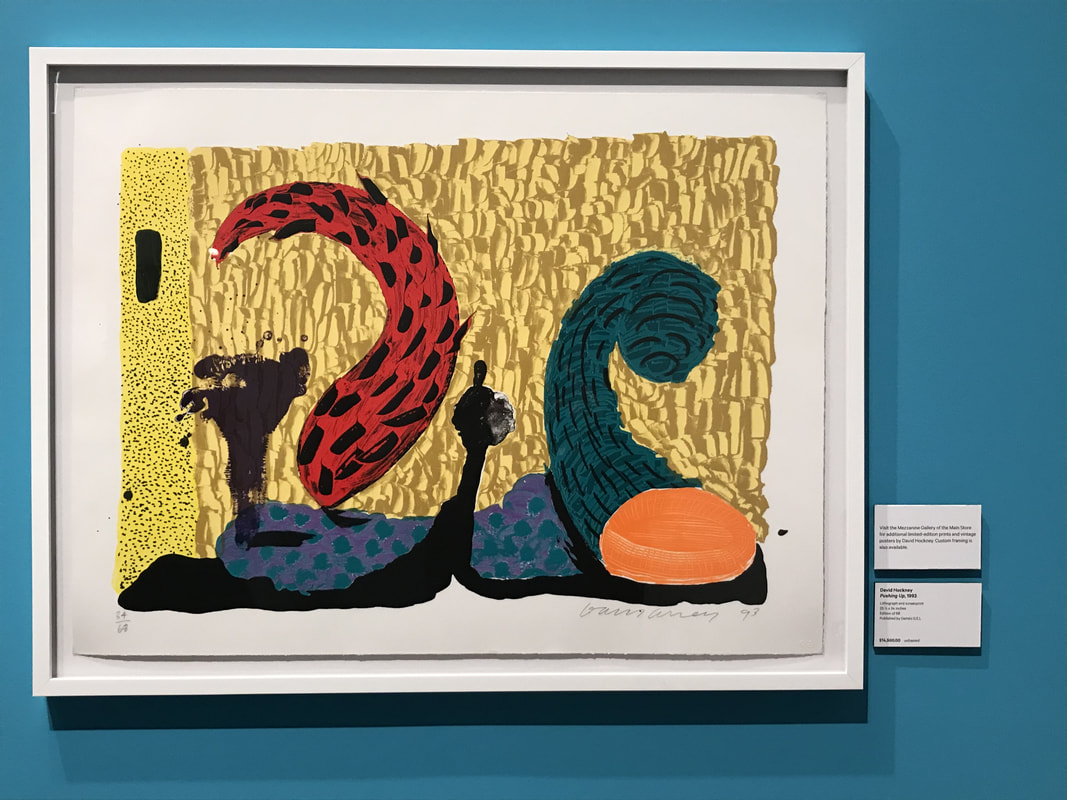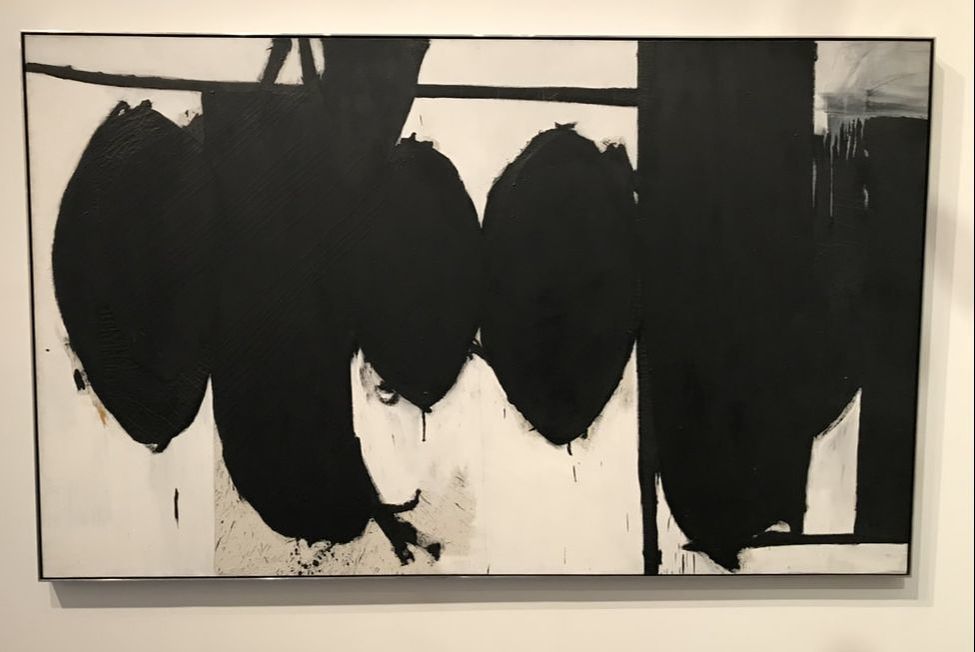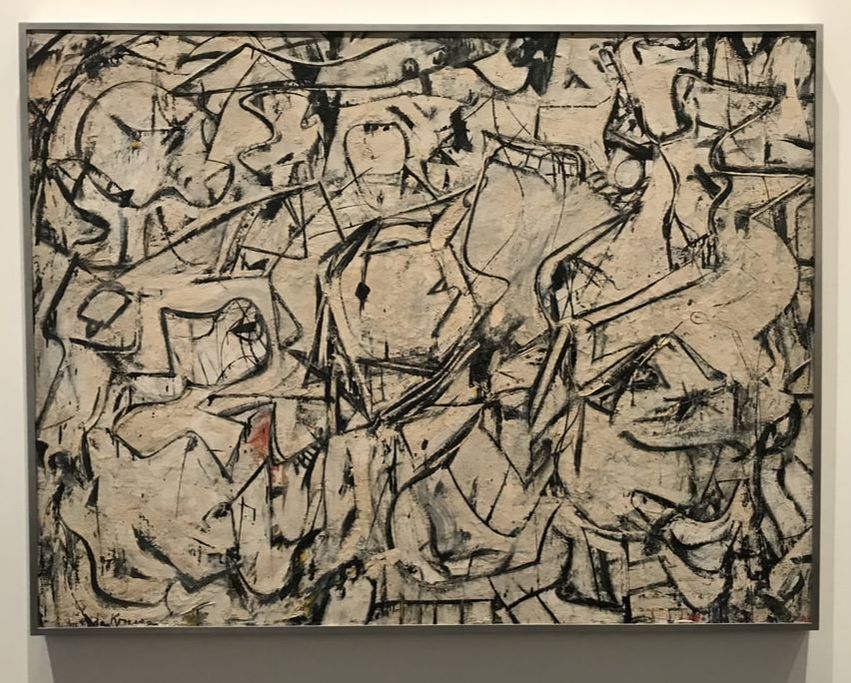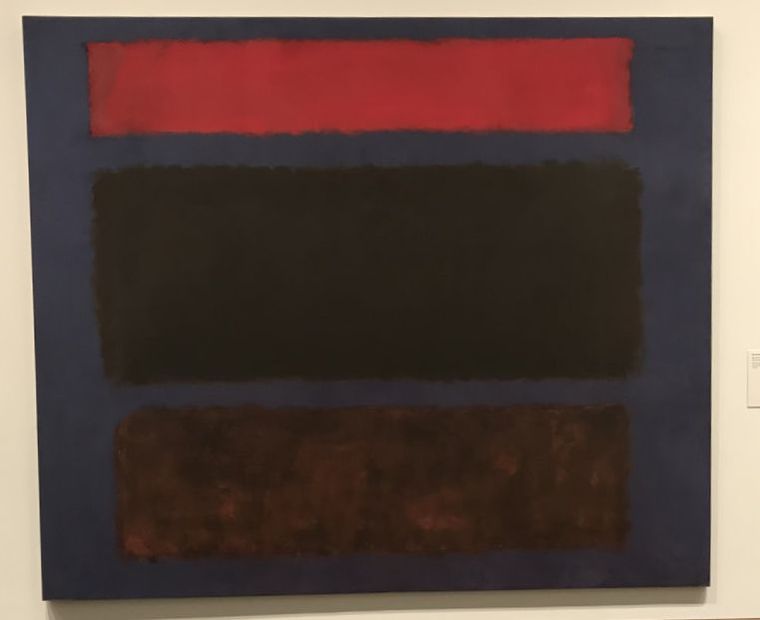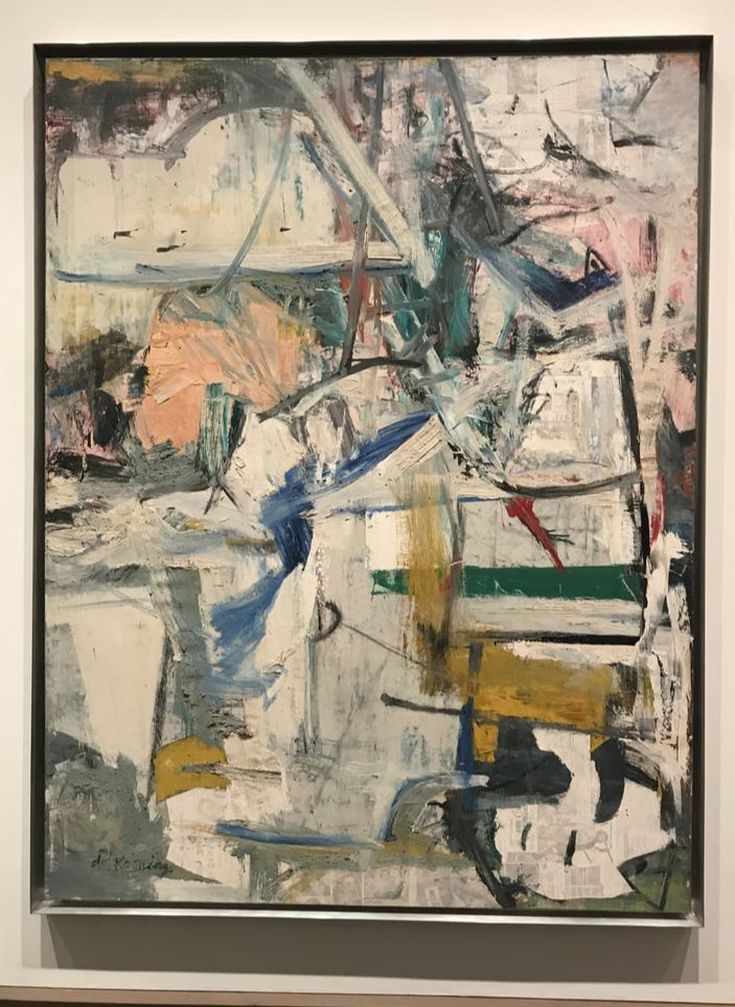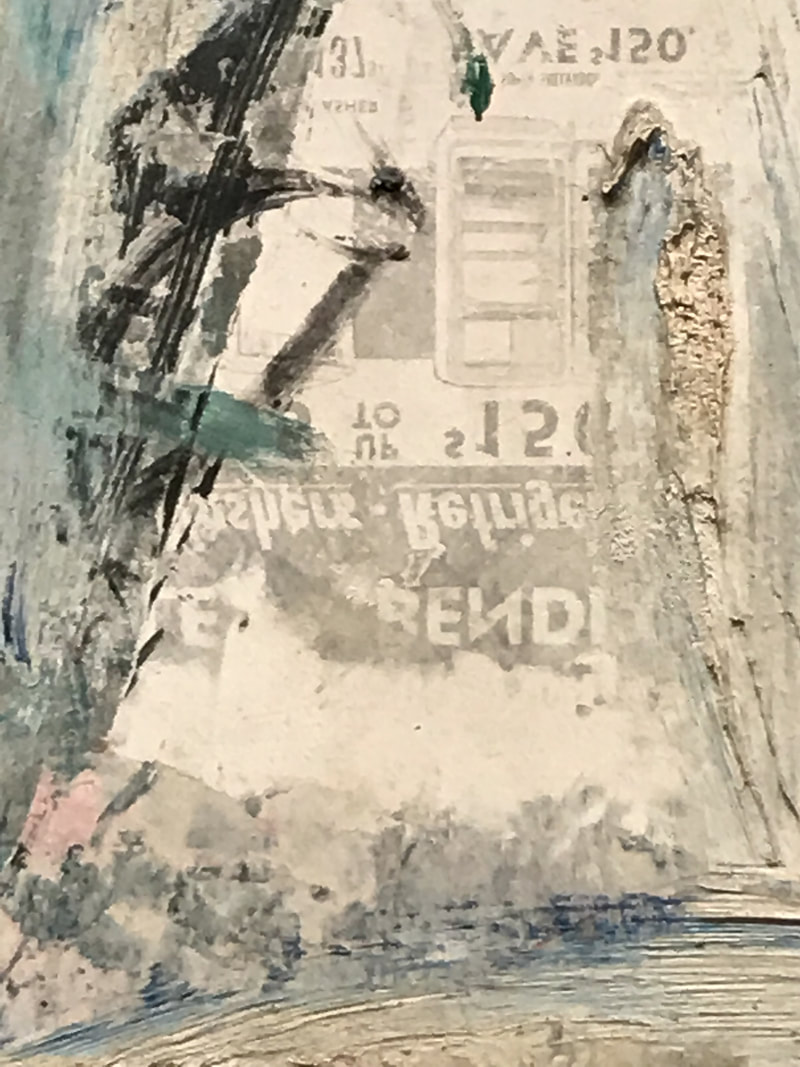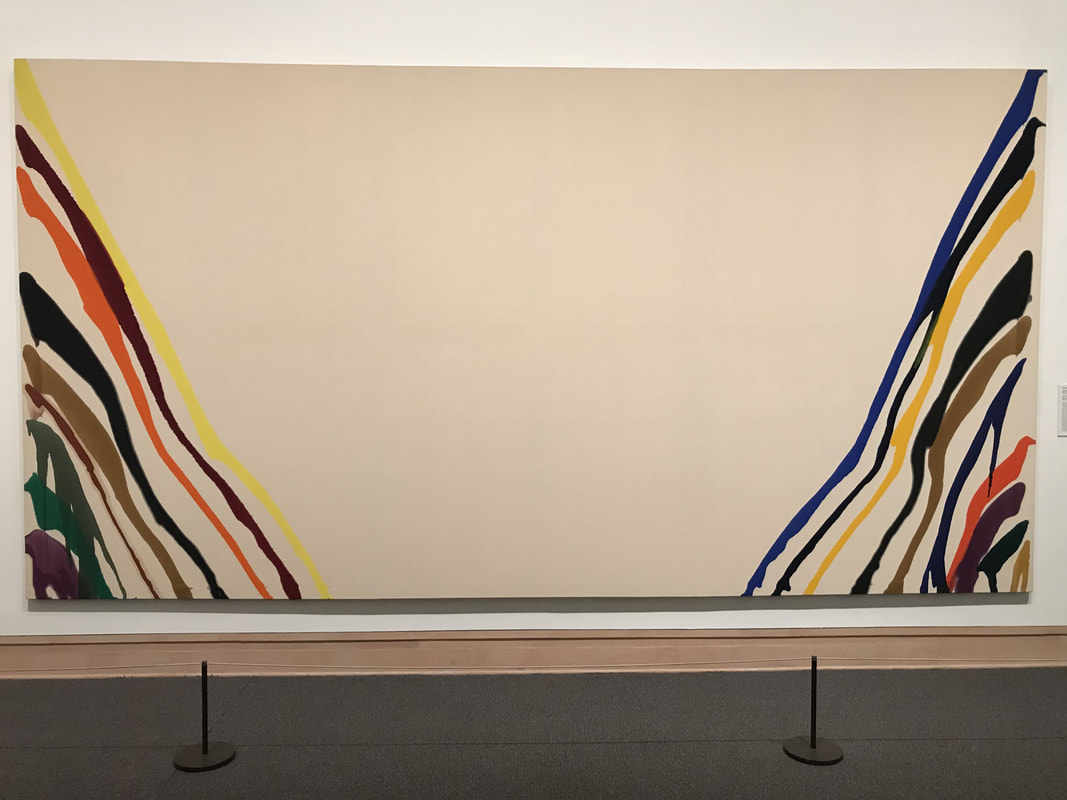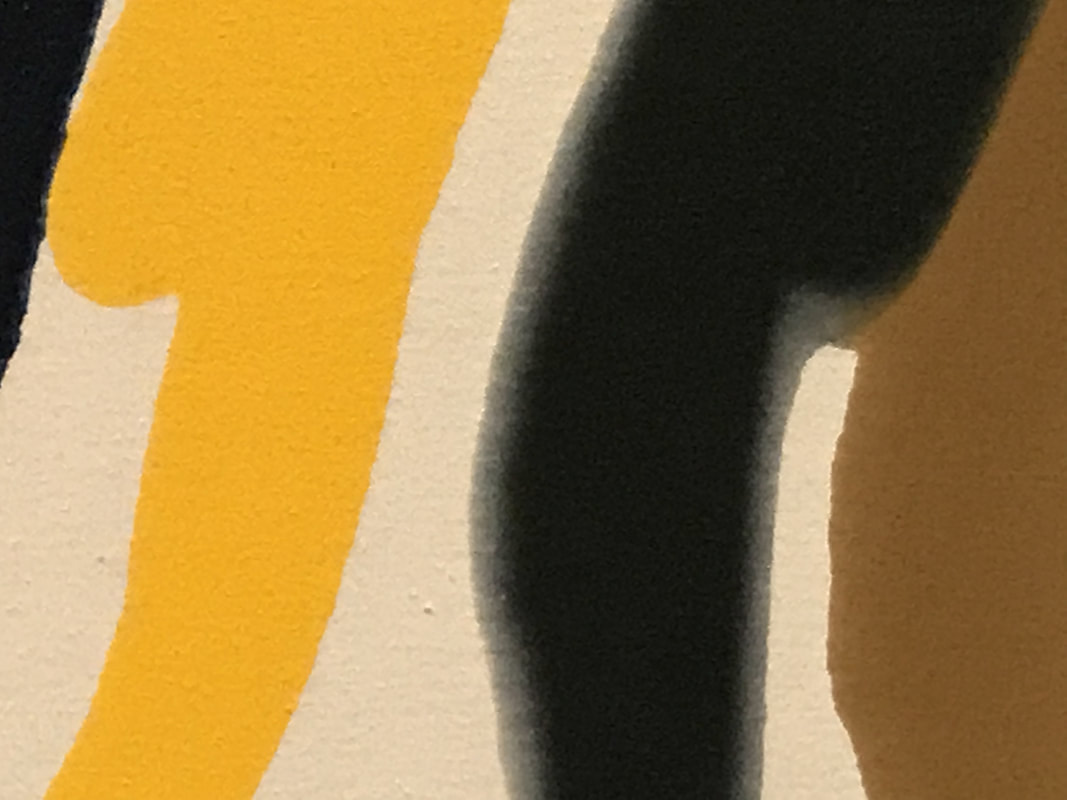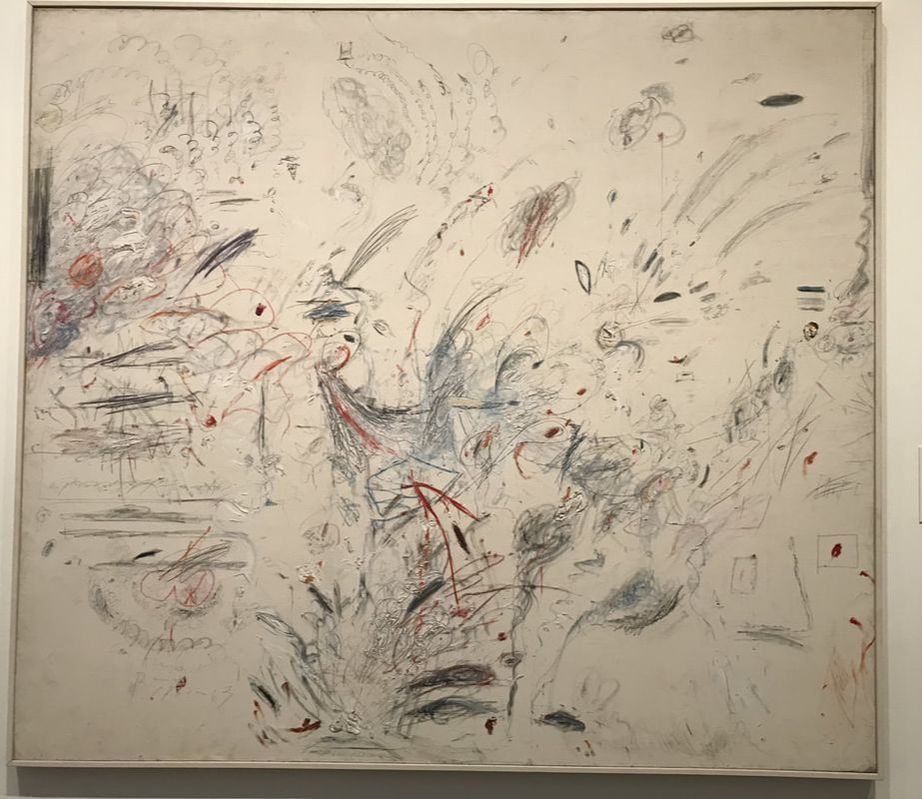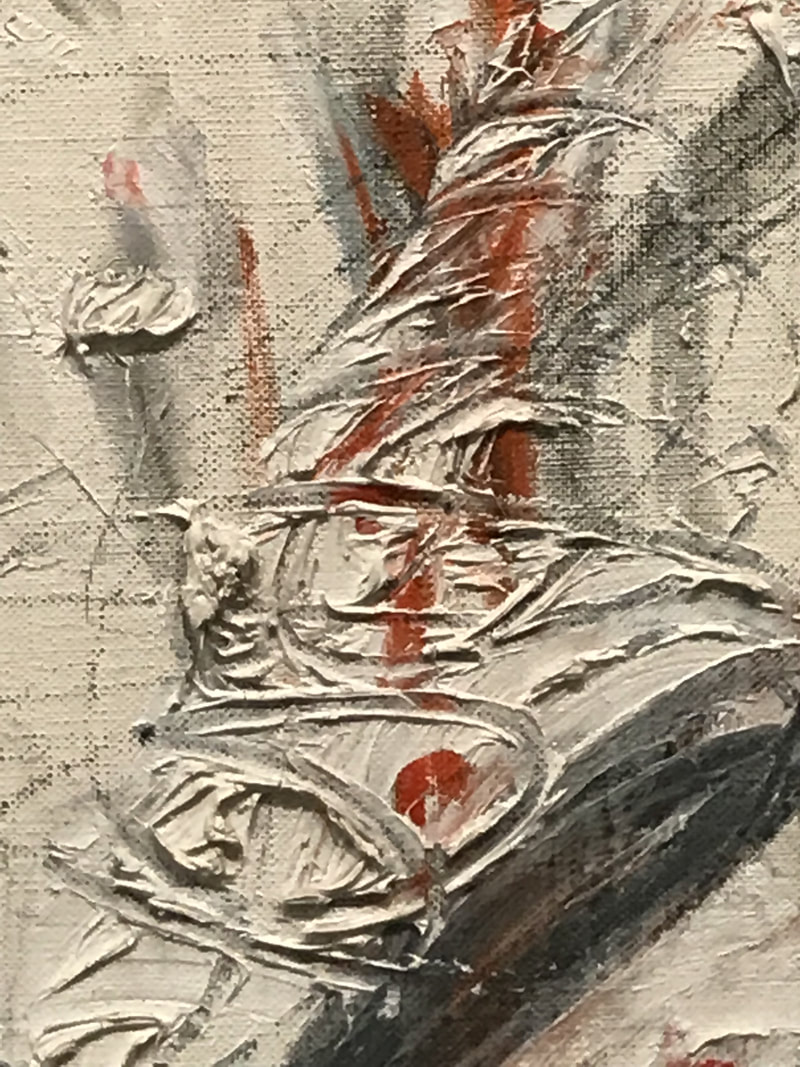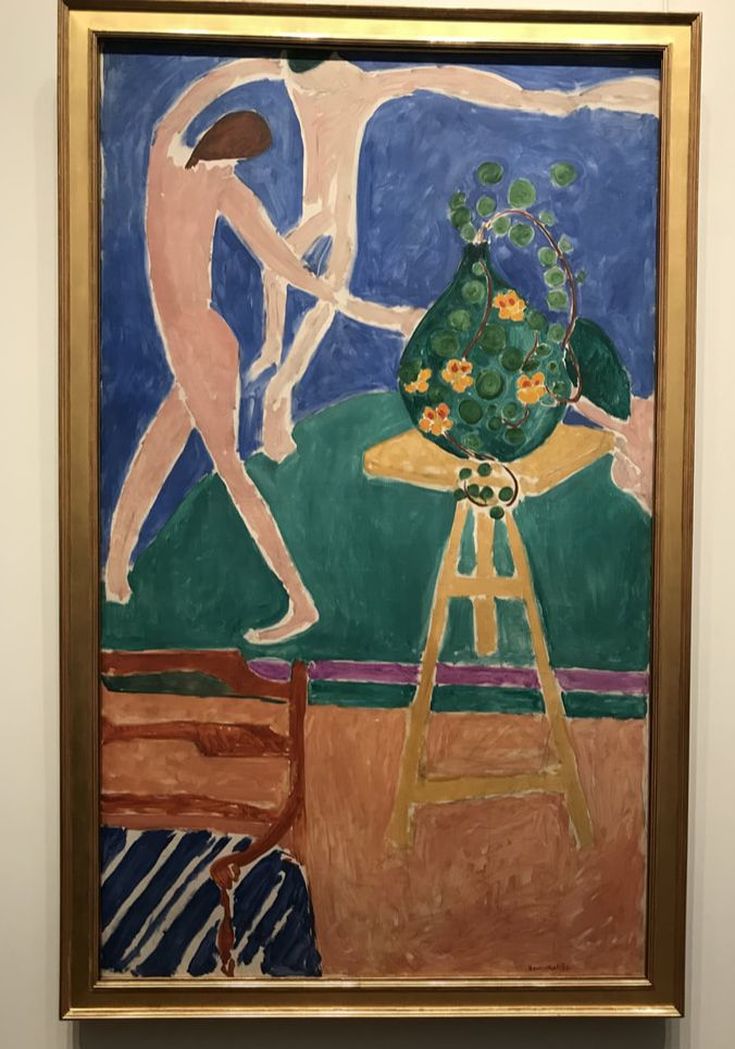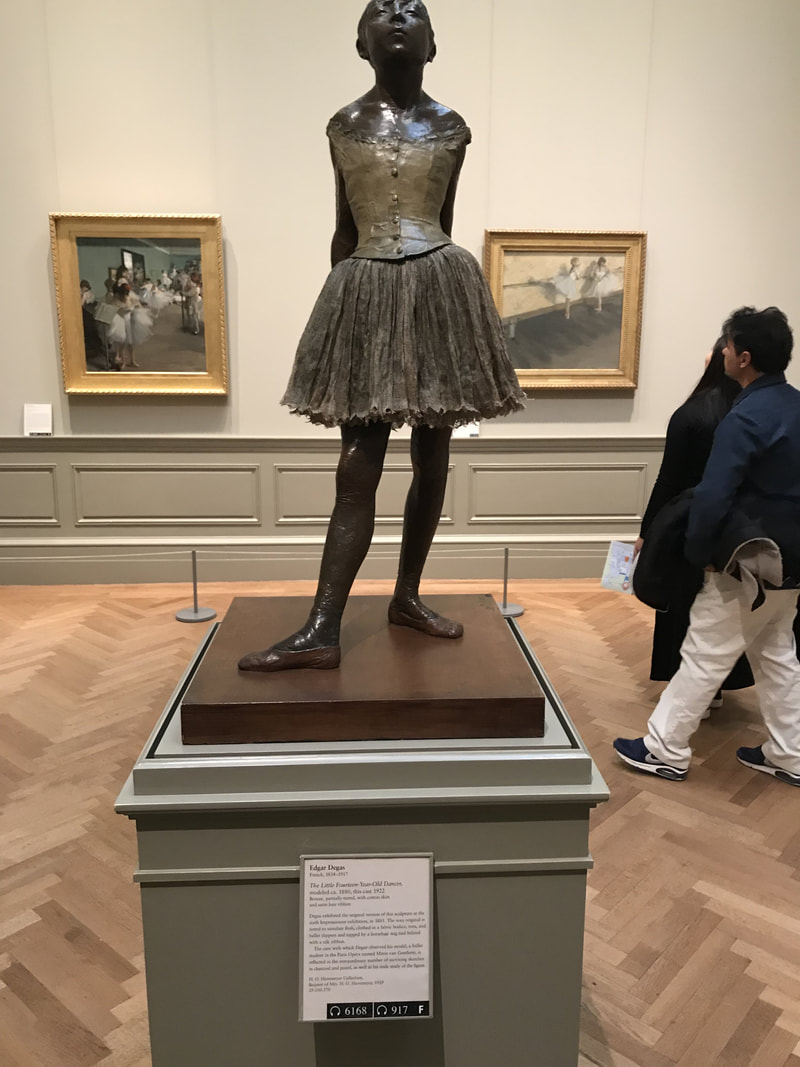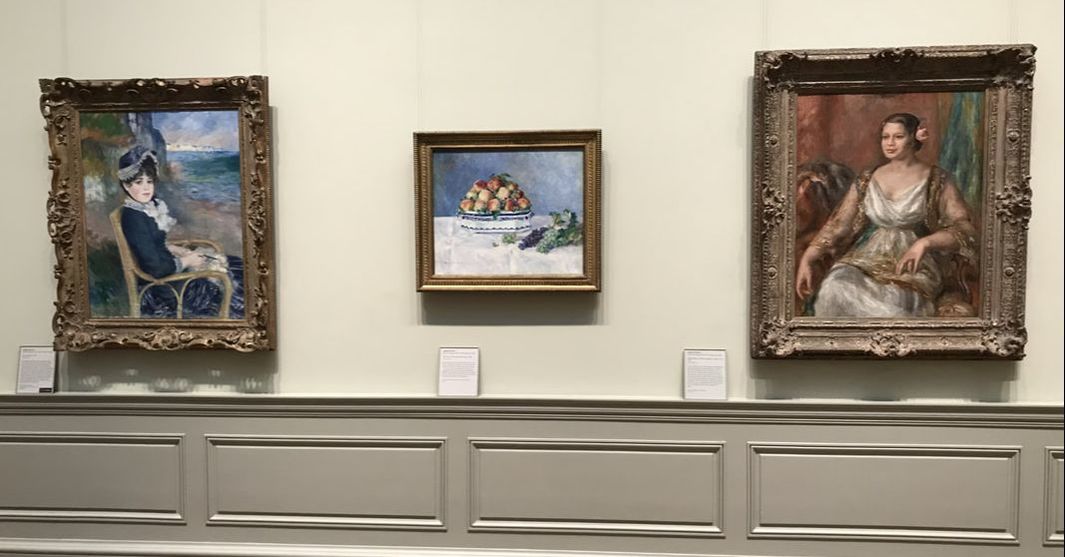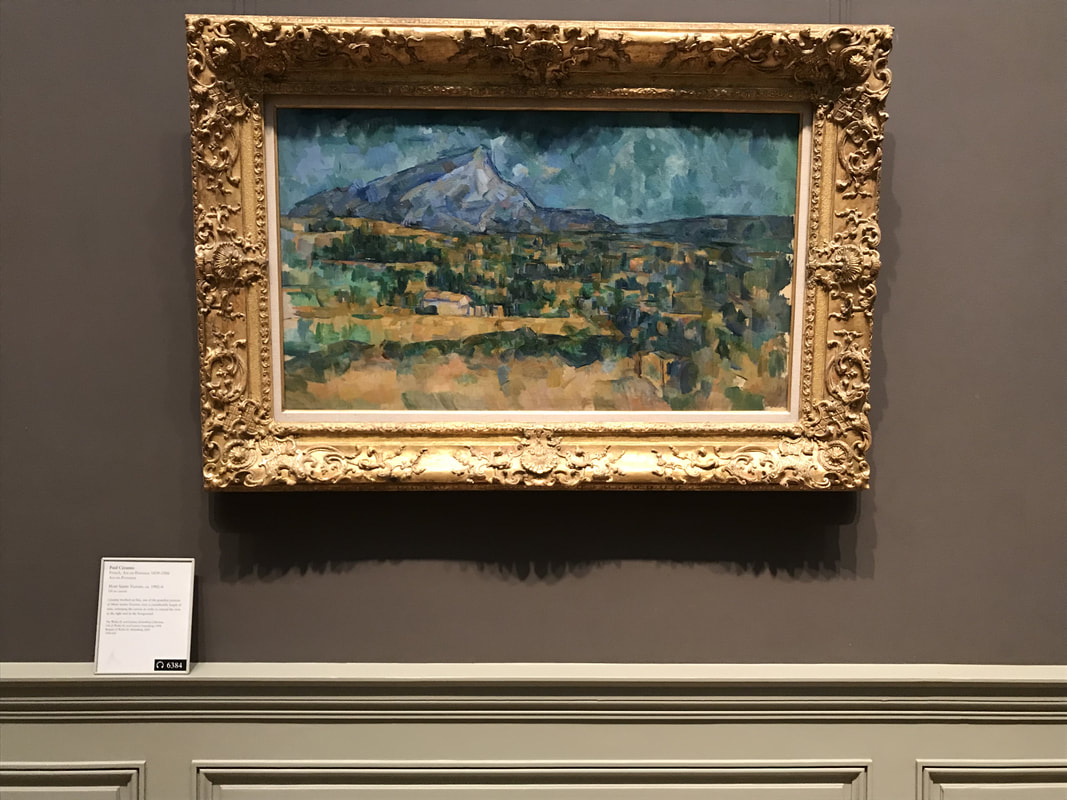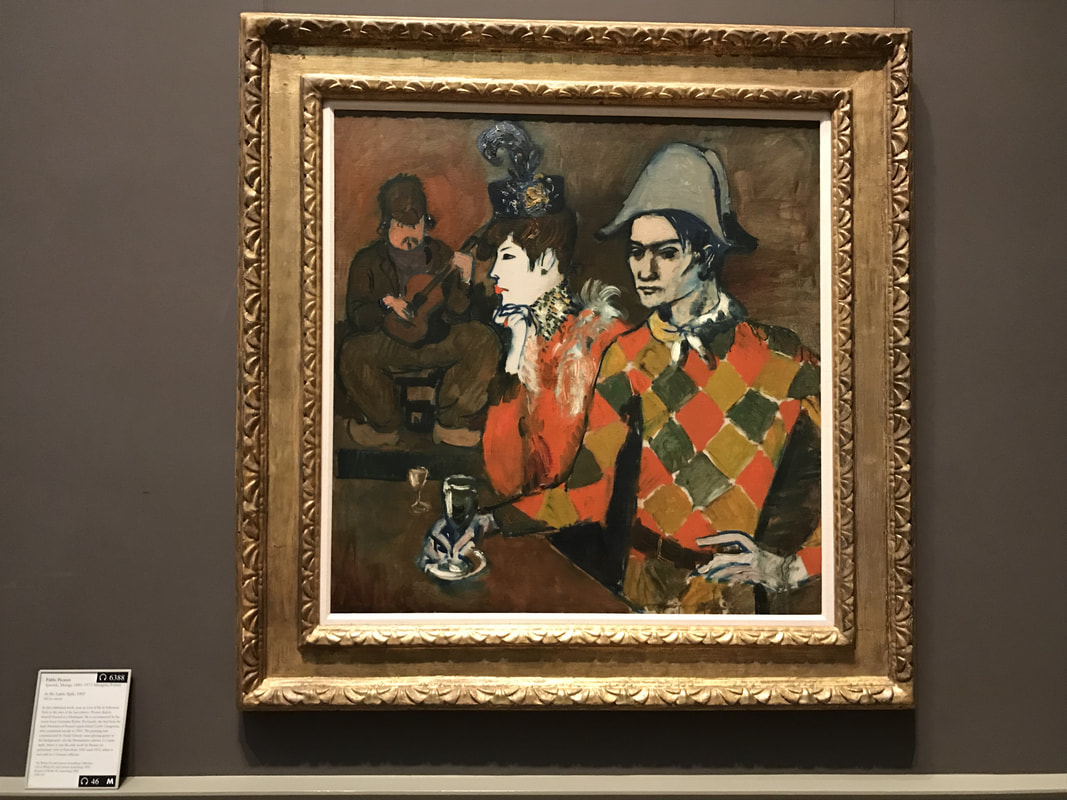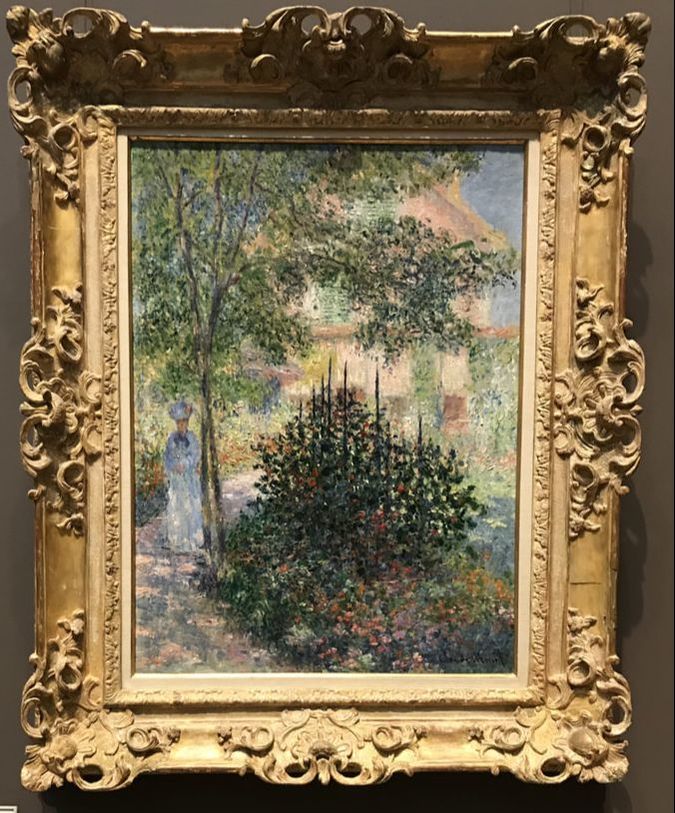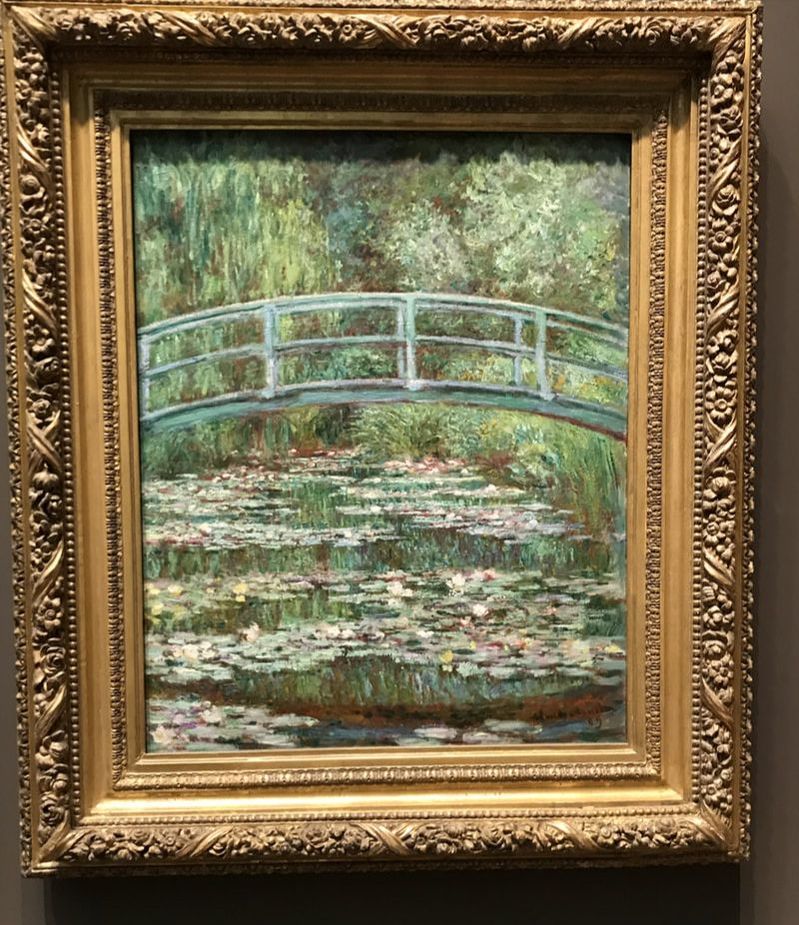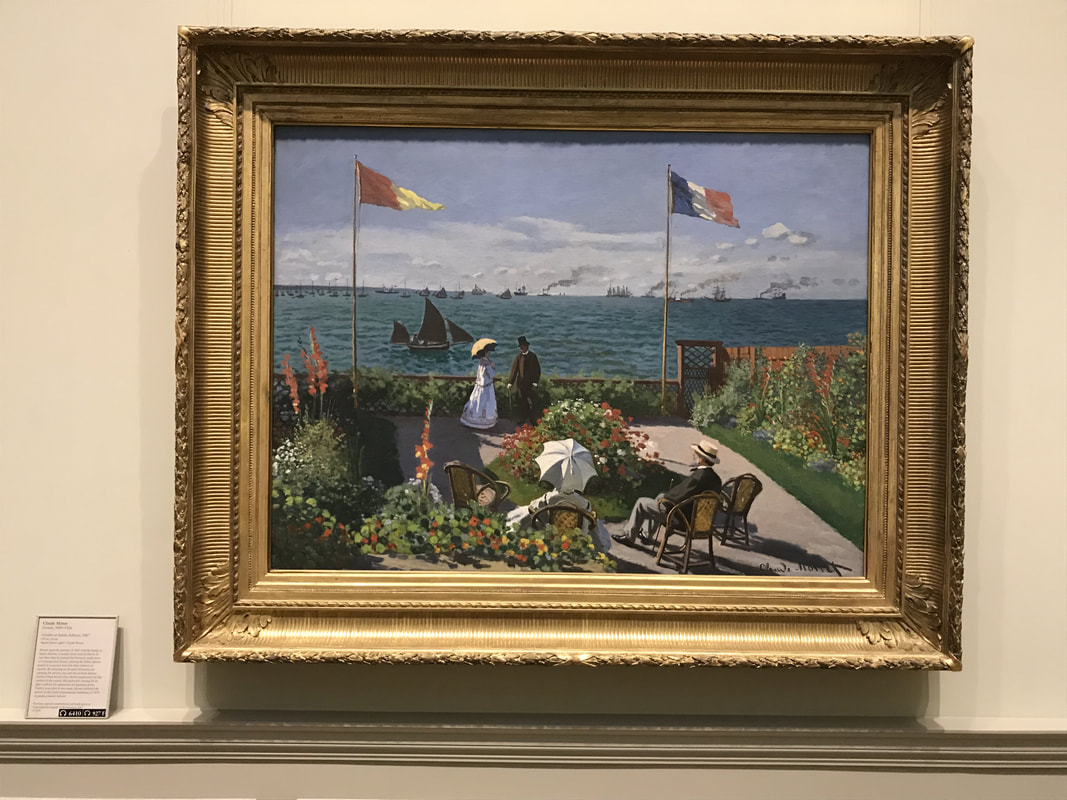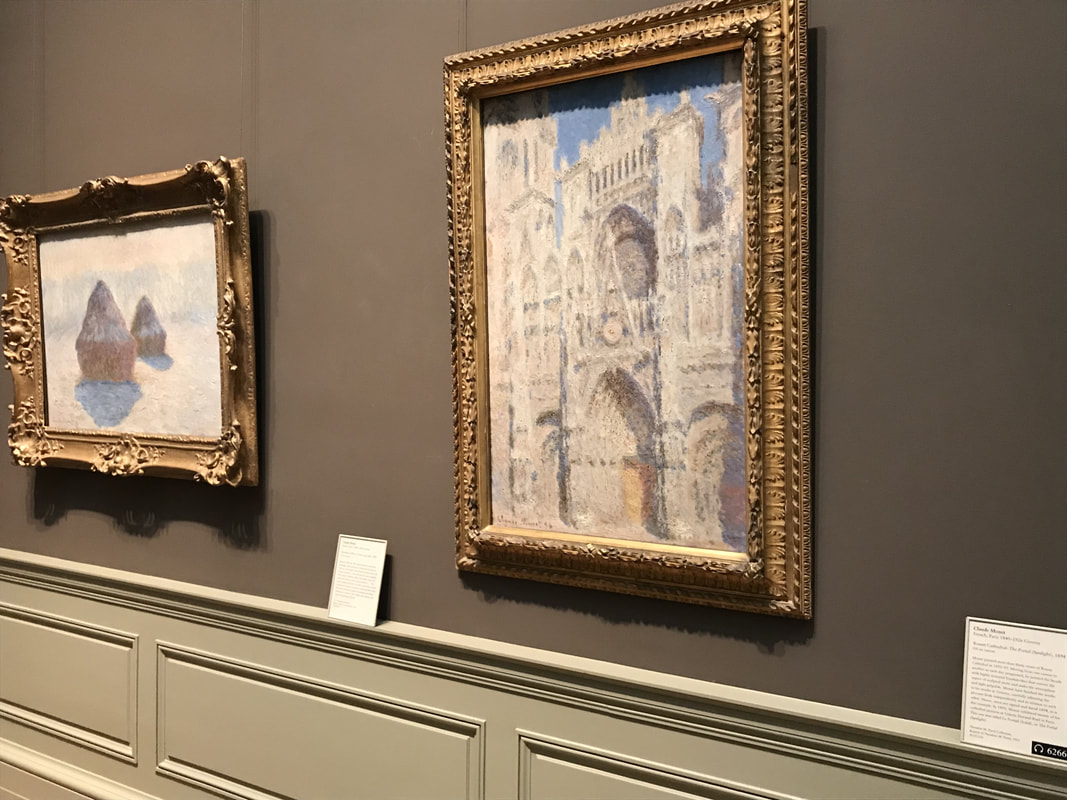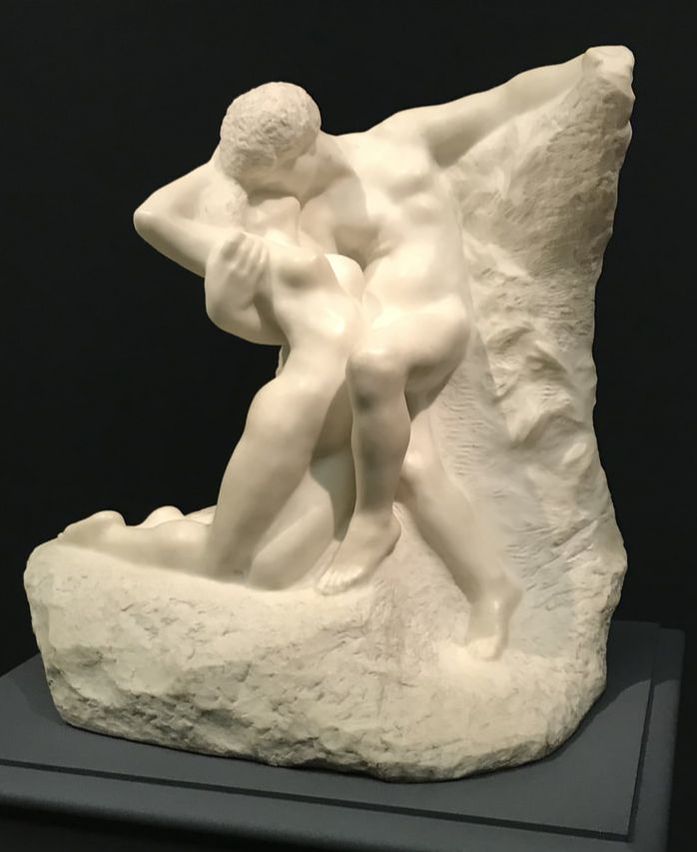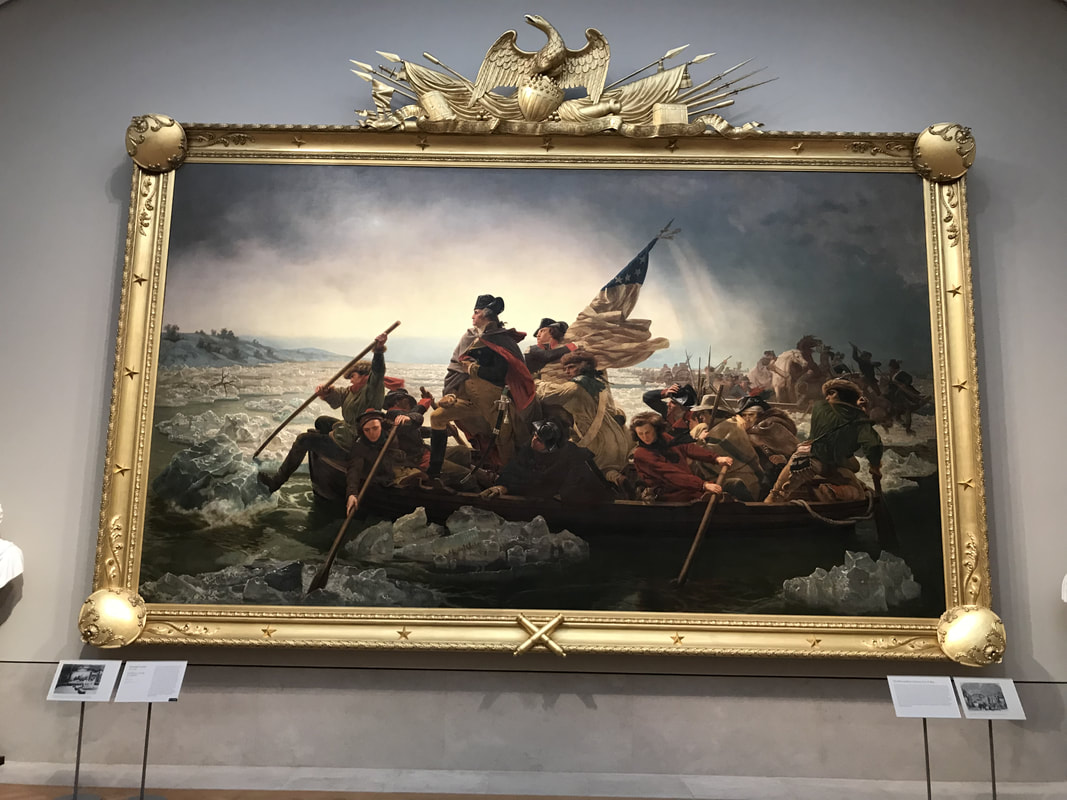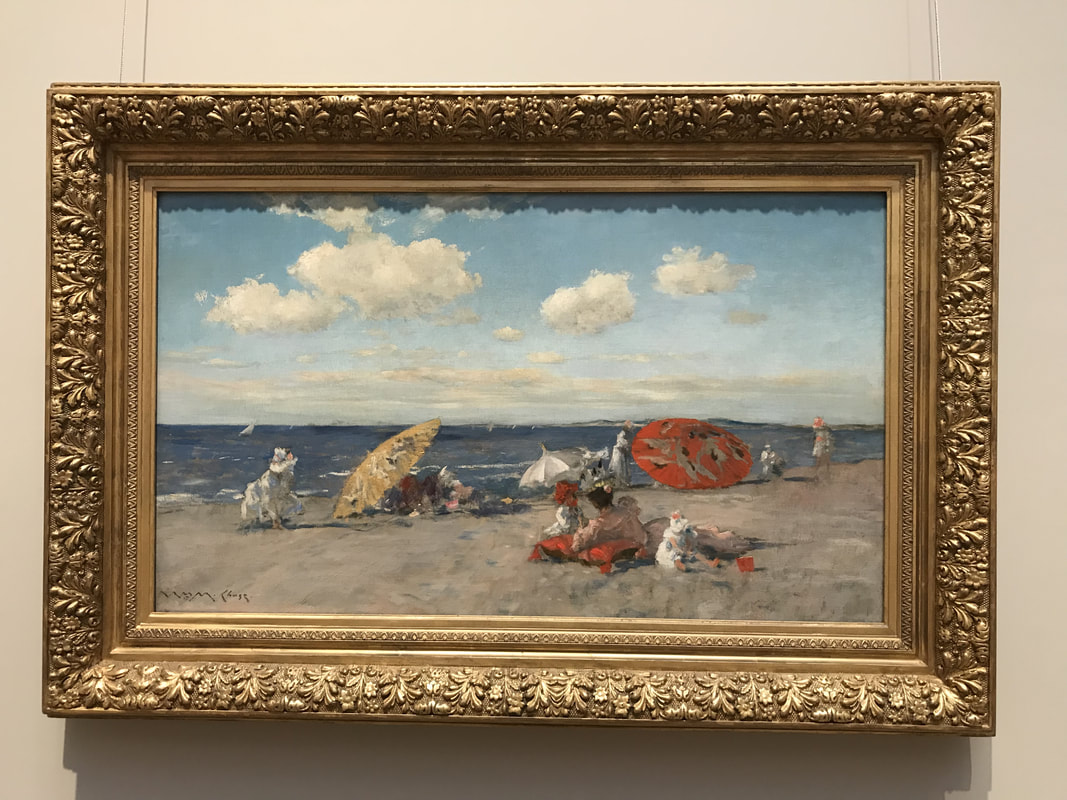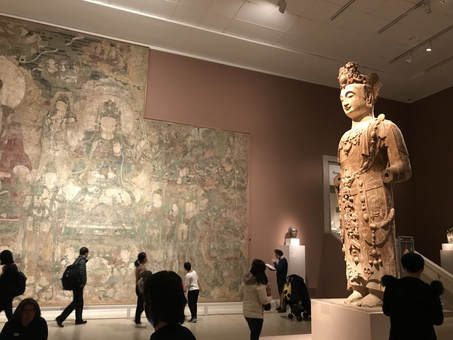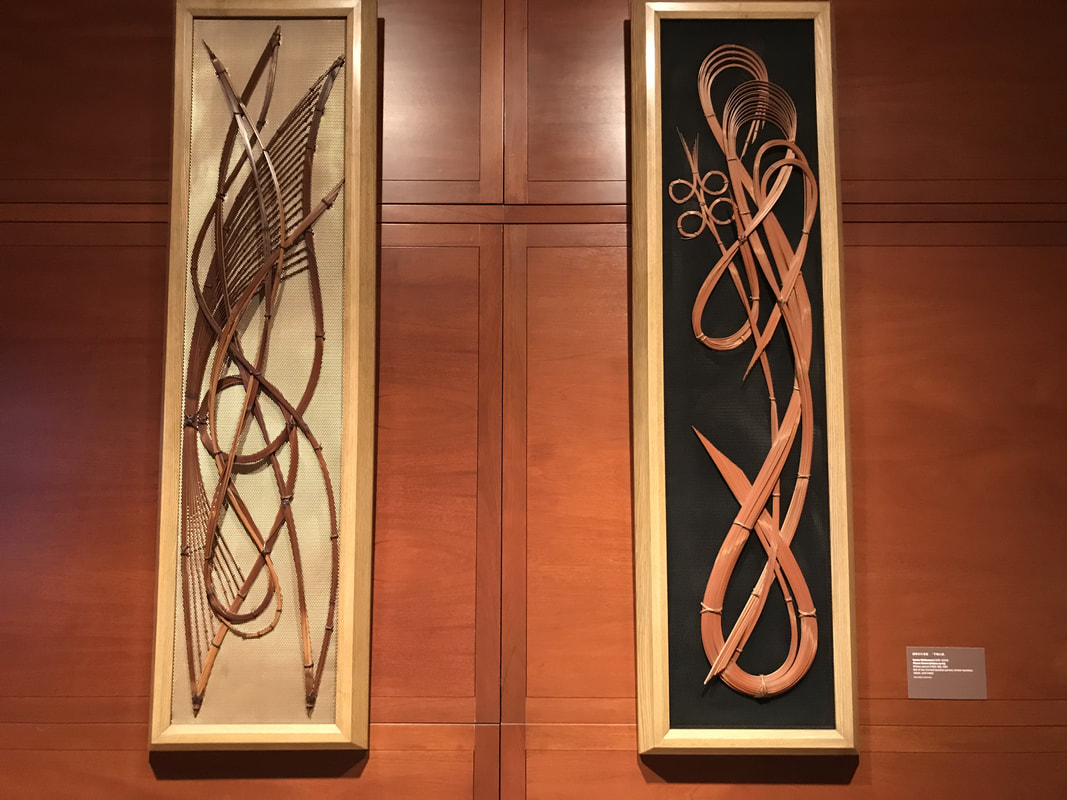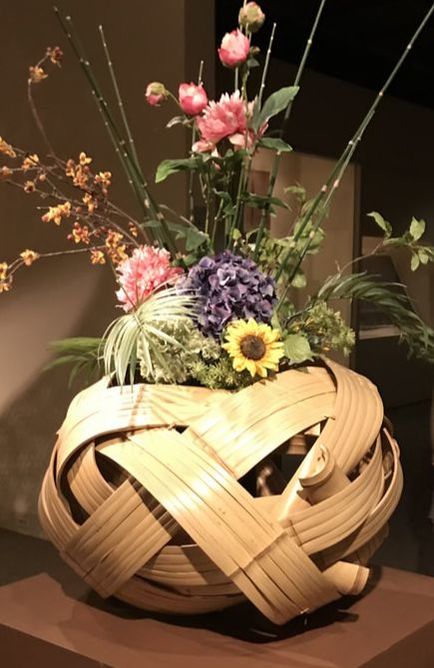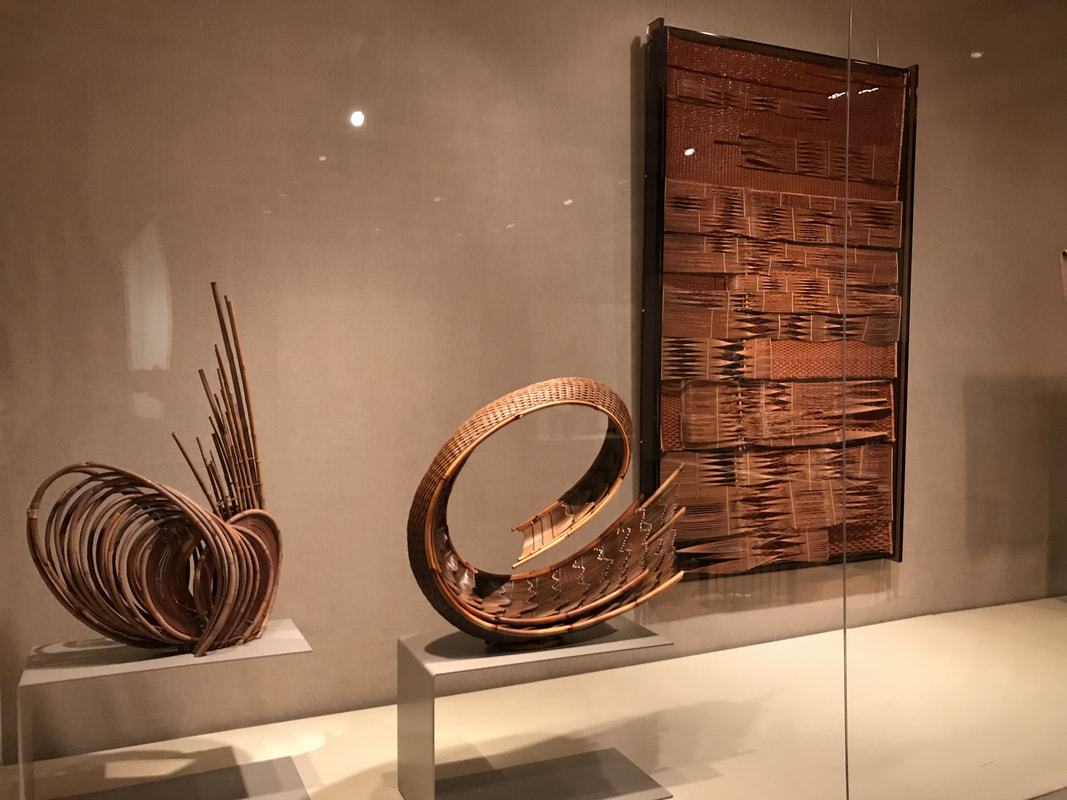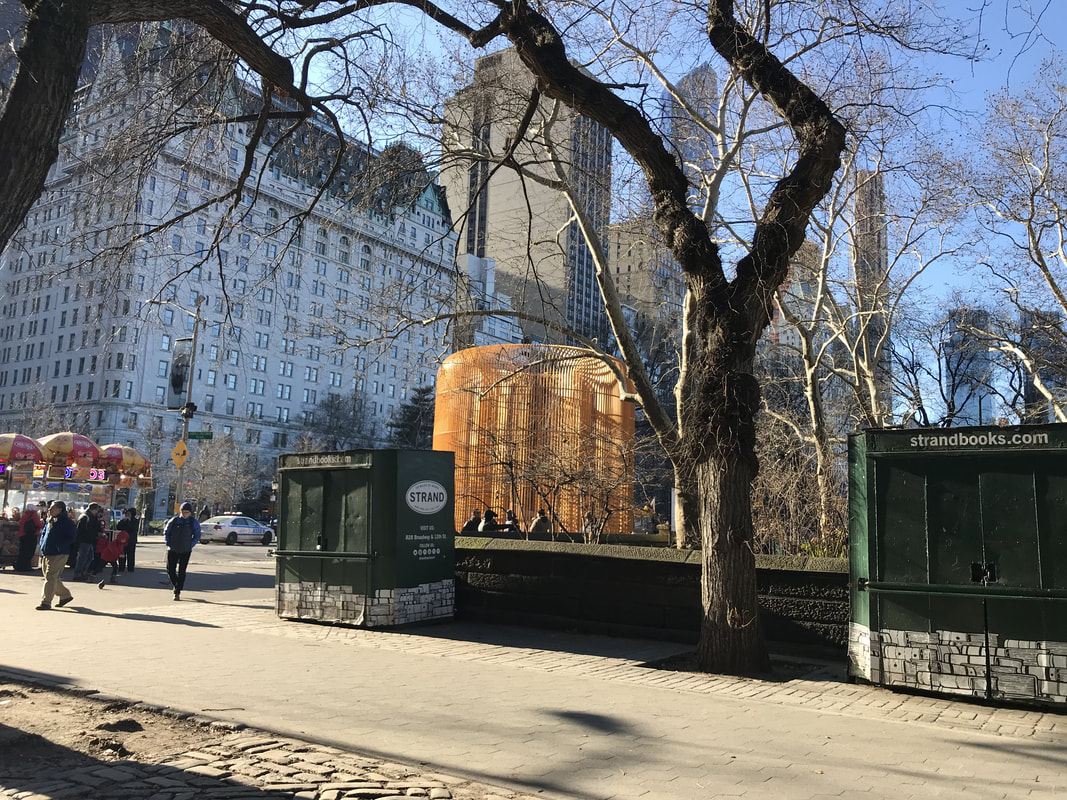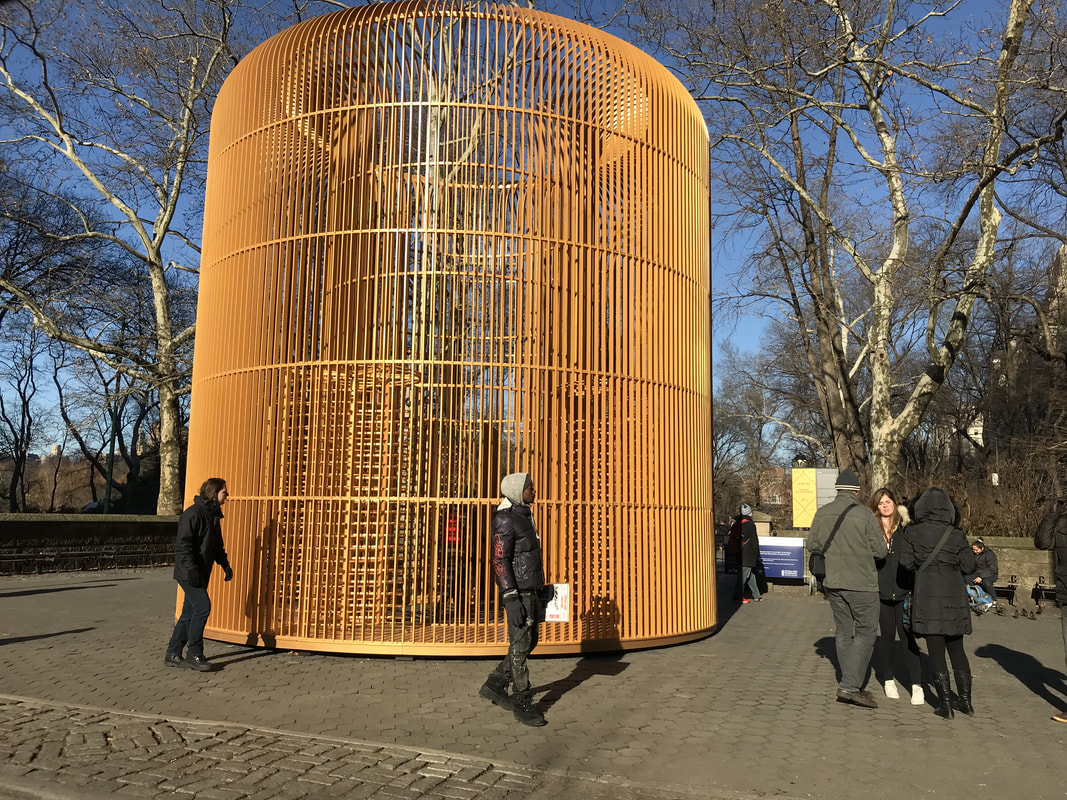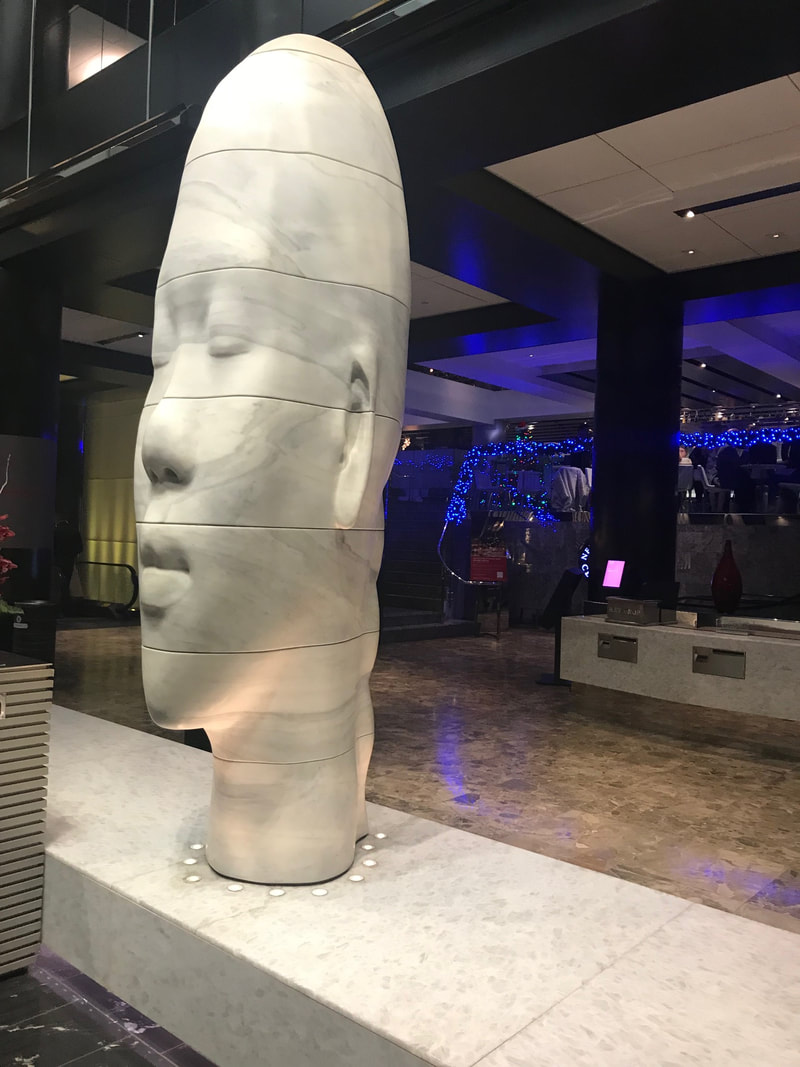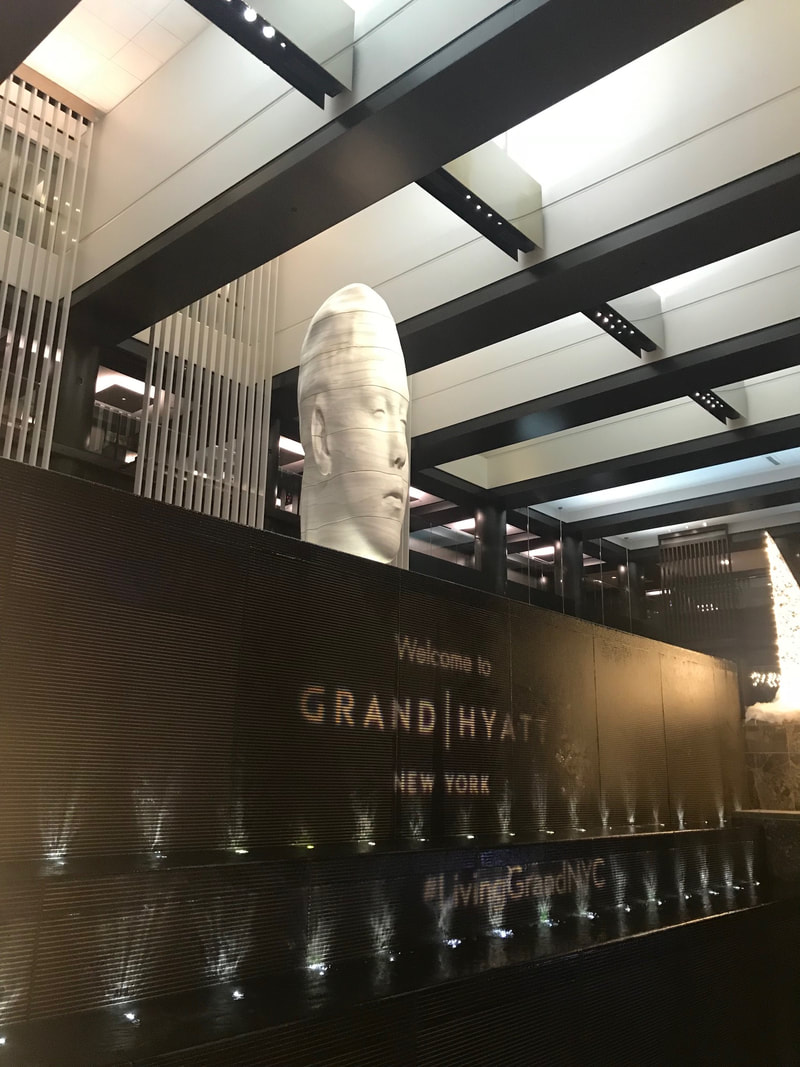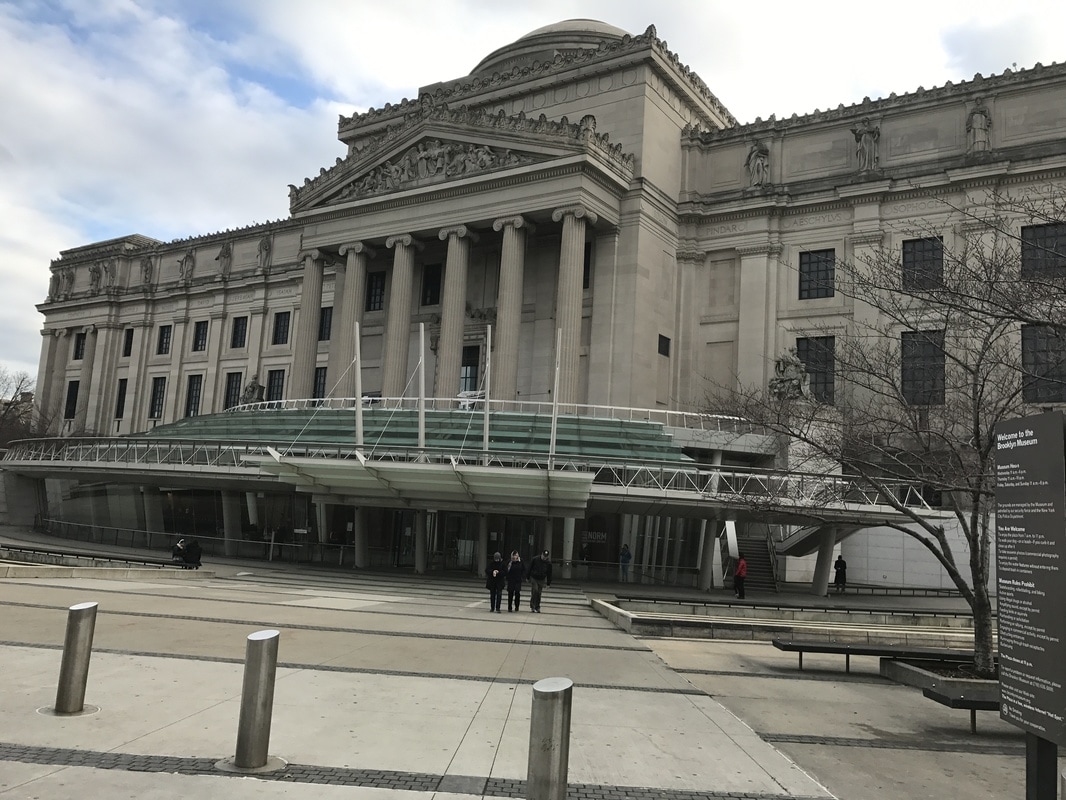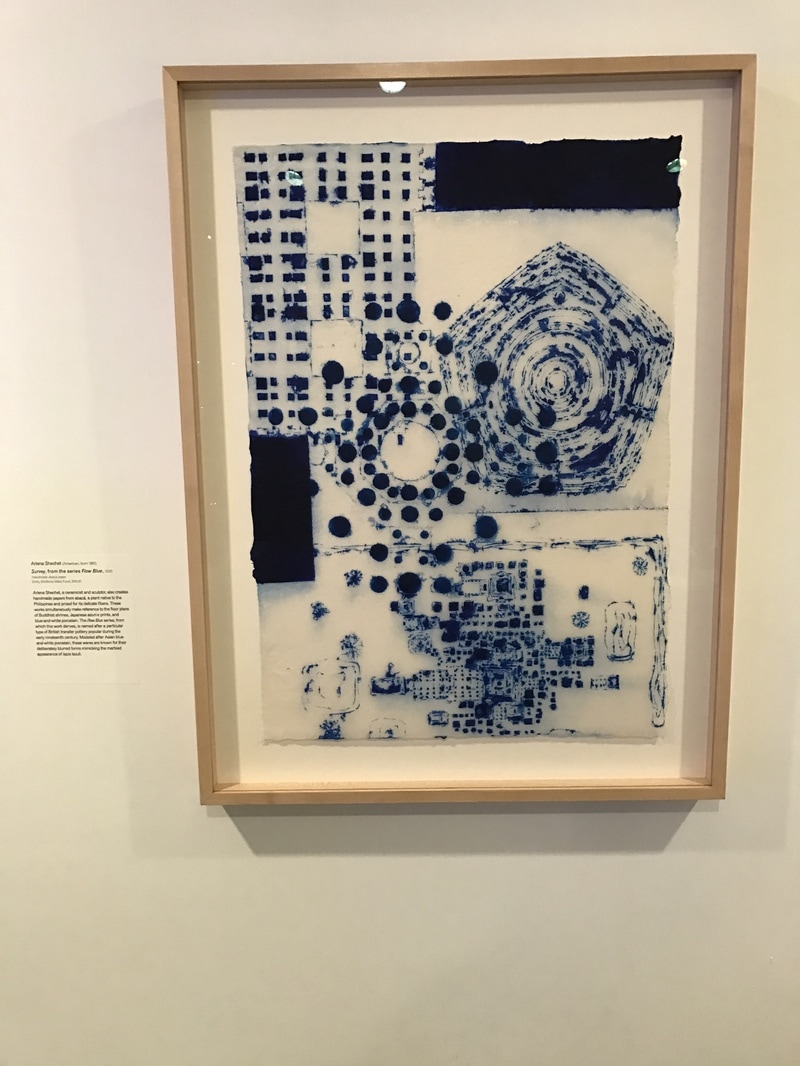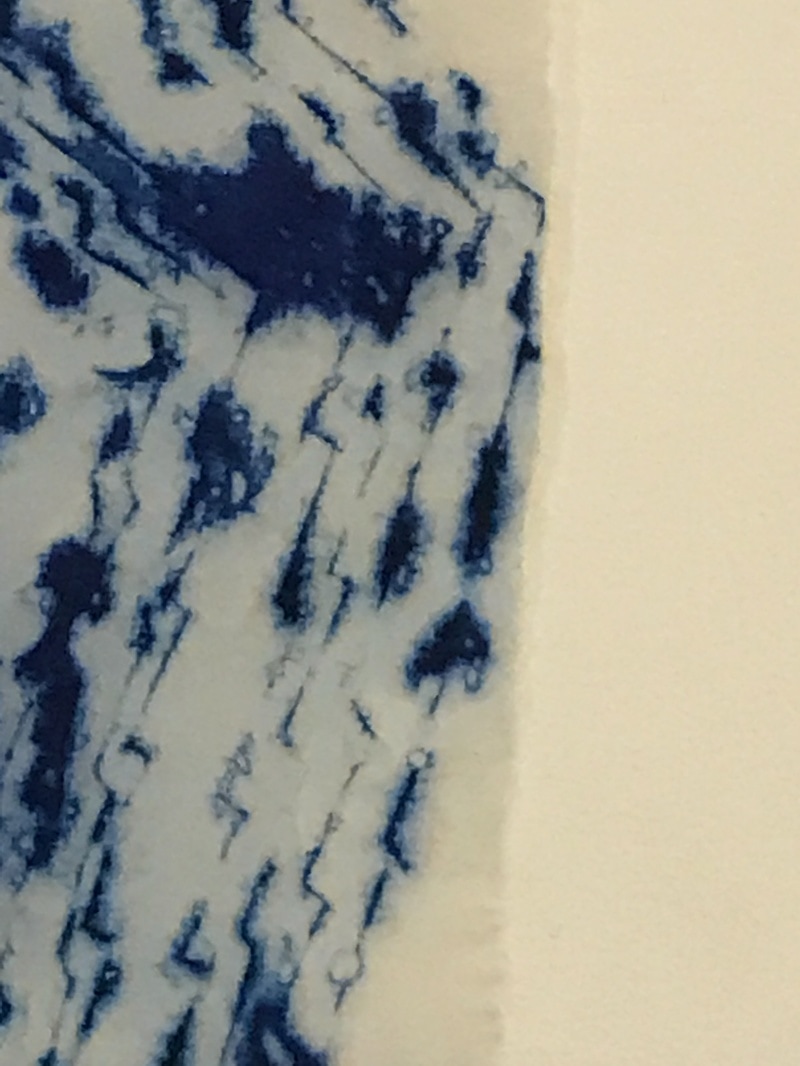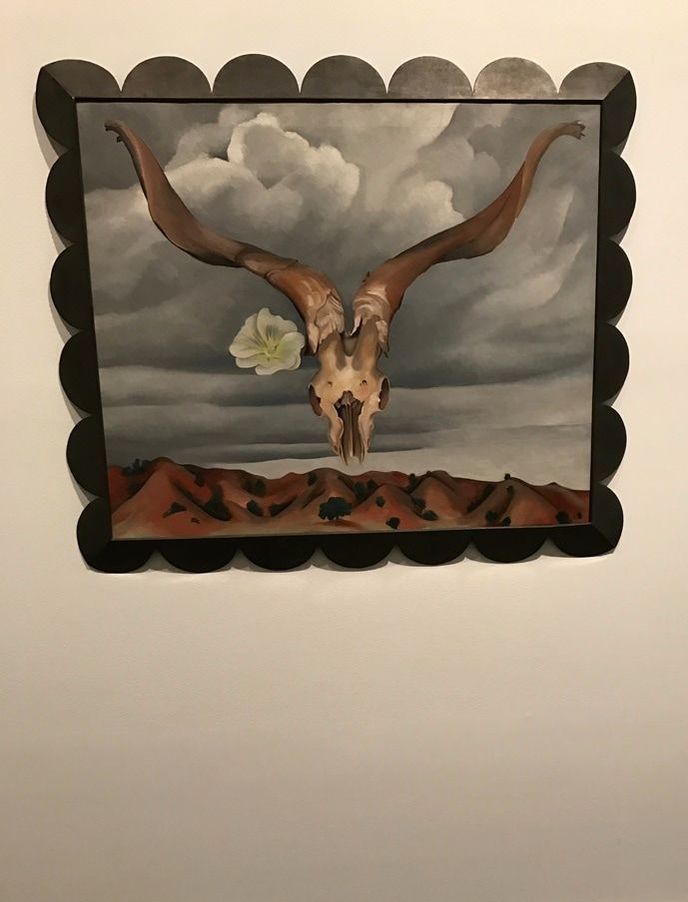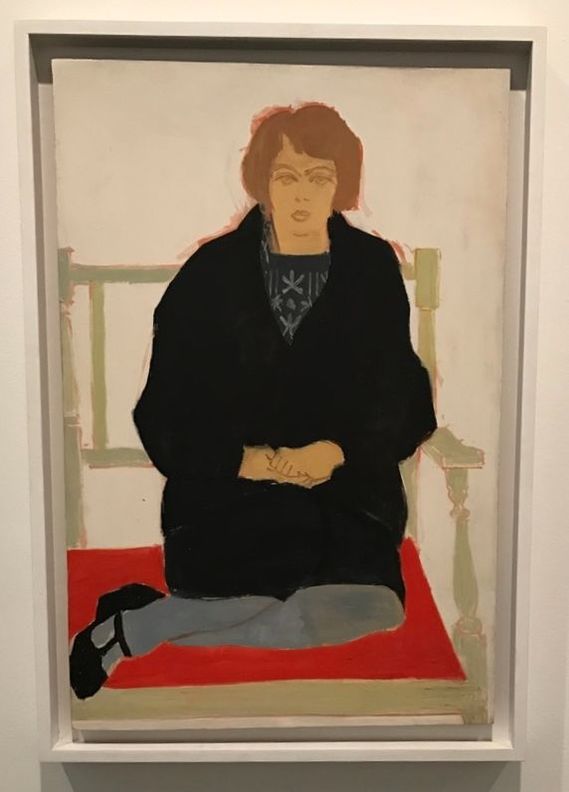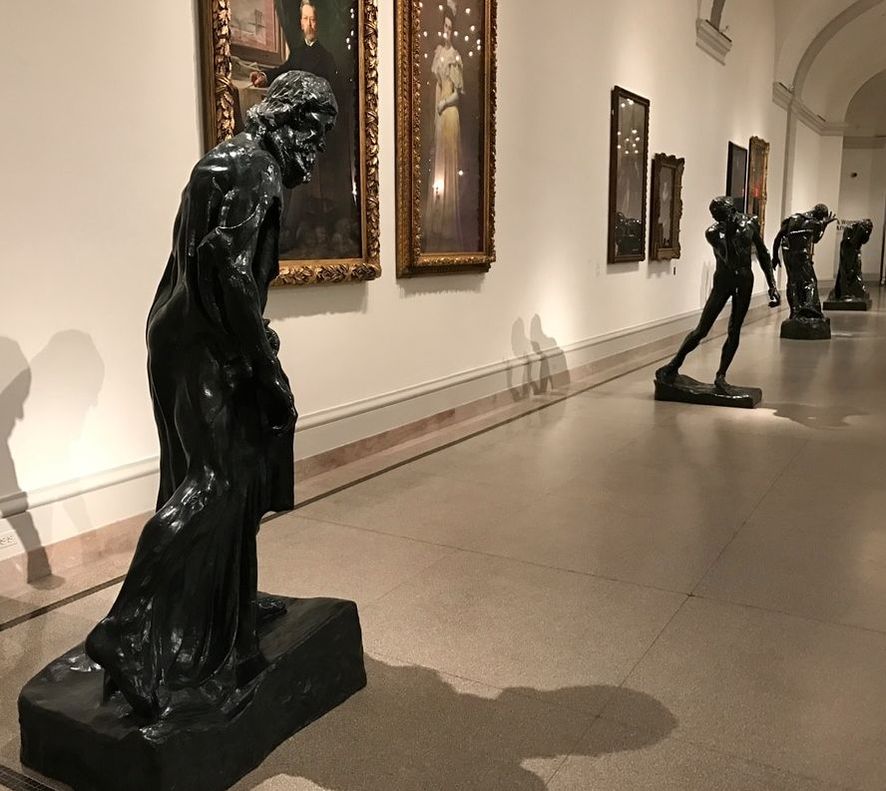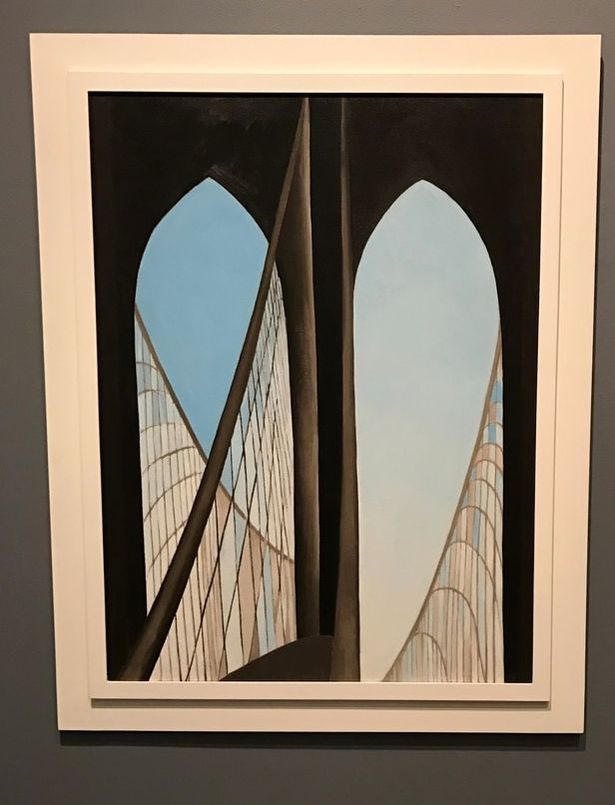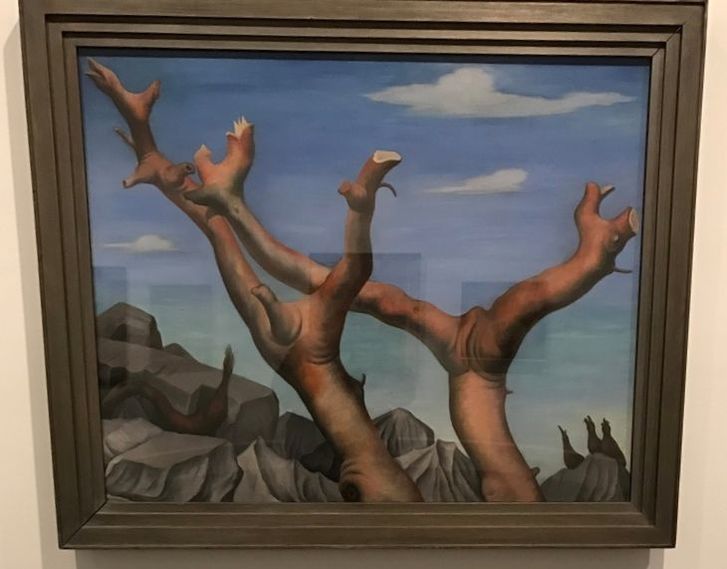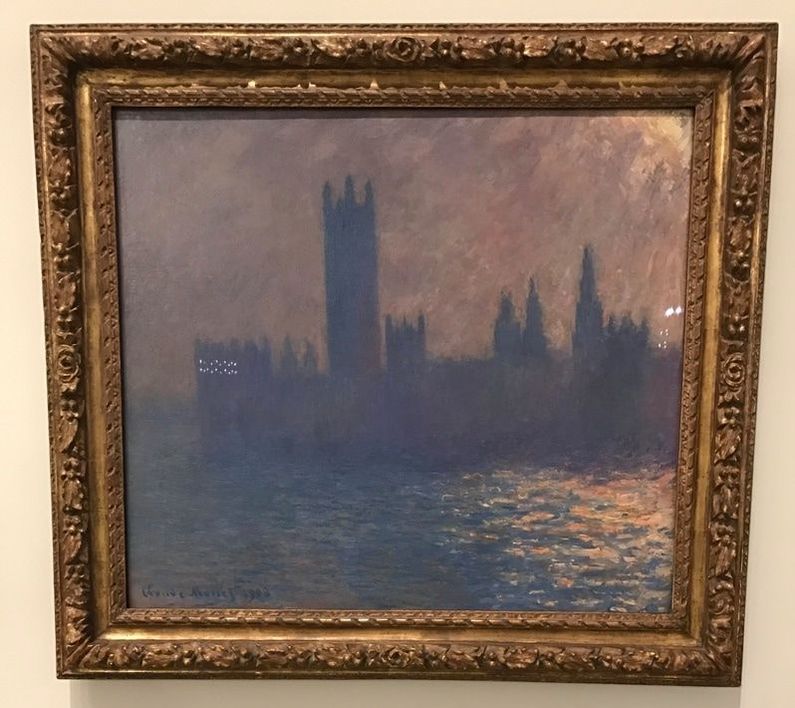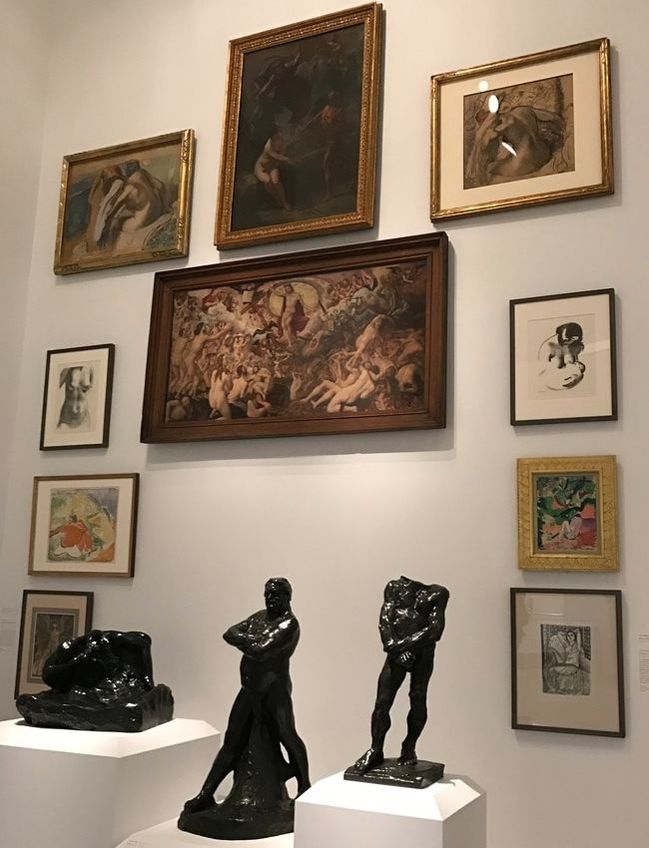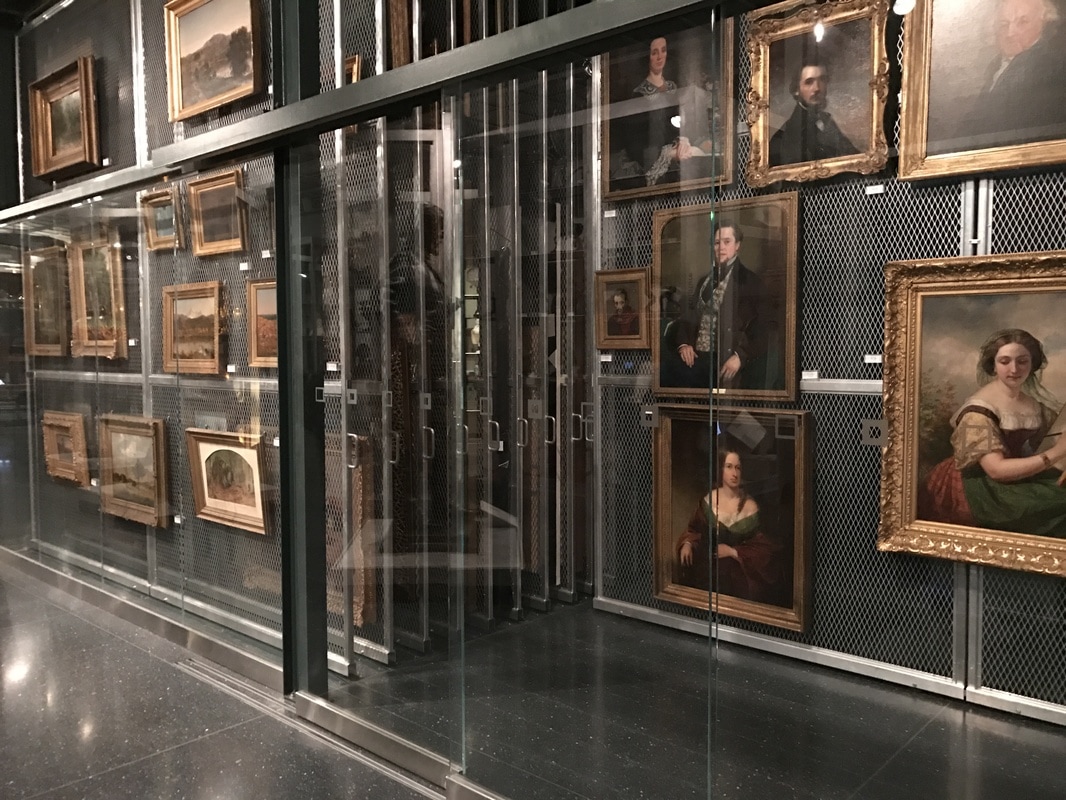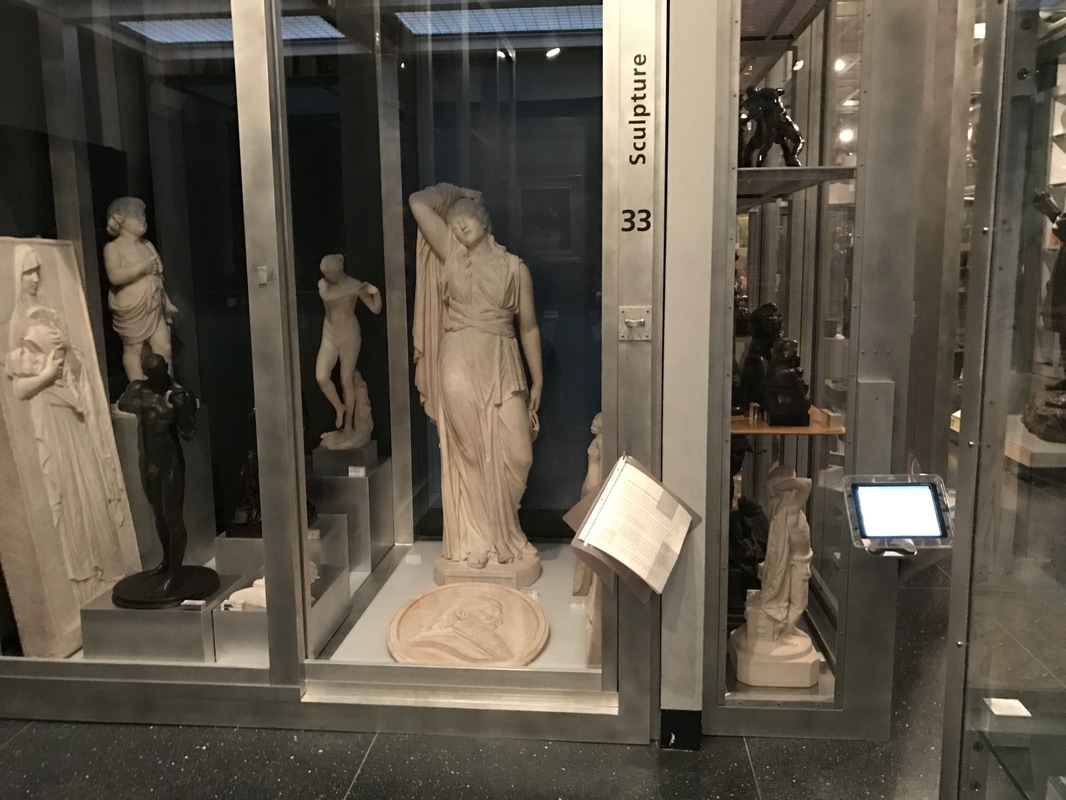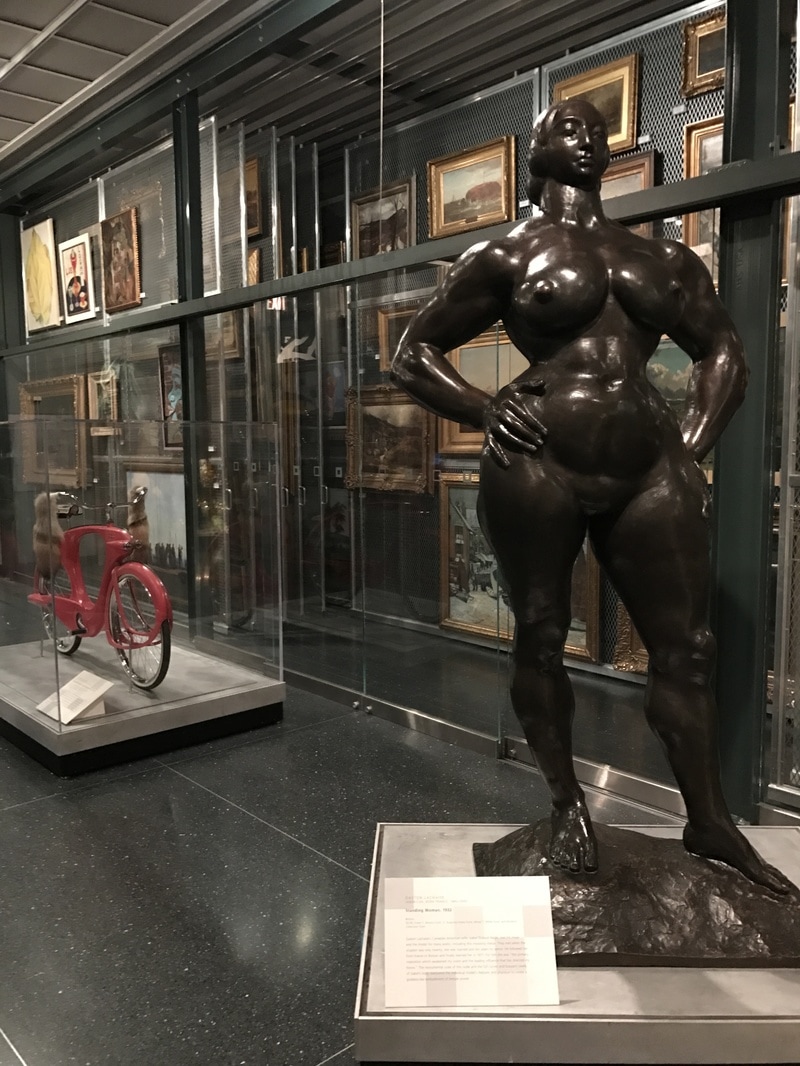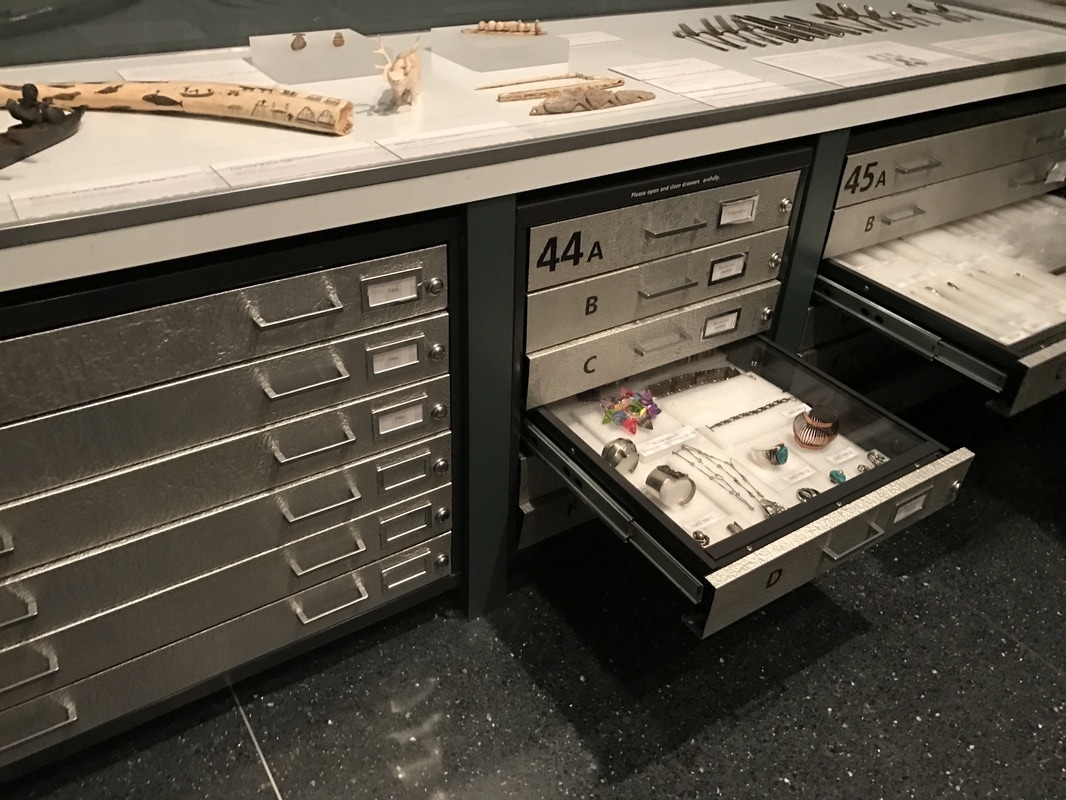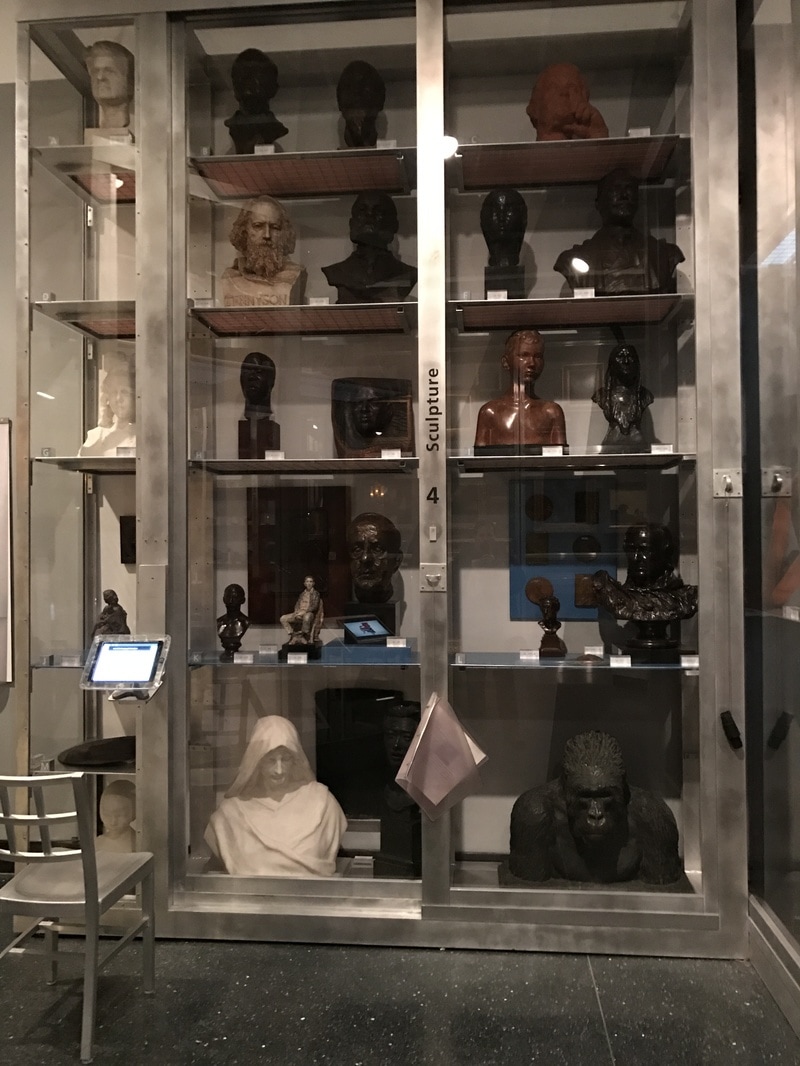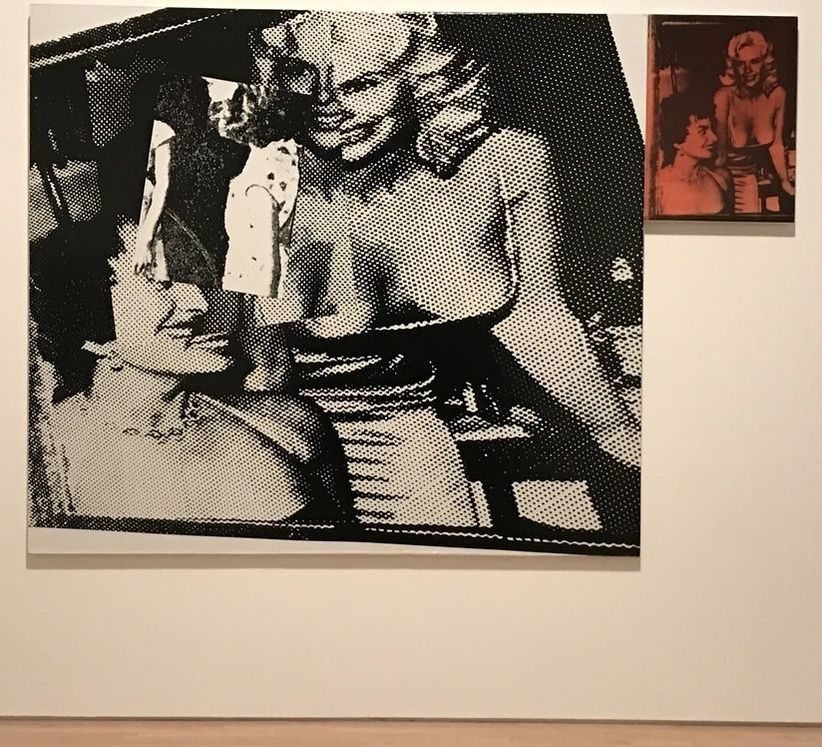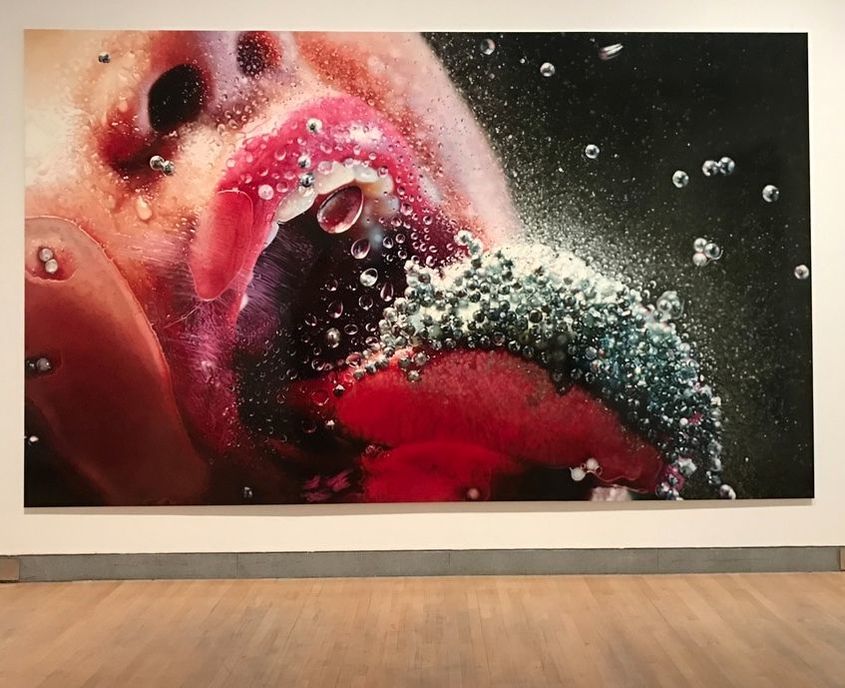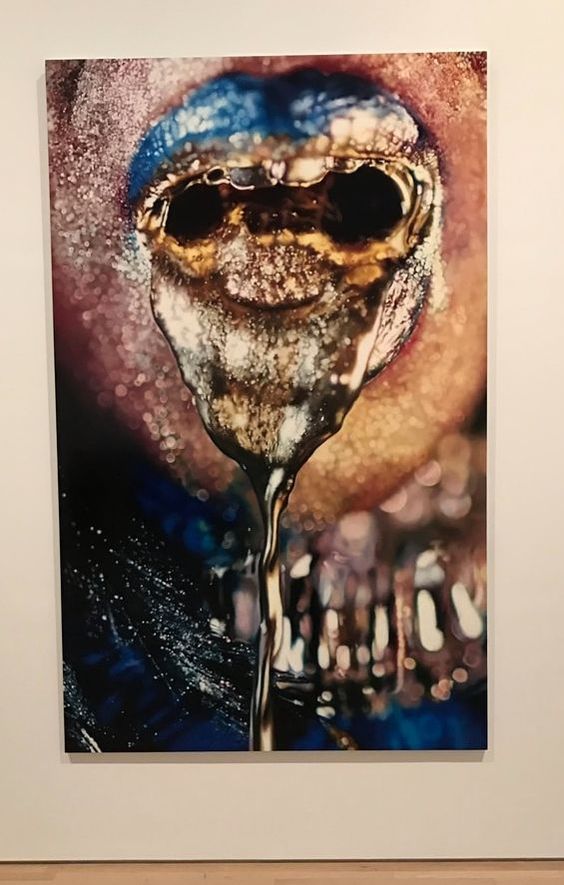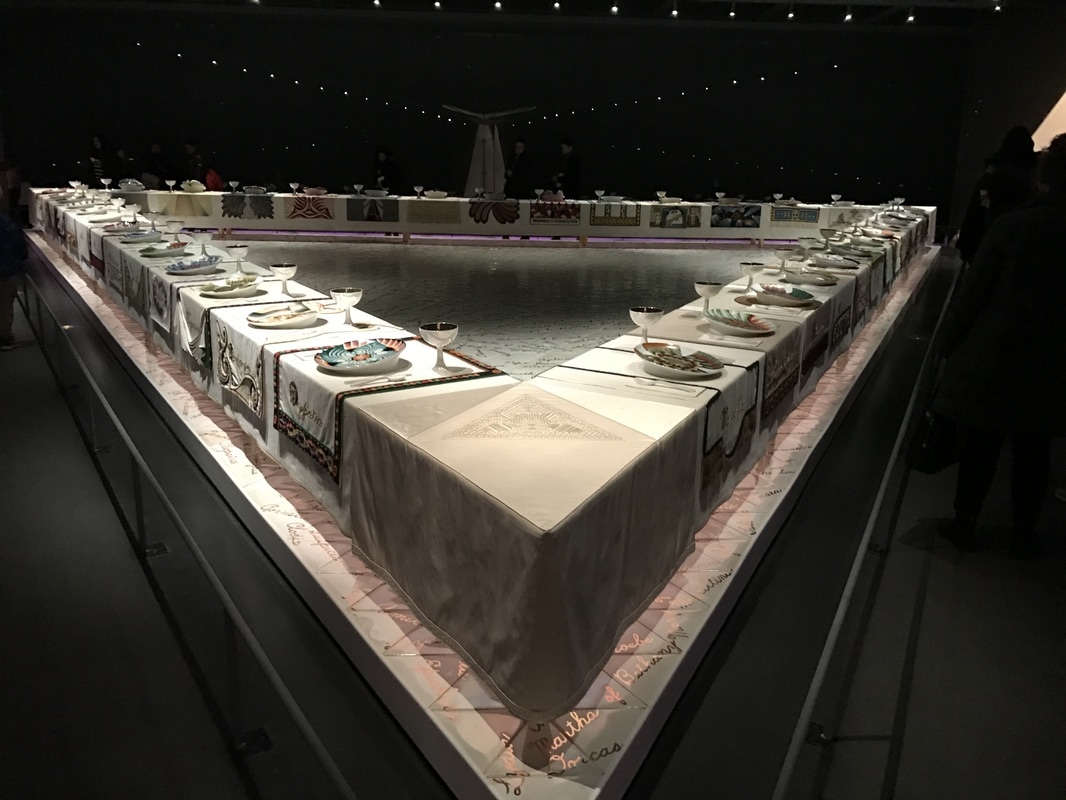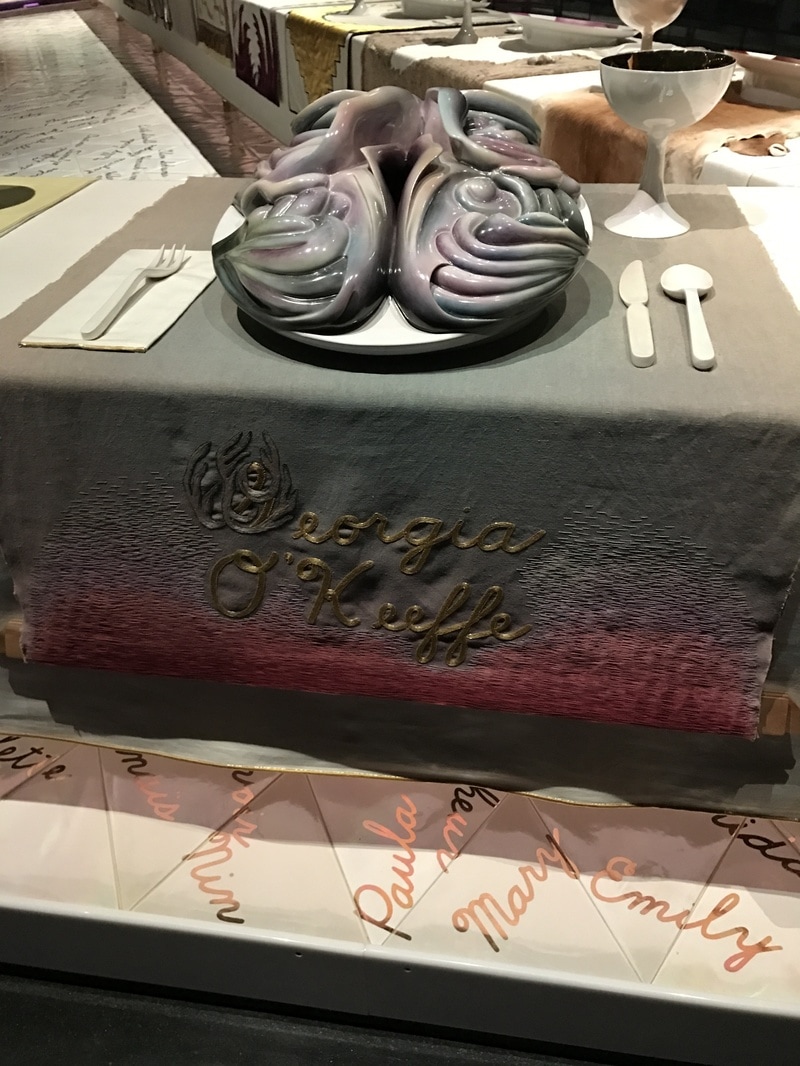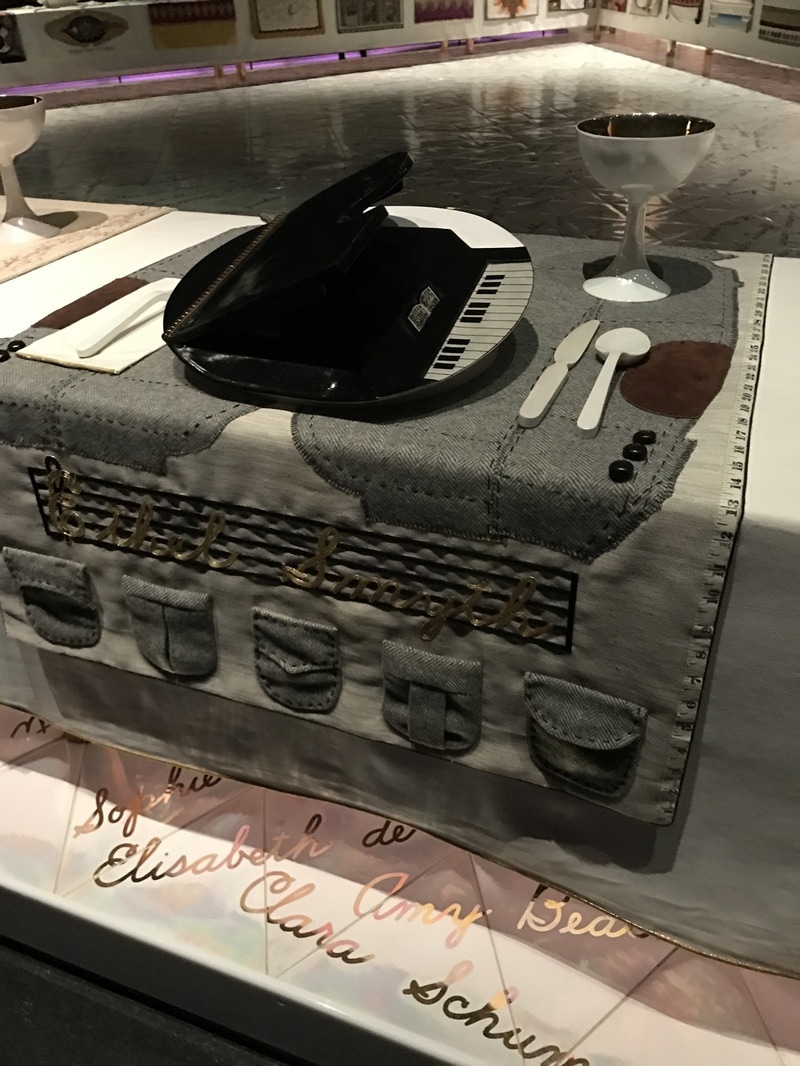Here is Willem de Kooning's 1937-1938 Oil on Masonite painting titled, "Untitled (The Cow Jumps Over The Moon). I learned that de Kooning was trained as a commercial artist and his artistic styles move back and forth between abstract and figurative methods. This painting below is one of his earlier works, which reminds me of Joan Miro's work to some degree. His later artwork, for which he is more well-known, is more gestural and epitomizes the abstract expressionism movement.
I stared at this painting below "Grazing Horses IV (The Red Horses), painted in 1911 by Franz Marc for quite a long time. Not because I love horses, but rather it struck me as fascinating. Franz Marc painted horses a lot, and was known for his preoccupation with animals. I learned that this particular painting was actually his first work of art to enter a museum's collection, the same year it was made. What struck me was his use of unnatural colors in a very natural scene. It's hard to see in the photo, but I was intrigued with the use of bright red in only one or two spots on the horses.
Below is Jasper johns' "The Dutch Wives", encaustic on canvas, created in 1975. If you haven't read my blog article on the Jasper johns retrospective exhibition at The Broad Museum in Los Angeles, you can find it HERE.
Below is a wonderful painting from a German artist that I was unfamiliar with named Corinne Wasmuht. It is titled, "50 U Heinrich-Heine-Str." oil on wood and created in 2009. The painting is a portrayal of Berlin's Heinrich Heine Street subway station and its surrounding neighborhood. It's hard to tell scale from photographs, but this is a huge painting and it's scale immerses the viewer, but the paintings various perspective points and different scales of objects also disorient the viewer. It's really a magnificent painting and I can see why it was gifted to Harvard's Busch-Reisinger Museum. Below are some fascinating samples taken from the Forbes Pigment Collection. Edward Forbes was the director of the Harvard Art Museums from 1909 to 1944. During his tenure, he traveled the world, collecting a large number of pigments for the library. Today, the Pigment Collection contains more than 2,500 samples that are beautifully displayed in cabinets on the 4th floor and are used to this day to help identify pigments used in historical artworks. I came across this wonderful, short video on the Forbes Pigment Collection that was created about 2 years ago. Check it out!
For more information about The Harvard Art Museums, please visit their website: www.harvardartmuseums.org. I definitely recommend visiting the Museum as you're in for a wonderful experience!
0 Comments
In recent years as you've read in my previous blog posts, I visited museums like the Whitney, the Guggenheim, MOMA, the Brooklyn Museum, the New Museum, the Jewish Museum, just to name a few. I encourage you to look through the Categories Listing on the right side of this page and click on what interests you, whether it be museums, cities, or famous artists. The Met has been in the news this past week because it was announced that its admission policy is changing, requiring visitors to pay for admission (the Museum has been pay-as-you-wish for over 50 years). The new admission policy will go into effect on March 1, 2018. Residents of New York State, and students from New York, New Jersey, and Connecticut will remain pay-as-you-wish. Children under 12 will remain free. Be sure to check out their website for more information: www.metmuseum.org I'd recommend purchasing your ticket(s) online and arriving to the Museum when it first opens. You will wish you had more time for your visit if you don't! The line for admission seemed to span the entire length of the huge museum, but having purchased an advance ticket, I was able to walk in a separate door, check in, and head straight into the galleries. Admission will get you into the Met Fifth Avenue, the Met Cloisters, as well as the new Met Breuer. I didn't have the chance to visit the Met Cloisters and the Met Breuer. My visit to the Metropolitan Museum of New York on Fifth Avenue was amazing. First of all, it is massive. I forgot just how large the museum is that is located on the Upper East Side on Fifth Avenue between East 80th and East 84th Streets. This blog post covers my experience of the Metropolitan Museum of Art on Fifth Avenue, mainly what was on exhibit in their Modern & Contemporary Art galleries, 19th and Early 20th Century European Paintings and Sculpture, and some of their Asian Art collection. There were also two special exhibitions going on that I'll include: One on the hugely talented artist David Hockney. And the other on an artist that you may have heard of before, Michelangelo! At the end of this blog, I'll include a few other artistic surprises outside of the Met I encountered on my trip to NYC.
In Marc Chagall's painting shown below, "Le Pont de Passy et la Tour Eiffel," painted in 1911, we experience a fascinating view of Paris and the Eiffel Tower. The important thing about this painting is its composition. Chagall uses several converging diagonal lines: the bright red road, the orange cement wall, and the lines denoting the blue sky. If you think about the time period of the painting, it's interesting to note how it depicts some of the modern changes to the city of Paris, including the Eiffel Tower, the construction of the Pont de Passy Bridge and technologically modern train, electrical power-lines, and how it is juxtaposed alongside the element of the horses and wagon alluding to and earlier time in history.
With the onset of the Industrial Revolution, painters like Fernand Leger incorporated streamlined forms and contours of assembly-line production into their artwork. In the painting shown here, "Three Women by a Garden" painted by Fernand Leger in 1922, three generations of women are depicted. "Woman with a Cat" was painted in 1921.
Piet Mondrian is one of my favorite artists. Here is one of his iconic paintings called, "Composition" completed in 1921. It's an early example of the geometric style of painting that Mondrian called Neo-Plasticism, that emphasized planar relationships in painting, architecture, and design. Many people who look at my own personal artwork sometimes comment that they see hints of a Mondrian influence in my artwork. Here is Mondrian's painting at the Met, next to one of my paintings! Mondrian used black lines to divide the canvas into rectangles that are sometimes painted in shades of blue and red, creating lighter hues by mixing primary colors with white. Later on in his artistic process, Mondrian stopped creating these hues and used pure, primary colors. In comparing his painting with mine, we each use an entirely different process to create our black lines and blocks of color. If you notice, the black line at the bottom right of his painting doesn't quite reach the bottom. To me, it detracts from the overall design. Here are two other artists, whose works are hung alongside Mondrian's at the Metropolitan Museum of Art. I love Jackson Pollock's artwork! The painting below is called "Number 28" and was painted in 1950. His drip and pour paintings are widely recognized as his greatest achievement in art. He used simple sticks or paint stirrers and enamel house paint, sometimes poured right from the can, spilling lines directly onto raw canvas spread on the floor. What I love about his paintings are that the paint on the canvas we see is a record of the artist's creative process and his movement as he walked around all the sides of the canvas. One of the Special Exhibitions on display during my visit was "Michelangelo: Divine Draftsman and Designer." Michelangelo Buonarroti lived from 1475 to 1564 and is celebrated for his excellence of the power of drawing and invention that provided the foundation for all the arts. His drawing skills, design, sculpture, painting, and architecture all combined to give him the reputation of "The Divine One" by his contemporaries. The exhibition showed a range of over 200 works by the artist that was pulled together from 50 public and private collections across the United States and Europe. The exhibit opened in November and is on view through February 12, 2018. Below are just two of his incredible artworks I saw at the Met. #MetMichelangelo During my visit there was a magnificent exhibit of the British artist David Hockney that showcases 60 years of his art career. I highly recommend visiting this exhibit that is at the Met Fifth Avenue through February 25, 2018. David Hockney's painting address translating movement, space, and time into a two dimensional painting. Hockney is probably best known for depicting California swimming pools and backyards in the mid-1960s. Many of his paintings are quite large, perhaps over 6 or 7 feet square. I love how he uses Acrylic paint on canvas.
Alexander Calder created a series of moving sculptures called mobiles that he created in a diverse range of abstract configurations. Shown here, is a free-moving wind mobile that is carefully balanced on a movable pivot point. I learned that he was inspired by the work of Joan Miro, and the similar shapes and forms can be observed in Calder's mobiles. In the video below, you can see the kinetic nature of his mobile, "Mobile" created in 1941 from painted aluminum, steel, steel rod, and wire. Here are some of Claude Monet's masterpieces...
And lastly, I came across these wonderful sculptures created by artist, Jaume Plensa, that are permanently installed at the Grand Hyatt Hotel near Grand Central Terminal. I learned that these two huge sculptures are reminiscent of the Moai sculptures on Easter Island. Overall, my visit to the Metropolitan Museum of Art was simply amazing. I could have spent the entire day looking at all the art and taking photos of every piece of artwork, but I could only include these 6 dozen or so photos! I wish I had the time to visit Met Cloisters and Met Breuer as well. Well, reason for another visit! I hope you enjoyed this blog and I welcome your comments! Have a friend who would enjoy reading this blog? Then please share it with them via email or social media! You can click on the Facebook and Twitter buttons below! PS: If you liked this article, you might like these other articles on my artistic travels:
Kennebunkport, Maine Los Angeles, California New York City Street Art Napa Valley, California Park City, Utah Barcelona, Spain Caribbean Art
 If your favorite color is blue, like it is mine, then you'll enjoy the exhibit at the Brooklyn Museum called, "Infinite Blue." The exhibition's title hints at the connection between the color blue and the idea of spirituality as written by Russian artist Vasily Kandinsky, "On the Spiritual in Art." Blue is often associated with the heavens and the spiritual because blue is the color of the sky. The artwork featured in "Infinite Blue" feature every variety of the color blue from ancient times to the present. The exhibit includes a wide range of artwork from the museum's permanent collection of Asian, African, Egyptian, American, Native American, and European art: paintings, sculpture, prints, drawings, etc. My understanding is that this exhibit will expand to other areas of the first floor of the museum over time. My favorite blue is Cobalt Blue. On display were a variety of blue and white ceramics from the Middle East. The use of Cobalt in the Middle East likely inspired the Chinese to use the pigment. In the artwork below and the detailed close-up, artist Arlene Schechet has created handmade papers from abaca, a plant native to the Phillippines. The Flow Blue series, from which this work derives, is named after a British transfer pottery from the early 19th century. For more more information on the exhibit, use the hashtag #infinitebluebkm. The museum also had a number of wonderful pieces from Alex Katz, Georgia O'Keeffe, Diego Rivera, Claude Monet, Henri Matisse, Edgar Degas, and Auguste Rodin. Here are a few paintings on exhibit. Having walked from Manhattan to Brooklyn over the Brookyn Bridge earlier that day, I really appreciated Georgia O'Keefe's painting of the Brooklyn Bridge. I had always thought that most of her artwork was in the same genre of the Ram's Head painting below. Georgia O'Keefe's painting of the Brooklyn Bridge emphasizes the abstract elements of the composition. This painting was one of her last works of art painted in New York before relocating to New Mexico in 1949. Luce Center for American Art: Visible Storage Study Center: One of the many wonderful surprises at the Brooklyn Museum was discovering the Visible Storage Study Center. The beautiful display gives you an inside look at how museums work and provides you with a glimpse of the breadth and scope of the Brooklyn Museum's collections. The Visible Storage Study Center contains artwork organized and identified by the accession number assigned by the museum's registrar. Visitors can learn more information about the object by entering an item's identification number on a special web site at computers located throughout the space. I had the opportunity to see the Marilyn Minter "Pretty/Dirty" exhibit that was on display at the Brooklyn Museum from November 4, 2016 to April 2, 2017. The exhibit featured many over-sized paintings showing seductive and sexual visual statements. The artwork included paintings and videos mostly sexual in nature. The photographs, paints, and videos in one gallery focus on licking, dripping, and devouring mouths. I believe it is a commentary on American culture's inexhaustible appetite for glamour and stimulation. I've included a few photos from the exhibit below. The Dinner Party by Judy Chicago is the most significant icon of 1970s American feminist art. It took Judy Chicago 5 years to complete the project from 1974 to 1979 with the help of hundreds of collaborators. The Dinner Party represents 1,038 important mythical and historical women, most of whom had been neglected by history. The Dinner Party consists of a series of Entry Banners, Heritage Panels, a Heritage Floor, and a huge ceremonial triangular banquet table measuring 48 feet on each side with a total of 39 place settings. The Dinner Party is housed a the Brooklyn Museum as the central installation of the Elizabeth A. Sackler Center for Feminist Art. The Table is in the shape of an open equilateral triangle, a symbol of equality. Each place setting represents a woman of great historical significance, either real of mythical. The Heritage Floor beneath the table is comprised of 2,300 porcelain tiles. The Brooklyn Museum was a fascinating experience. Check out the Museum in you are in the vicinity. You won't be disappointed!
|
The Art ConnectionWelcome to Eddie Bruckner's Art Blog! Archives
April 2022
Categories
All
|
